

Yacht vs Catamaran: Which Boat is Right for You?
- On October 23, 2023
- No Comments
When it comes to leisure boating, two of the most popular options are yachts and catamarans. But what exactly is the difference, and which one is better suited for your needs?
In this comprehensive guide, I’ll compare the key characteristics between monohull yachts and twin-hulled catamarans.
Table of Contents
Visual comparison of catamaran and yacht designs, how they differ in handling and performance, onboard living spaces and amenities, ownership and operating costs, which boat is right for you, defining catamarans and yachts.
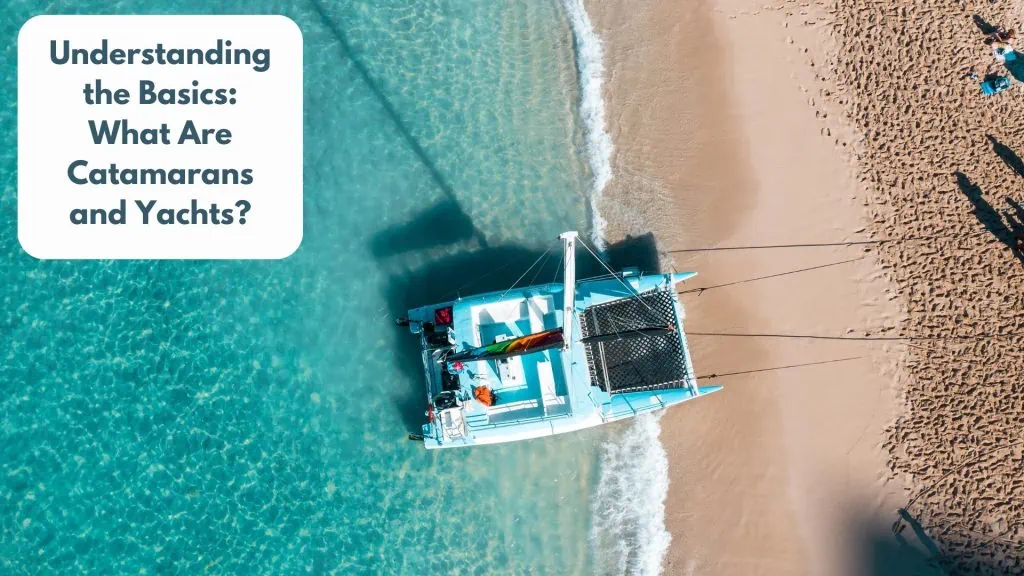
A catamaran is a type of multihull boat featuring two parallel hulls connected by a central deck. This twin-hull design provides more stability, expansive interior space, and shallow draft.
Yachts, on the other hand, have a single continuous hull and are known for their elegant aesthetics, lavish amenities, and versatility for long-range cruising.
Here’s a quick visual comparison of the general shapes and hull configurations:
| Category | Catamaran | Yacht |
|---|---|---|
| Hulls | Two parallel hulls connected by deck | Single continuous hull |
| Shape | Wider, more beamy | Sleeker, narrower |
| Stability | Very stable with minimal rolling | More susceptible to rolling motion |
| Draft | Shallow draft to get closer to shore | Deeper draft requiring deeper waters |
| Living Space | Very spacious, open floor plans | More confined spaces |
Catamarans typically range anywhere from 40 to 70 feet in length, while yachts can be as small as 30 feet or over 100 feet for superyacht models.
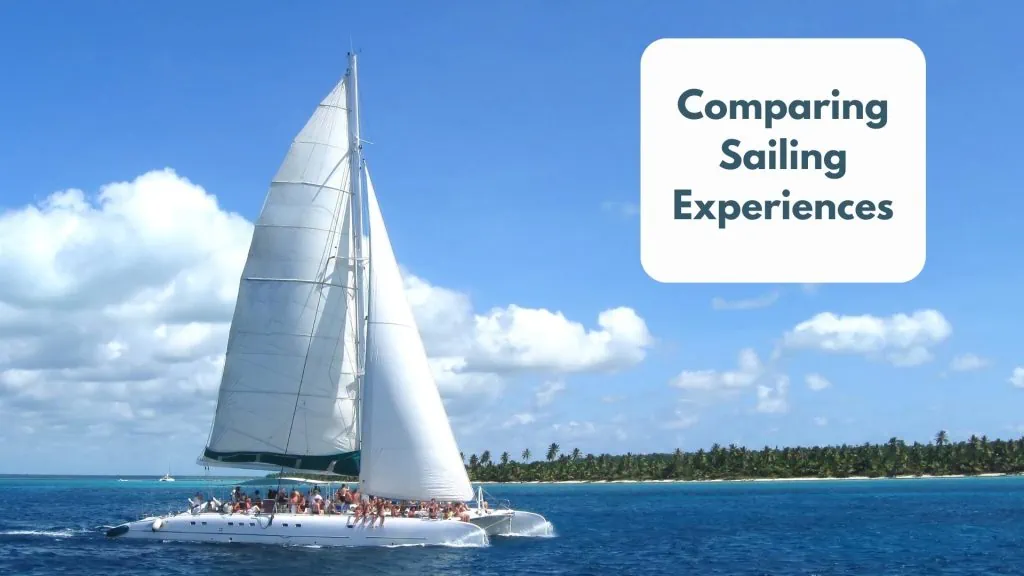
When it comes to maneuverability and sailing dynamics, there are some key distinctions between catamarans and yachts:
- Speed – Catamarans are lighter and have reduced drag, making them significantly faster than yachts. Top speeds can reach up to 25 knots.
- Stability – With their twin hulls, catamarans offer unmatched stability and minimal rocking motion in rougher seas. This also reduces seasickness.
- Maneuverability – Yachts take more skill to maneuver tight spaces, while catamarans can turn 360 degrees within their own length.
- Windward Performance – Yachts point higher into the wind and sail more efficiently upwind. Catamarans excel on reaches and downwind sailing.
So for performance-oriented sailing, monohull yachts have some advantages. But catamarans trade maneuverability for supreme stability and comfort on the water.
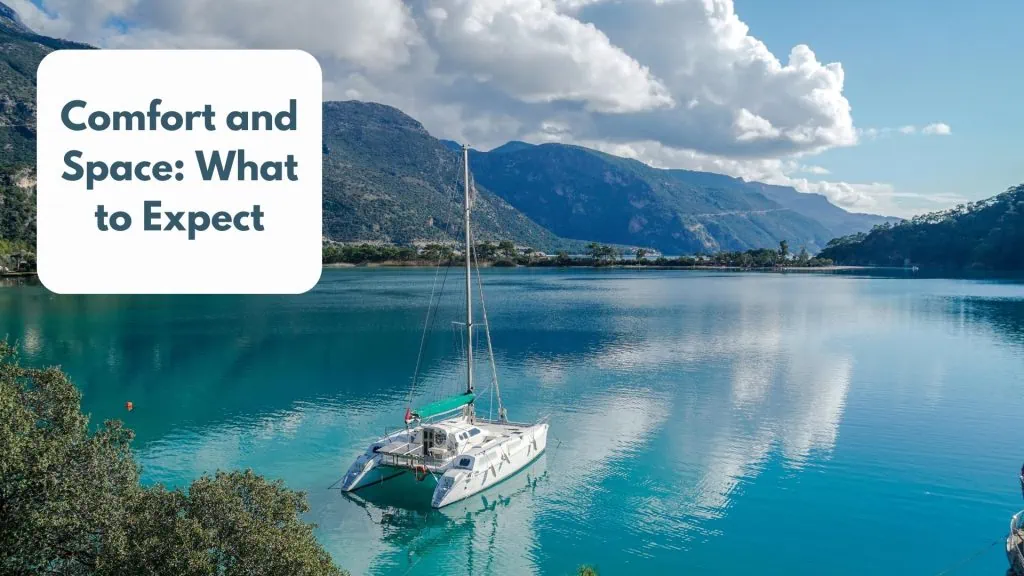
One major differentiation between these two boat types is the onboard living spaces and amenities. Some key comparisons:
- Deck Space – With their spacious bridge deck, catamarans offer ample lounging and relaxation space for large groups. Yachts have more confined deck space.
- Cabins – Catamaran cabins are typically larger and more comfortable. But yachts allow for more privacy when chartering with other couples or guests.
- Entertainment – Yachts focus more on lavish entertainment amenities like high-end sound systems, theaters, and bars. Catamarans offer more outdoor fun.
- Overall Comfort – For stability, living accommodations, and seasickness reduction, catamarans are vastly more comfortable boats.
So catamarans excel when it comes to providing generous living areas for group getaways and family vacations. But yachts are tailored more for couples charters and luxury amenities.
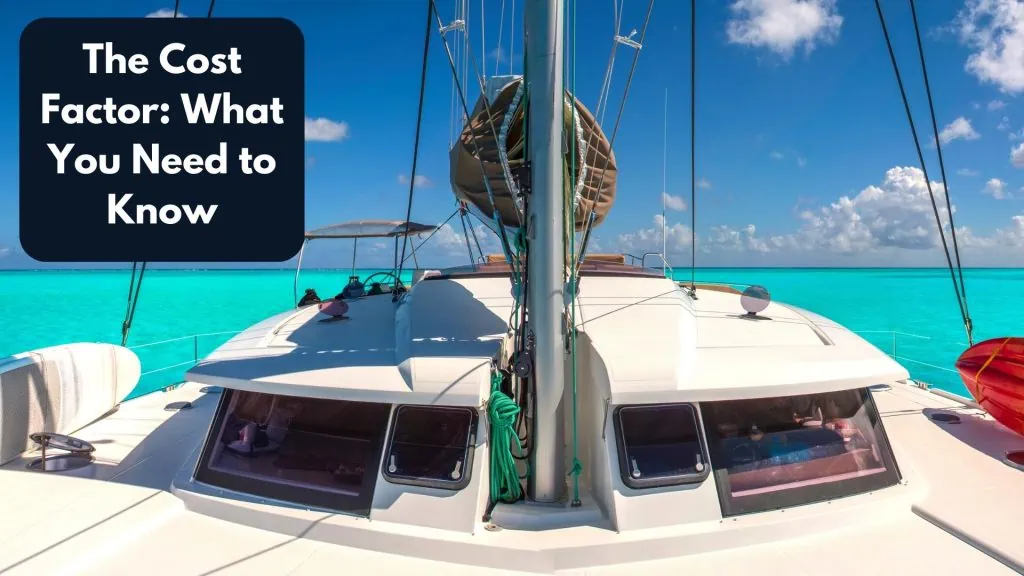
A significant factor to weigh is the overall ownership costs between catamarans and yachts:
- Purchase Price – Due to larger size and dual engines, catamarans come at a higher initial purchase cost. Yachts are more affordable for comparable lengths.
- Fuel Efficiency – With two engines to power, catamarans use almost twice as much fuel to operate. Yachts are more efficient.
- Docking and Marina Fees – Catamarans incur higher fees because they take up more dock space, especially in high-traffic areas.
- Maintenance – More complex systems and dual engines onboard catamarans equate to higher lifetime maintenance costs.
- Resale Value – Depreciation varies widely, but yachts tend to retain resale value better in the pre-owned market.
Clearly, the costs of owning and operating a catamaran are substantially higher compared to a similar-sized yacht. Being aware of these expenses will help determine the right boat for your budget.
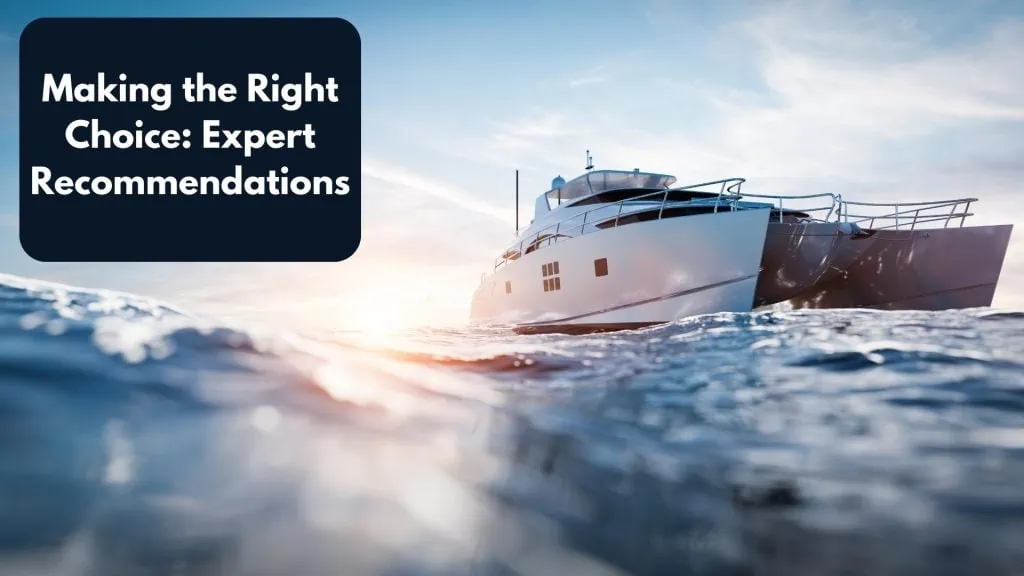
We’ve covered a lot of comparisons, so which boat type is the best choice? Here are some quick recommendations based on needs:
- For comfort, stability, and spaciousness on extended cruising trips – Catamaran
- For performance-focused sailing and nimble maneuverability – Yacht
- For luxurious amenities and entertaining small groups – Yacht
- For exhilarating speed and family-friendly features – Catamaran
- For affordable purchase and lower operating costs – Yacht
Of course, it depends on your individual priorities and boating style. Charter both for a test run to see which you enjoy more. At the end of the day, the right boat is the one that fulfills your needs and invites you to experience the magic of the open water.
Hopefully this guide has provided a helpful overview of the core differences between catamarans and yachts. Let the voyage begin!
- https://catamaranguru.com/catamaran-vs-monohull-we-changed-should-you/
- https://blog.cancunsailing.com/en/diferencia-entre-yate-y-catamaran
- https://www.mbcyachts.com/types-of-yachts-and-their-pros-and-cons/
- https://makaiyachts.com/power-catamaran-vs-monohull/
You might also be interested in reading:

The Top 3 Boat History Report Websites Reviewed

The Top 10 Best Boat Brands
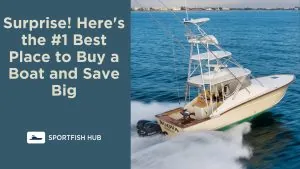
Best Place to Buy a Boat
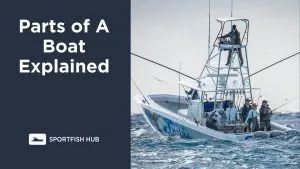
Parts of A Boat Explained
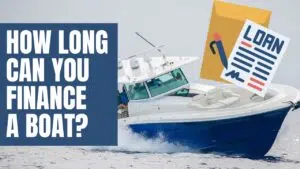
How Long Can You Finance A Boat

Steve Momot
Steve is an accomplished professional photographer and marketer who specializes in the Fishing, Yacht, and Boating industry. With a strong presence as an influencer and marketing expert in the Marine Industry, he has made a significant impact in the field. Additionally, Steve is the original creator and co-founder of Sportfishtrader. Prior to his career as a marine photographer, he gained extensive experience as a licensed boat and car dealer in South Florida.
Leave a Reply Cancel reply
Your email address will not be published. Required fields are marked *
You might also like.

Who Makes The Biggest Sport Fishing Boat?

Fishing Memes

What is Sportfishing?

Sportfish Hub was founded with a clear and unwavering mission in mind: To provide boaters and fishermen with the highest quality content, offering invaluable insights, tips, and resources.
- Terms of Service
- Privacy Policy
SOCial Media
Get in touch, © 2023 | all rights reserved.

Catamaran VS Sailboat, 9 Important Differences You Should Know!
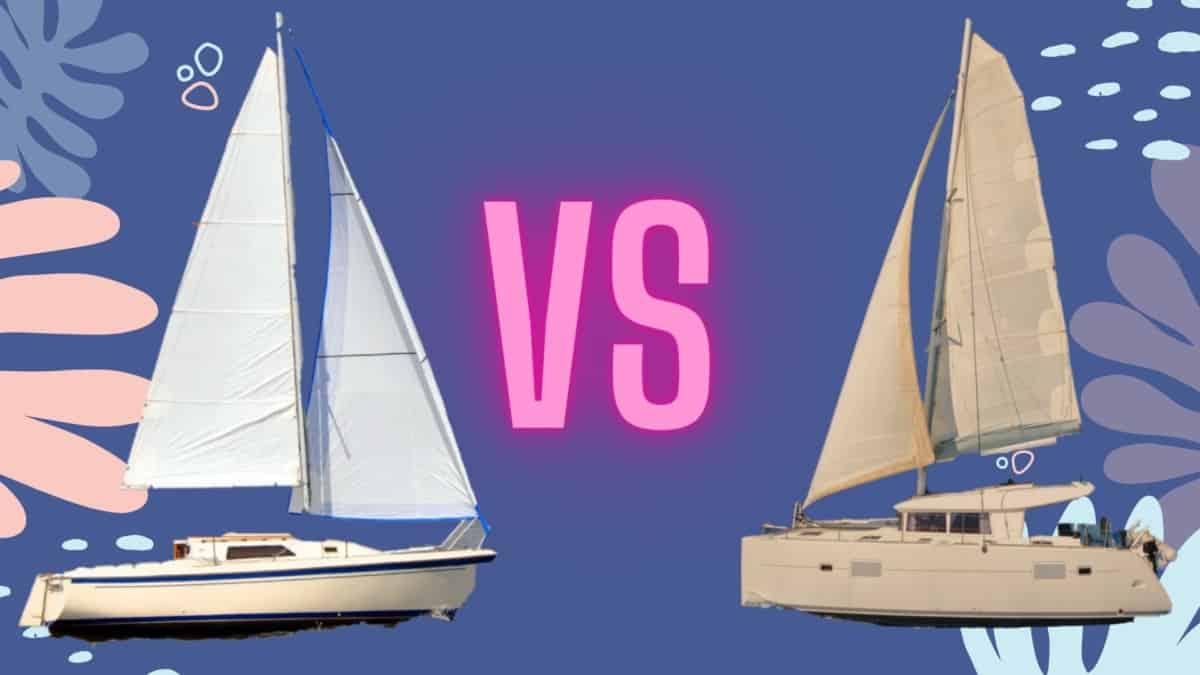
As an Amazon Associate, we earn from qualifying purchases. We may also earn commissions if you purchase products from other retailers after clicking on a link from our site.
This is one of the never-ending questions out there, catamarans vs. monohulls (also known by some just as sailboats). The discussions are wild and are, many times, really hard to follow unless you’re already a vivid sailor. By then, you probably already have your own opinion on what the differences are.
In this post, I’m trying to take a little more pragmatic approach to describe the 9 most important differences that I think you should know about.
Table of Contents
1. Catamarans Have Two Hulls, Sailboats or Monohulls Have One
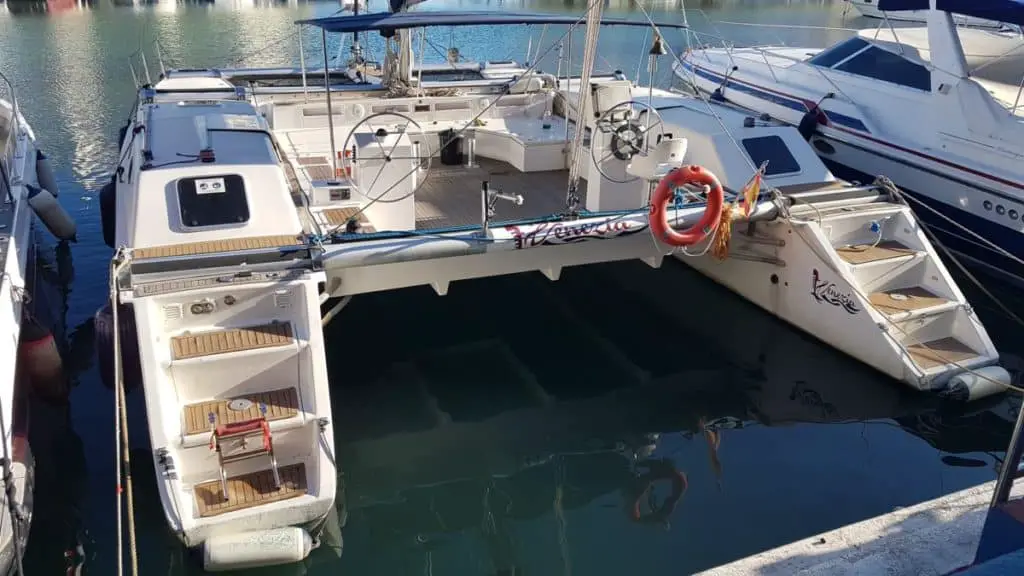
This is the most apparent feature that strikes you when you look at the two boats next to each other; one has two hulls, and the other only one. Mono, as you might know, means one (1).
Having two hulls also implies you need something that connects them, making the boat look a little bit like a manta ray, or is that only me?
2. Monohulls Will Rock From Side to Side
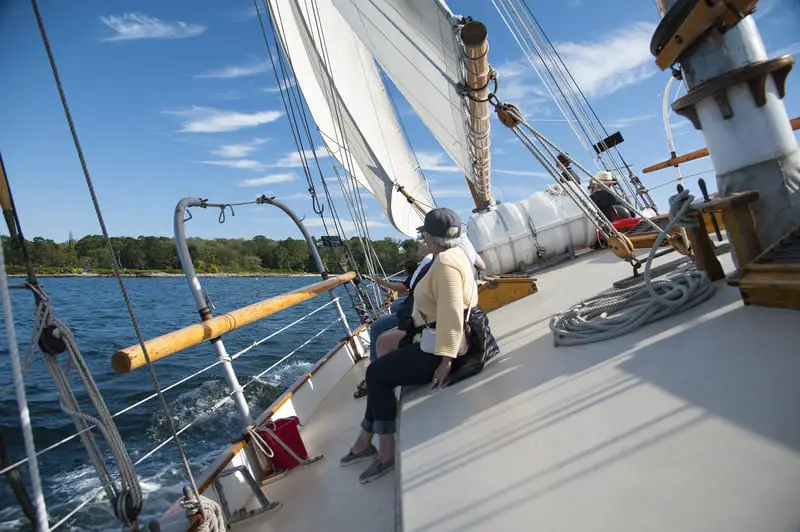
Catamarans don’t heel (leaning to its side in boat language). Therefore, they offer a very different sailing experience, which is more stable and usually more comfortable; this also applies when staying at anchor. The catamaran will move around with the wind, always staying flat, while the sailboat will rock from side to side and might even get you seasick .
This is especially noticeable when the wind is opposing the waves, making the boat have the wind pushing it from one side and the waves banging it from the other side. This makes for a very uncomfortable anchorage on a monohull. Basically, you are the iron, and the wind and wave are your hammer and anvil, not a perfect place to be.
3. Catamarans Offer More Space for the Same Length
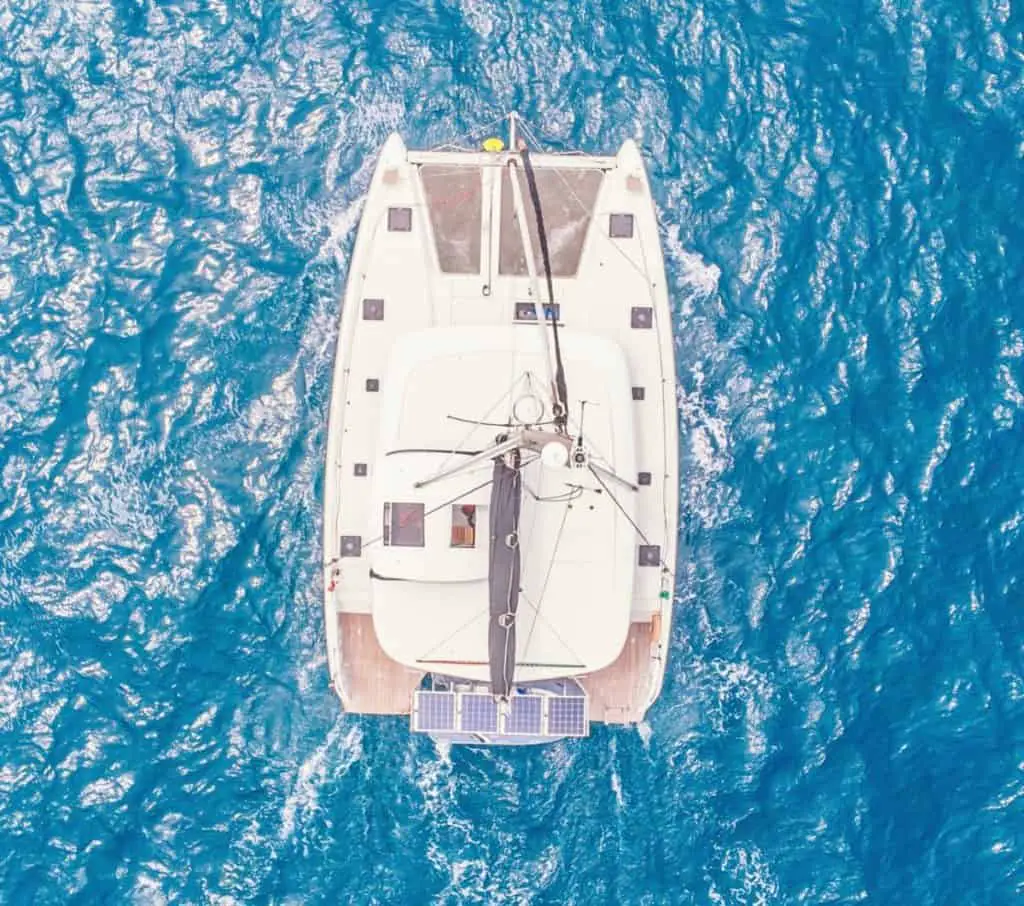
For the same length of boat, let’s say 40ft, you’re getting a lot more space on a catamaran. This is due to the two hulls, but also the big deck that attaches the hulls. There will also be even more space on the outside of the boat, both fore and aft of the mast. In between the bows, you will have either a solid deck or trampolines , which will greatly increase the space.
4. Catamarans Make Horrible Noises While Sailing Upwind
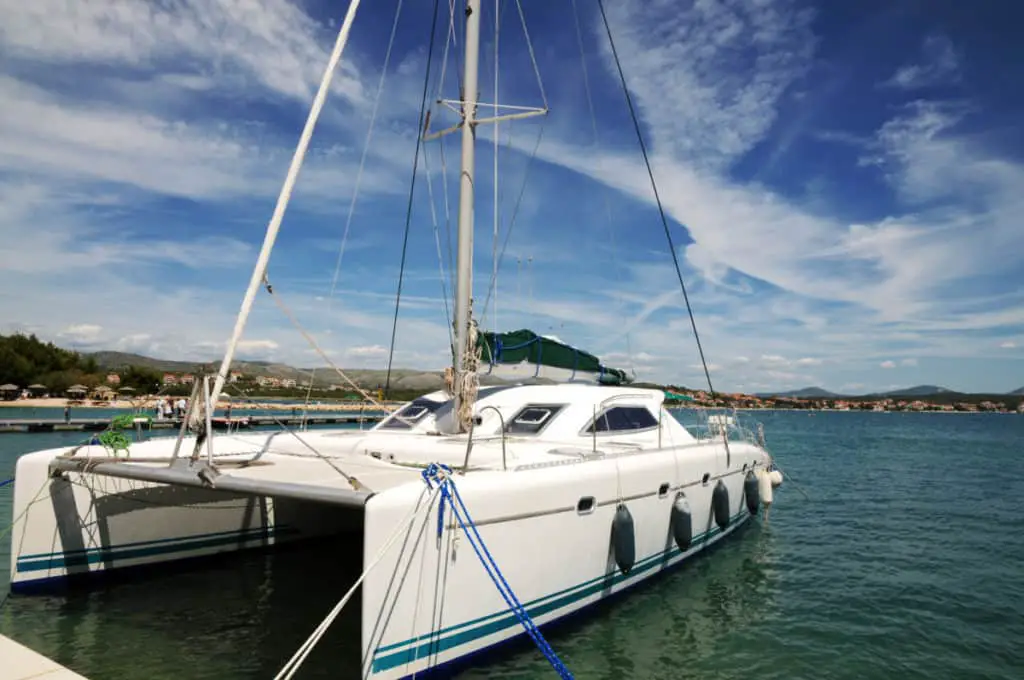
The distance between the water surface and the deck’s underside is called bridge deck clearance ; if it is not big enough, even small waves will start smashing into the underside.
This repeated cycle of waves hitting the boat does induce not only great noise but also a lot of vibrations and discomfort to the crew.
This problem is something that just doesn’t exist on monohulls (only one hull) and also is a strong argument from those who prefer monohulls.
The noise might not be a big deal when traveling coastal waters for a few hours a day, but consider going days on end straight into the wind, hearing that banging noise, ad a little motion sickness, and you will pretty soon wish you were on a monohull 🙂
5. Monohulls Are Slower Than Catamarans
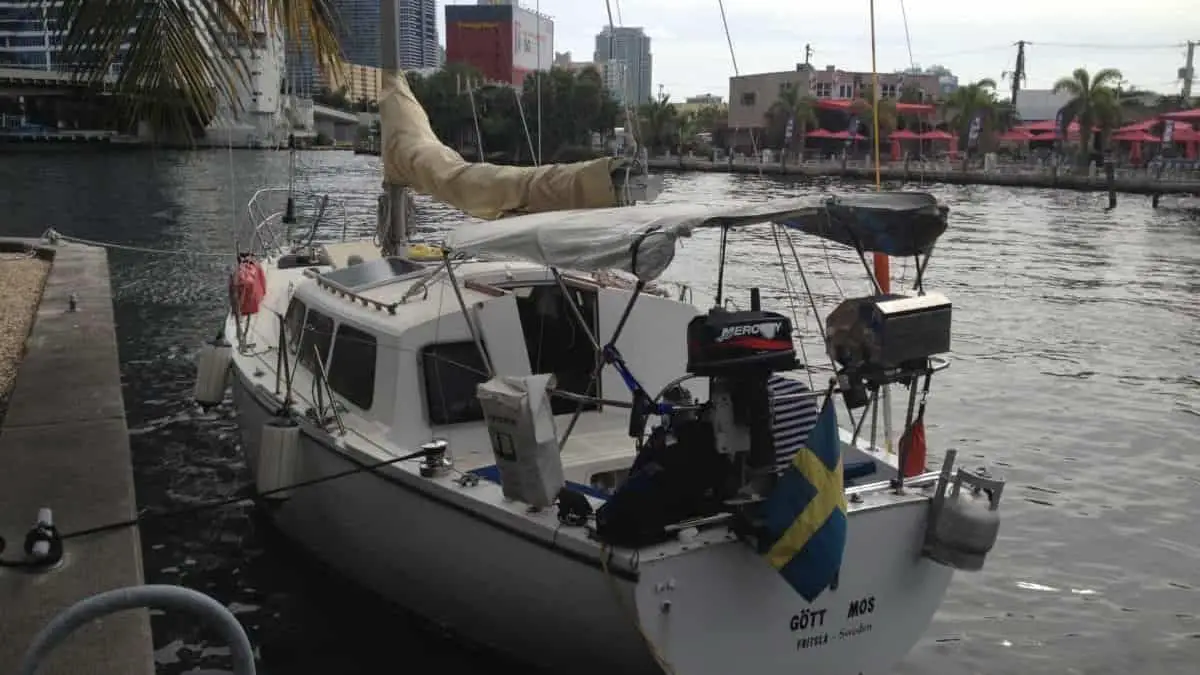
At least that is the short answer, this applies if we only compare the length of the boat, but if we compare the total length in the water, it’s a different story. Much of this speed comes from the decreased drag, bigger sails, and a catamaran’s lesser weight.
Here are some articles when you want to better understand catamaran speed:
- Cruising catamaran speed
- Fastest cruising catamarans
- Catamaran hull speed calculator
- Are trimarans even faster than catamarans?
- 20 Performance cruising catamarans
6. Catamarans Offer Less Helm Feedback
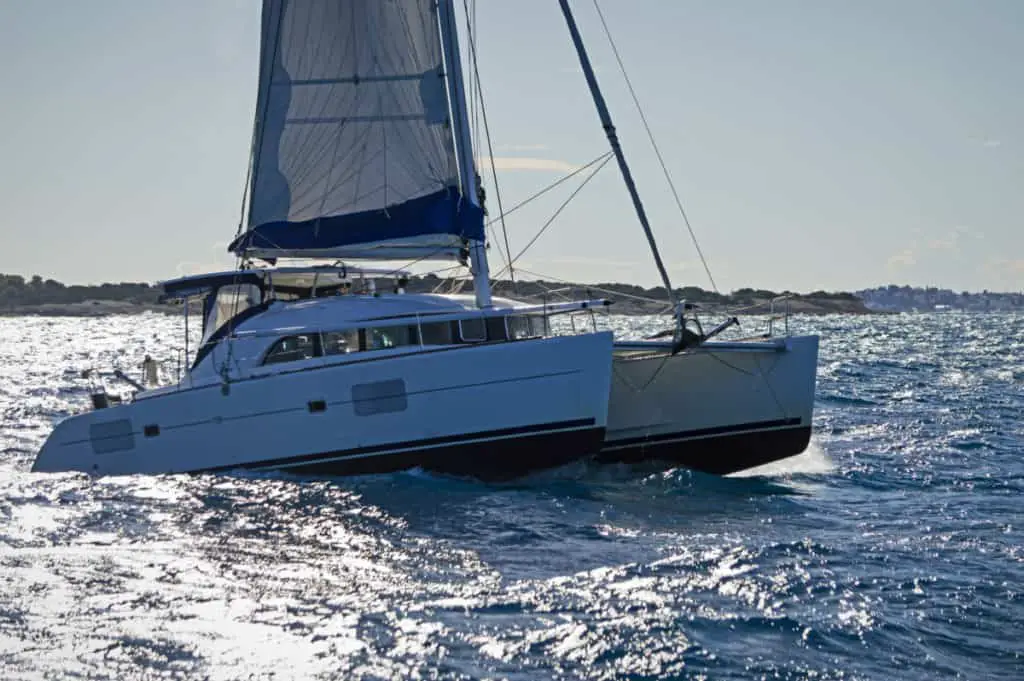
One big benefit of having a boat that heels is that it’s a great way to get feedback on whether or not the boat is overpowered. Since a catamaran stays flat, it is harder for a new captain to understand when to reef.
This could be a safety issue for those transitioning from monohulls to catamarans, which I believe is the most common way people acquire a catamaran.
7. Monohulls Are Harder to Dock
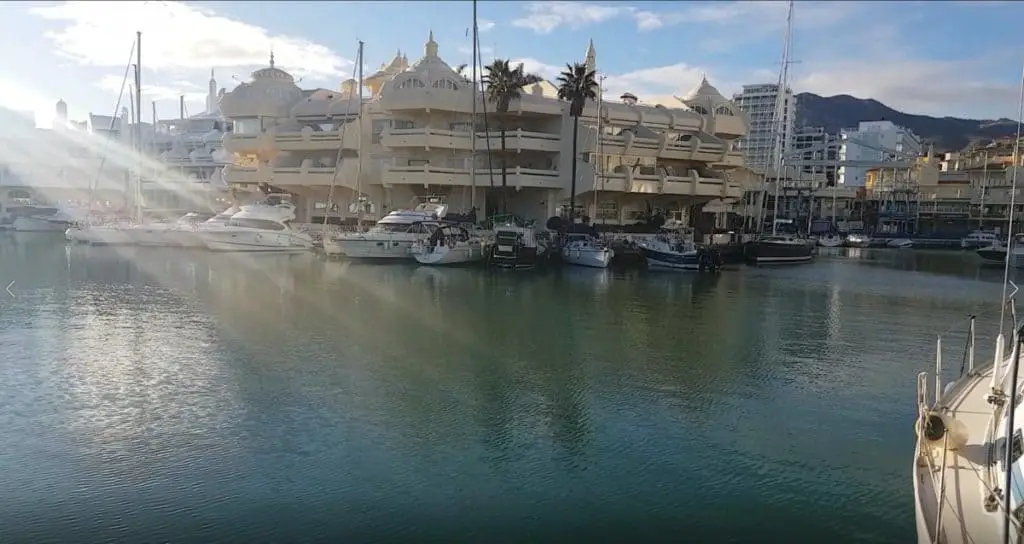
For a monohull to turn, it needs enough water passing around the rudder; for enough water to pass around the rudder, the boat needs to be moving. So this means once you stop your boat, you can’t turn; the things that move you are the wind and the current. This is the tricky part with a monohull, the timing needs to be perfect, or you’ll either go too fast and hit the dock, or you’ll go too slow and drift away.
On a catamaran, that’s different, you see; now you have two engines, much like a battle tank, you can now make a 360 turn on the spot. This means you can do a full stop, put one engine in forward and one in reverse, making the boat spin on its axis. That’s great! I wish my car would do that.
8. Catamarans Are More Fuel-Efficient
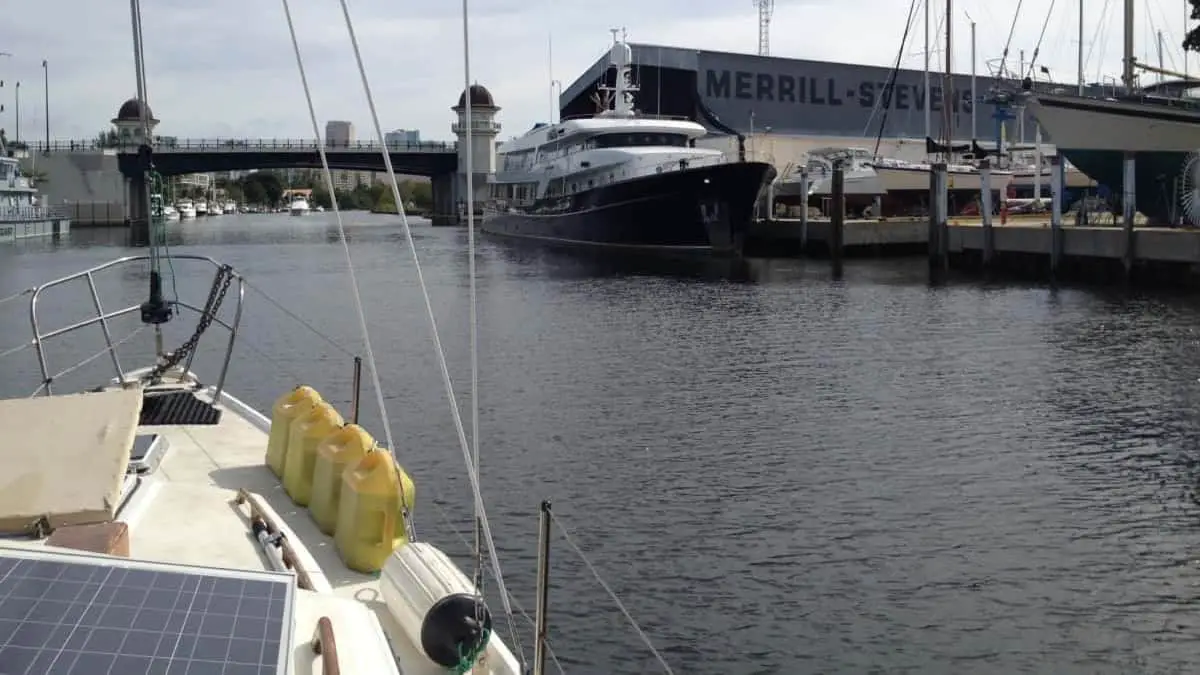
Saying a catamaran is fuel-efficient is like saying your Ford F150 truck is fuel-efficient. But, in comparison to its one-hull brother, it’s true, this really needs a lot more explanation for it to be a fair comparison, but only considering the lengths of the boat, the catamaran will consume less fuel.
This is mostly a consequence of the less drag a catamaran has since the weight is distributed over a greater area.
- Catamaran fuel efficiency data contributed by owners
- Electric vs gas: outboard engines. Which is the best?
9. Catamarans Offer More Comfort
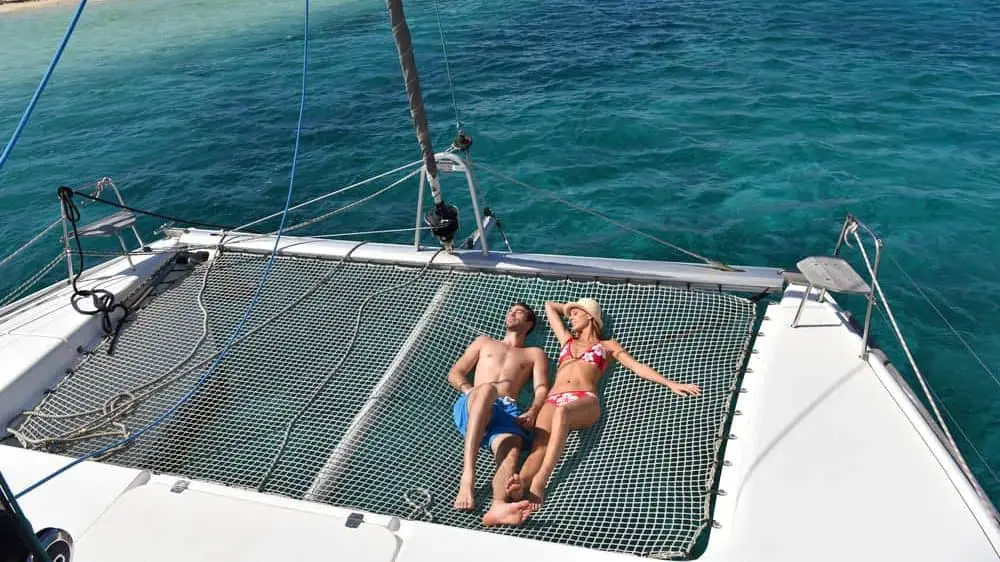
Since catamarans have more space and don’t heel as much, they offer a more comfortable experience. One beautiful aspect of having a big deck is that you can hang out in the trampolines; they are basically two big hammocks, and since hammocks already are great, putting them on a boat makes them awesome.
And since it doesn’t heel, you can also freely move around on the boat without spilling your drink or being at risk of falling overboard. This also means that going inside to cook is a treat since you don’t have to cook while trying not to fall over.
Looks and Other Factors
All in all, catamarans are great, but so are monohulls; there are also many other factors that I haven’t mentioned yet; these are mainly factors of the heart.
Many people feel that it isn’t real sailing if it isn’t done like it was in the good old days, heeling over and all. And to some extent, I can totally agree with that, but on the other hand, enjoying those two trampolines while on a sunny weather cruise down the bay is something I can’t forget.
And also the looks, catamarans look great; I think they look and almost move like those manta rays you can see down in the Bahamas. On the other hand, there is not much cooler than seeing a solid old monohull dig deep into the waves and go almost straight into the wind; what a feeling!
What do you think?
Owner of CatamaranFreedom.com. A minimalist that has lived in a caravan in Sweden, 35ft Monohull in the Bahamas, and right now in his self-built Van. He just started the next adventure, to circumnavigate the world on a Catamaran!
Leave a Reply Cancel reply
Your email address will not be published. Required fields are marked *
Save my name and email in this browser for the next time I comment.
Recent Posts
Must-Have Boat Gear for Catamaran Sailors!
Sailing is probably the most gear-intensive activity I've ever done; there are so many decisions to be made about what gear to buy now, for tomorrow, and what to definitely never buy. The gear on...
6 Best Trailerable Trimarans For Bluewater and Coastal Sailing
Having a boat costs a lot of money, even when you are not using it, marina fees, etc. And once it is in the water most sailors never go very far from their "home marina" and sailing will be somewhat...
Catamaran vs. monohull: Navigating the waters in style and comfort
- Catamaran vs. Monohull: Navigating the waters in style and comfort
Embarking on a journey across the open waters has long captured the human spirit of adventure. The realm of sailing offers a plethora of options, each delivering its own unique experience. Among these, catamaran sailing stands out as a modern and luxurious way to navigate the seas. In this article, we delve into the world of catamaran sailboats, compare them to monohull counterparts, and help you discover the ideal choice for your maritime dreams.
Unveiling catamaran sailboats
Catamarans, known for their twin hulls and spacious decks, have redefined the sailing experience. These impressive vessels offer stability, ample space, and a comfortable layout, making them a favorite among sailing enthusiasts. Whether you're a seasoned sailor or a beginner, a catamaran promises a remarkable adventure on the water.
The thrill of sailing a catamaran
Sailing a catamaran brings a new level of excitement. The feeling of gliding through the water with minimal heeling is exhilarating. The wide deck areas provide plenty of space for relaxation, sunbathing, and socializing. Catamarans are also well-equipped with modern amenities, ensuring a comfortable journey.
Read our top notch articles on topics such as sailing, sailing tips and destinations in our Magazine .
Monohull sailboats: A classic choice
Monohull sailboats, with their single hull design, embody tradition and elegance. These boats are known for their responsiveness to wind and waves, offering an authentic sailing experience. While they may have less space compared to catamarans, their sleek design and maneuverability make them a beloved choice for purist sailors.
Choosing between catamaran and monohull
Deciding between a catamaran and a monohull often boils down to personal preferences. Catamarans excel in stability and space, making them suitable for larger groups and extended trips. Monohulls, on the other hand, offer a classic sailing feel and perform well in various weather conditions. Consider your priorities and the type of adventure you seek.
Sailing catamaran: A luxurious experience
Catamarans offer more than just a sailing experience; they provide a luxurious way to explore the waters. With spacious cabins, well-appointed kitchens, and modern bathrooms, catamarans feel like floating vacation homes. The comfort and opulence they offer have elevated the world of maritime leisure.
Navigating choppy waters: Monohull vs. catamaran
In rough seas, the design of a catamaran shines through. Its twin hulls provide excellent stability, reducing the rocking motion common on monohulls. If comfort during challenging weather is a priority, catamarans have a clear advantage.
Sailboat catamaran: Best of both worlds
For those who desire a mix of tradition and modernity, sailboat catamarans offer the best of both worlds. These vessels combine the classic aesthetics of monohulls with some of the space advantages of catamarans. Sailboat catamarans cater to sailors who value both performance and comfort.
Setting sail: Monohull yacht adventures
Monohull yachts, especially those designed for racing, offer a thrilling experience on the water. The feeling of harnessing the wind's power to glide through the waves is unparalleled. Monohull yachts are favored by competitive sailors and those who relish the art of traditional sailing.
Exploring the multihull sailboat
Beyond catamarans, the realm of multihull sailboats includes trimarans, which have three hulls. Trimarans offer a unique combination of stability and speed, making them suitable for both leisurely cruises and exhilarating races. They are perfect for those seeking a balance between comfort and performance.
Catamaran sailing yachts: Unmatched elegance
Sailing yachts built on the catamaran platform exude elegance and sophistication. These vessels are designed to provide a lavish experience, with spacious cabins, gourmet kitchens, and lavish lounging areas. Catamaran sailing yachts redefine luxury living on the open sea.
Catamaran landing near Anse Severe on La Digue Island, Seychelles
Monohull vs. multihull: Making the right choice
Choosing between a monohull and a multihull depends on your preferences and intended use. Multihulls, including catamarans and trimarans, offer stability and space. Monohulls provide a classic sailing feel and are favored by those who appreciate tradition. Consider your priorities and aspirations to make an informed decision.
Catamaran sailing safety and tips
Safety is paramount when sailing, regardless of the vessel type. Catamarans' stability reduces the risk of capsizing, but it's essential to follow safety guidelines and weather forecasts. Proper training, regular maintenance, and responsible navigation contribute to a safe and enjoyable sailing experience.
Catamaran sailing offers a blend of luxury, comfort, and adventure on the open waters. Monohulls continue to captivate with their classic charm and sailing prowess. Both options cater to different tastes and aspirations, ensuring that the world of sailing remains diverse and inviting.
So what are you waiting for? Take a look at our range of charter boats and head to some of our favourite sailing destinations .
FAQs about catamaran vs. monohull
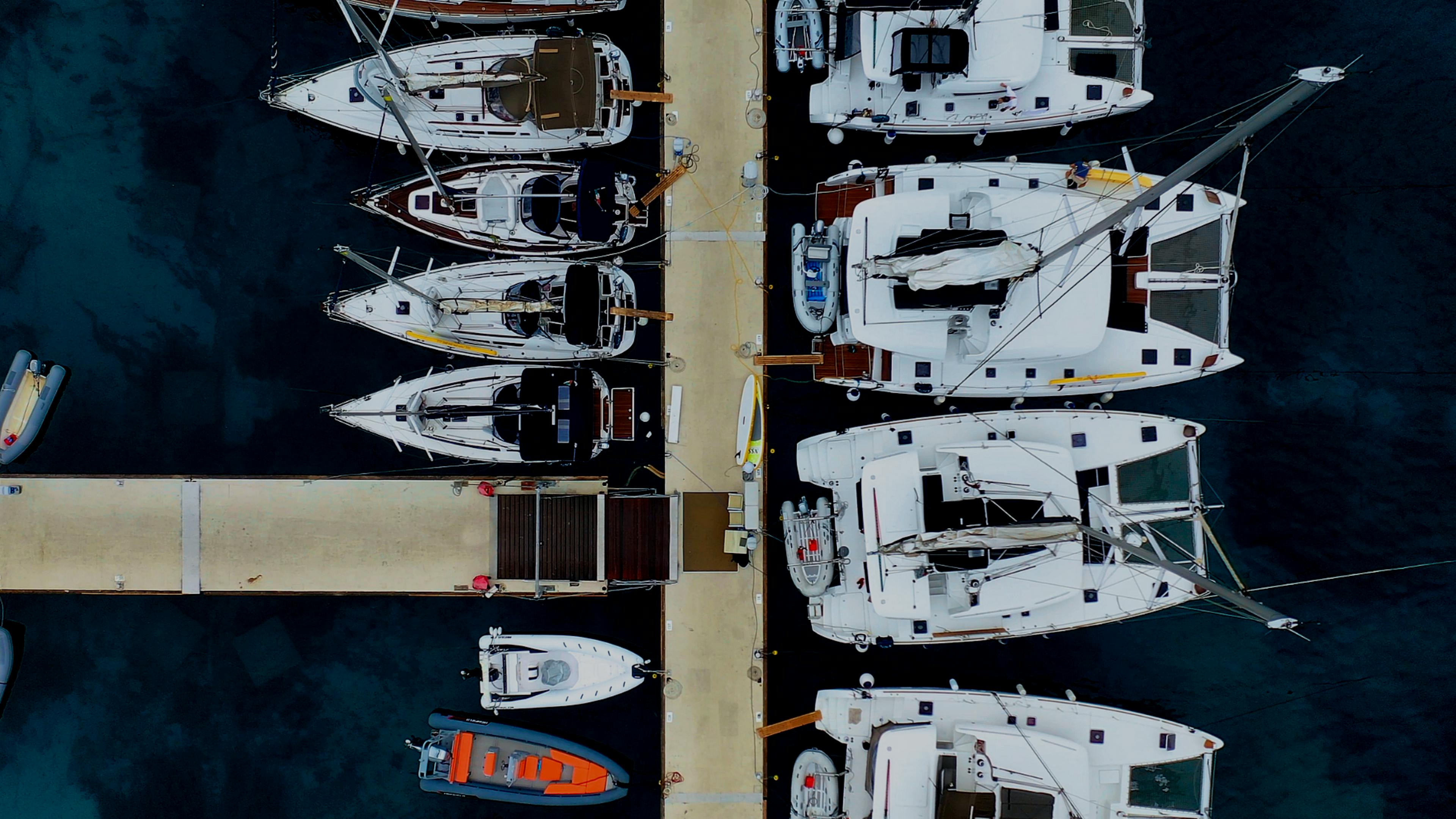
- What's the difference between a catamaran and a sailboat?
A comprehensive guide to help you choose the best boat for your next holiday
- Boat Models
Get ready to embark on a sea-faring adventure with us as we unveil the unique charms of catamarans and sailboats—the rockstars of luxury on the water. While we usually dive deep into the world of sailboats, we can't resist sharing the laid-back vibes and the comfort you'll find inside a catamaran.
By zooming in on the differences, we're handing you the ultimate tool to pick out the perfect yacht for your holiday. Ready to set sail? Let's navigate the cozy corners and sail smoothly through the captivating world of catamarans and sailboats. Your ideal yacht escapade is within reach, and understanding these nuances is the compass that will steer you toward the perfect maritime retreat. Cheers to smooth sailing!
Yacht Charter: Book your holiday with Sailogy!
➡️ sailboat rental, ➡️ catamaran rental, what is the difference between a catamaran and a sailboat sailogy comparison, can a catamaran sail rough seas, what is the difference between a sailing catamaran and a power catamaran, are catamarans faster than sailboats, are catamarans harder to sail.

Sailboat vs Catamaran Comparison
1. stability:.
- Sailboat: Embraces the classic elegance of a single hull, providing a responsive and traditional sailing experience. The tilting motion, counterbalanced by the daggerboard, adds a dynamic element to the journey.
- Catamaran: Boasts unparalleled stability with its two hulls, virtually eliminating the pronounced tilting effect. The absence of deep keels and ballasts enhances agility and lightness, offering a smoother ride. Ideal for those who are prone to experiencing a bit of seasickness!
- Catamaran: Defines spaciousness, providing individual cabins with dedicated bathrooms. The square-shaped dinette mirrors domestic proportions, and the substantial, well-equipped cockpit encourages social gatherings.
- Sailboat: Offers a cozy and intimate setting, utilizing space efficiently. While cabins may be more compact, the sailboat's design fosters a close-knit atmosphere among passengers.
- Catamaran: Impresses with a wide footprint, enhancing onboard living space and comfort. The challenge lies in marina space during peak seasons, offset by the freedom to enjoy extended periods aboard without the need for frequent shore visits.
- Sailboat: Navigates marinas with ease due to its narrower profile. While confined space might limit interior room, the sailboat's ability to find berths becomes advantageous during bustling harbor seasons. It's worth noting that this characteristic can vary depending on the model; for instance, new models such as the Bavaria C38 or the Dufour 44 (premiered in Düsseldorf and soon available) feature generous beams, providing more space, especially in the main front bedroom, and creating a general feeling of larger spaces, even on the deck.
4. All on the Same Level:
- Catamaran: Integrates the dinette and cockpit seamlessly, creating a harmonious, unified space with a transparent sliding wall. Visual continuity fosters a connected and inclusive experience among guests.
- Sailboat: Embraces a more compartmentalized layout, allowing for distinct areas that cater to different activities. This provides passengers with varied environments throughout the vessel.
5. Manoeuvrability:
- Catamaran: Exhibits impressive maneuverability, thanks to two engines that facilitate precise control in tight spaces. The ability to turn within its own axis is particularly advantageous in crowded harbors.
- Sailboat: Requires careful and deliberate maneuvering in harbors due to its single engine. While agility might be reduced, the sailboat's sailing capabilities shine when navigating open waters.
6. Speed and Sailing:
- Catamaran: Hydrodynamically efficient hulls offer superior speed, especially in upwind sailing conditions. The catamaran excels in providing a swift and enjoyable journey, minimizing the impact of adverse weather.
- Sailboat: Demonstrates versatility in sailing conditions, adapting well to upwind challenges. While not as inherently fast as a catamaran, the sailboat's overall speed ensures an engaging sailing experience.
7. Comfort on Board:
- Catamaran: Appeals to first-time sailors seeking a home-like experience. Offers disengaged and domestically oriented spaces, ensuring privacy between hulls—a valuable feature for those with varying daily routines or sailing with a skipper or children.
- Sailboat: Fosters a more communal atmosphere, ideal for passengers who enjoy close interaction. The sailboat's compact layout promotes shared experiences among travelers.
8. Autonomy:
- Catamaran: Slightly compromised autonomy due to weight sensitivity. Limited fuel independence and water reserves necessitate more thoughtful planning. The presence of two engines enhances maneuverability, allowing for precise navigation.
- Sailboat: Excels in fuel autonomy, providing extended sailing periods without the need for frequent refueling. A single-engine simplifies maintenance and promotes straightforward, self-sufficient voyages.
9. Organisation of Space:
- Catamaran: Typically designed with a standardized layout, catamarans for charter often feature two cabins in each hull, strategically positioned at the extreme bow and stern. This layout, with two bathrooms centrally located, offers a consistent and practical accommodation setup. Innovative models feature an exterior galley integrated into the cockpit, providing a unique blend of space and functionality.
- Sailboat: Boasting a more versatile structure, sailboats come in various layouts to cater to diverse preferences. Modern designs challenge traditional constraints with generous beams. This not only enhances interior space, especially in the main front bedroom but also creates a broader and more open atmosphere on the deck. The flexibility in cabin arrangements allows for a personalized and comfortable sailing experience, accommodating different preferences and needs. Ultimately, the organization of space on a sailboat is influenced by the specific model chosen, allowing for a tailored approach to onboard living.

Catamarans excel in rough seas, thanks to their twin-hull design providing enhanced stability and reduced heeling compared to monohull sailboats. The unique architecture allows for increased speed and maneuverability, making them efficient in navigating challenging conditions.
Key to their rough-sea capabilities is the bridge deck —the space between the hulls—featuring ample clearance in well-designed catamarans. This minimizes slamming, enhances seaworthiness by reducing structural stress, and ensures a smoother ride in turbulent sea states.
While catamarans can capsize in extreme situations, proper design, operation, and the skill of an experienced captain contribute to their overall capability in handling a variety of sea conditions, ensuring a secure and enjoyable sailing experience, even in rough seas.
A sailing catamaran and a power catamaran differ primarily in propulsion . A sailing catamaran relies on sails, offering a traditional experience with stability and efficiency. In contrast, a power catamaran uses engines, emphasizing speed and ease of handling. Power catamarans are chosen for faster cruising and covering more miles.
Catamarans are often considered faster than monohull sailboats due to their hydrodynamic design . With two hulls providing stability, reduced drag, and a wider beam for efficient sailing angles, catamarans excel in speed. However, sailboats showcase versatility, excelling in certain conditions such as upwind sailing. Overall speed comparison depends on various factors, including design and wind conditions.
Sailing a catamaran is often seen as less challenging for beginners due to inherent stability and reduced heeling. The dual-hull design provides balance, making catamarans forgiving in terms of capsizing. While novices appreciate stability, adjustments are needed for maneuvering and handling increased windage. Proficiency comes with practice, and experienced sailors may find catamarans offer a refreshing change in sailing dynamics.

Discover our favorite yachts
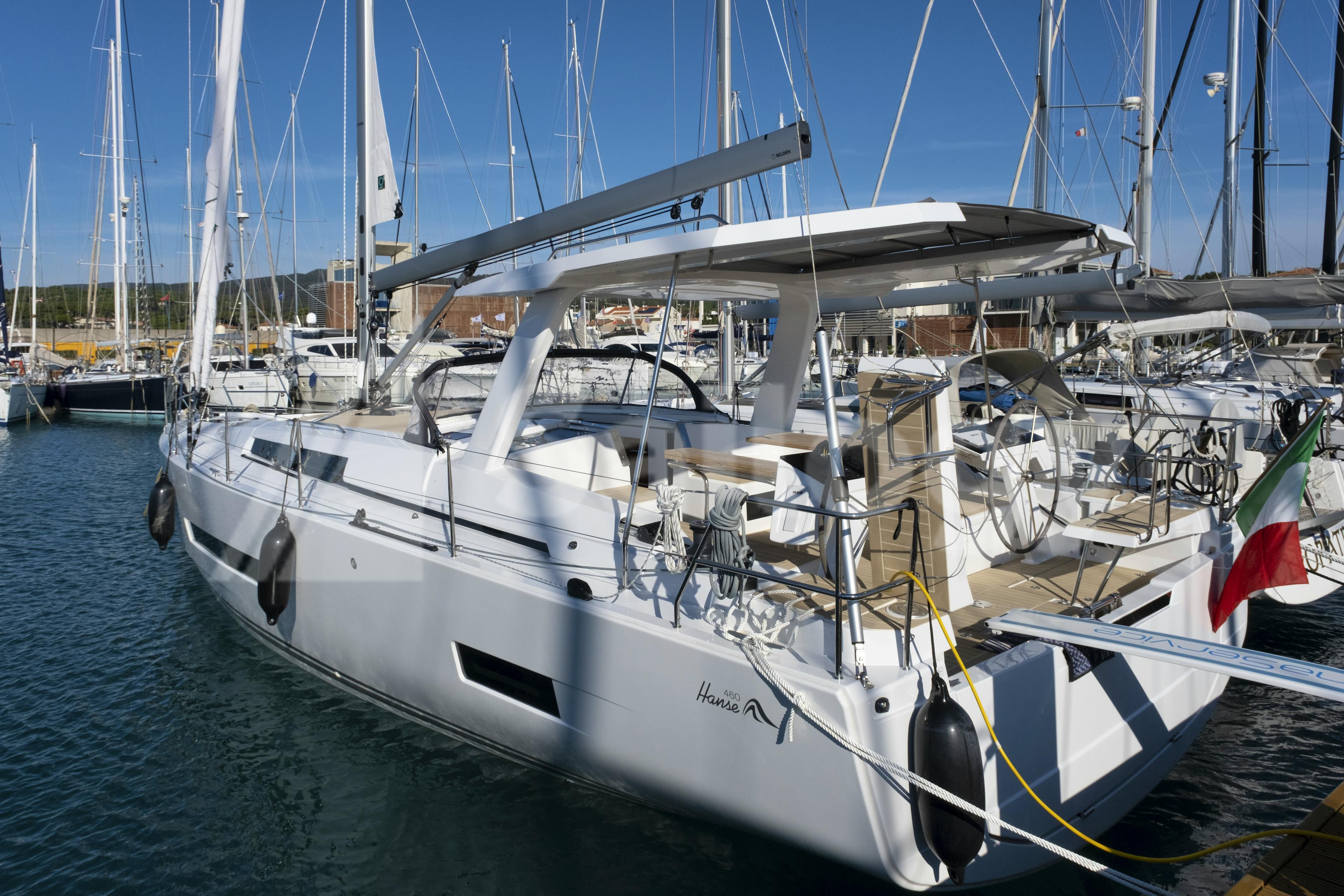
- Sailing boat
Castiglioncello, Tuscany
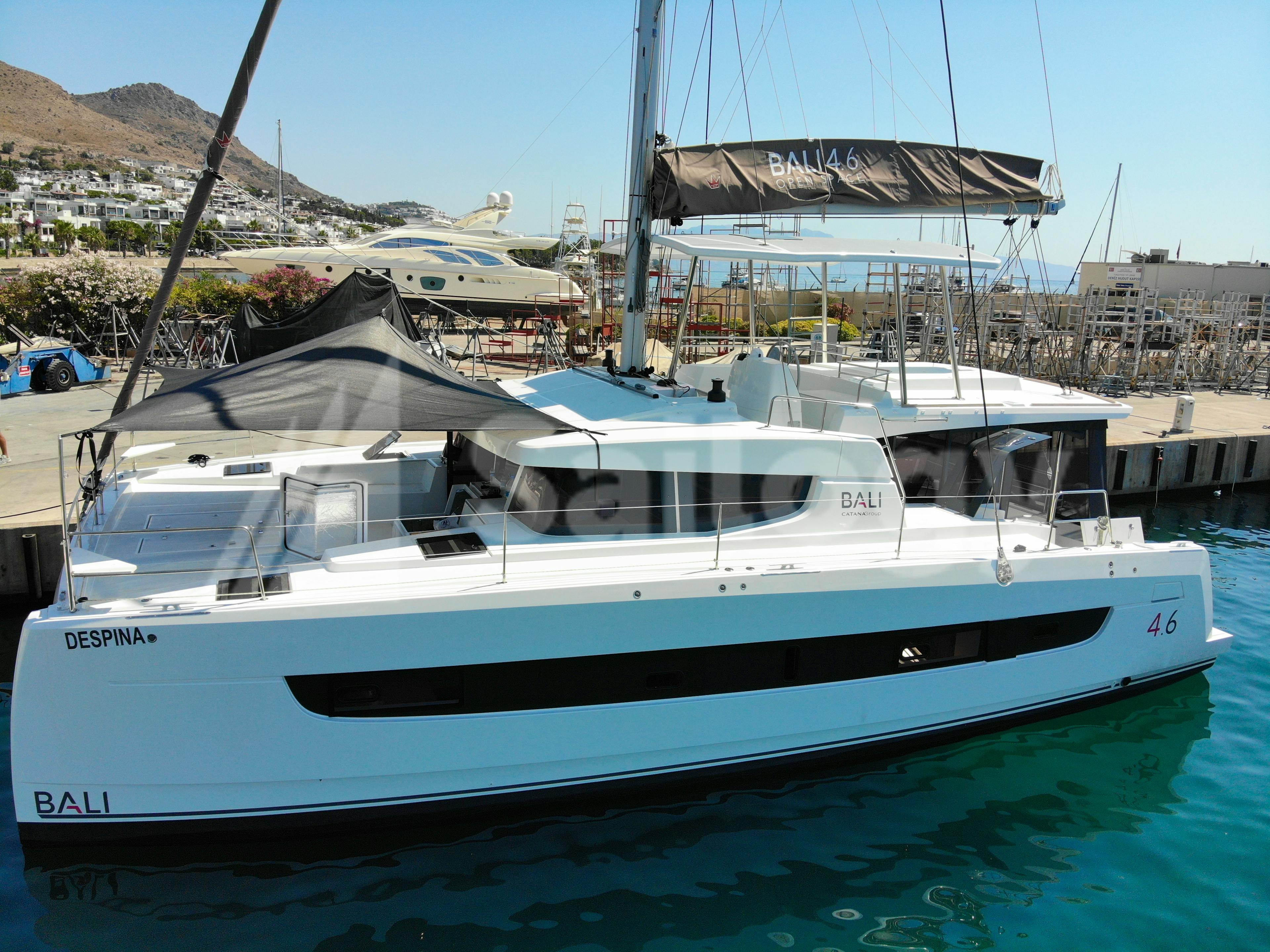
Gocek, Turkish Coast
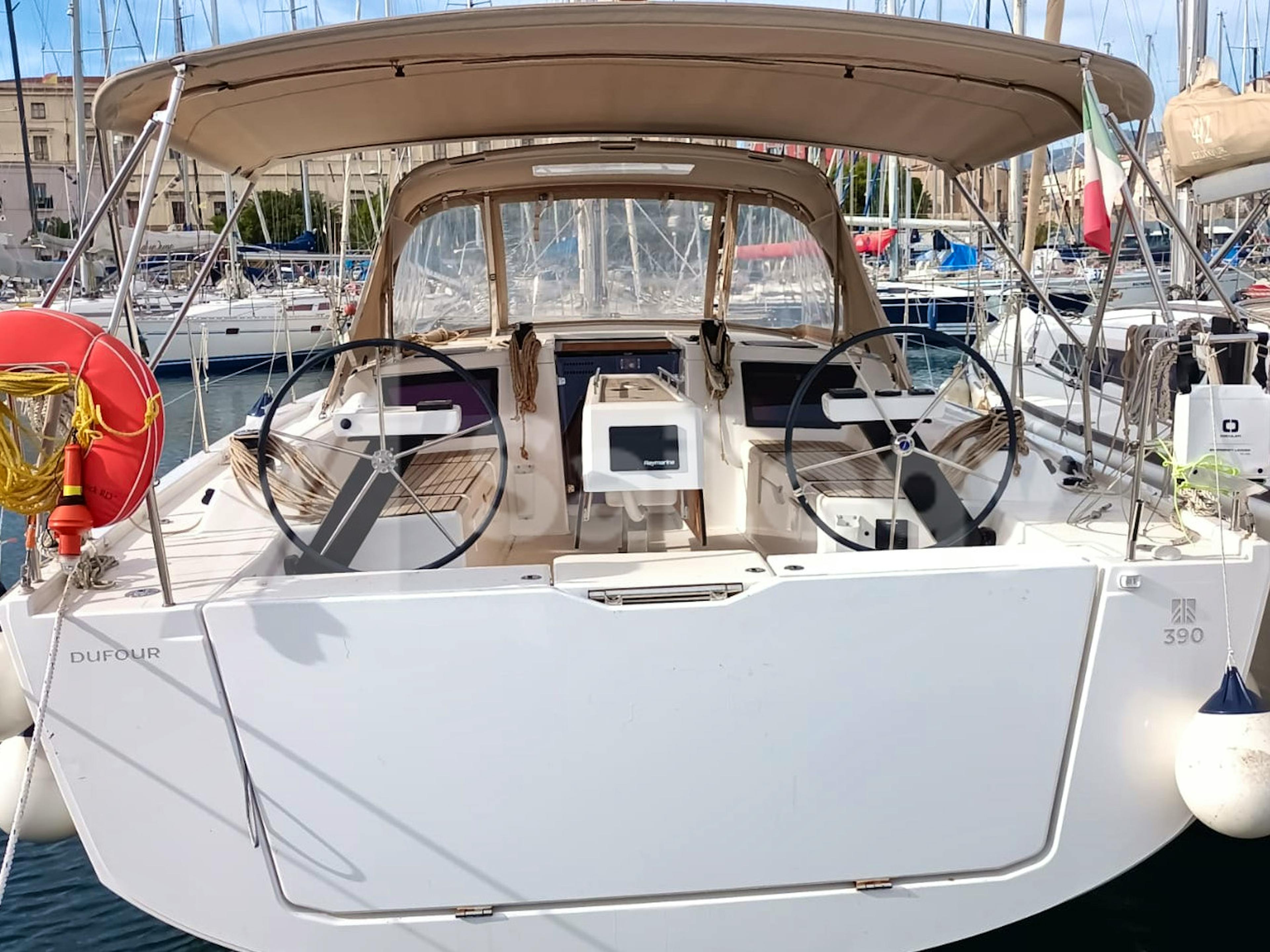
Dufour 390 Grand Large
Palermo, sicily.
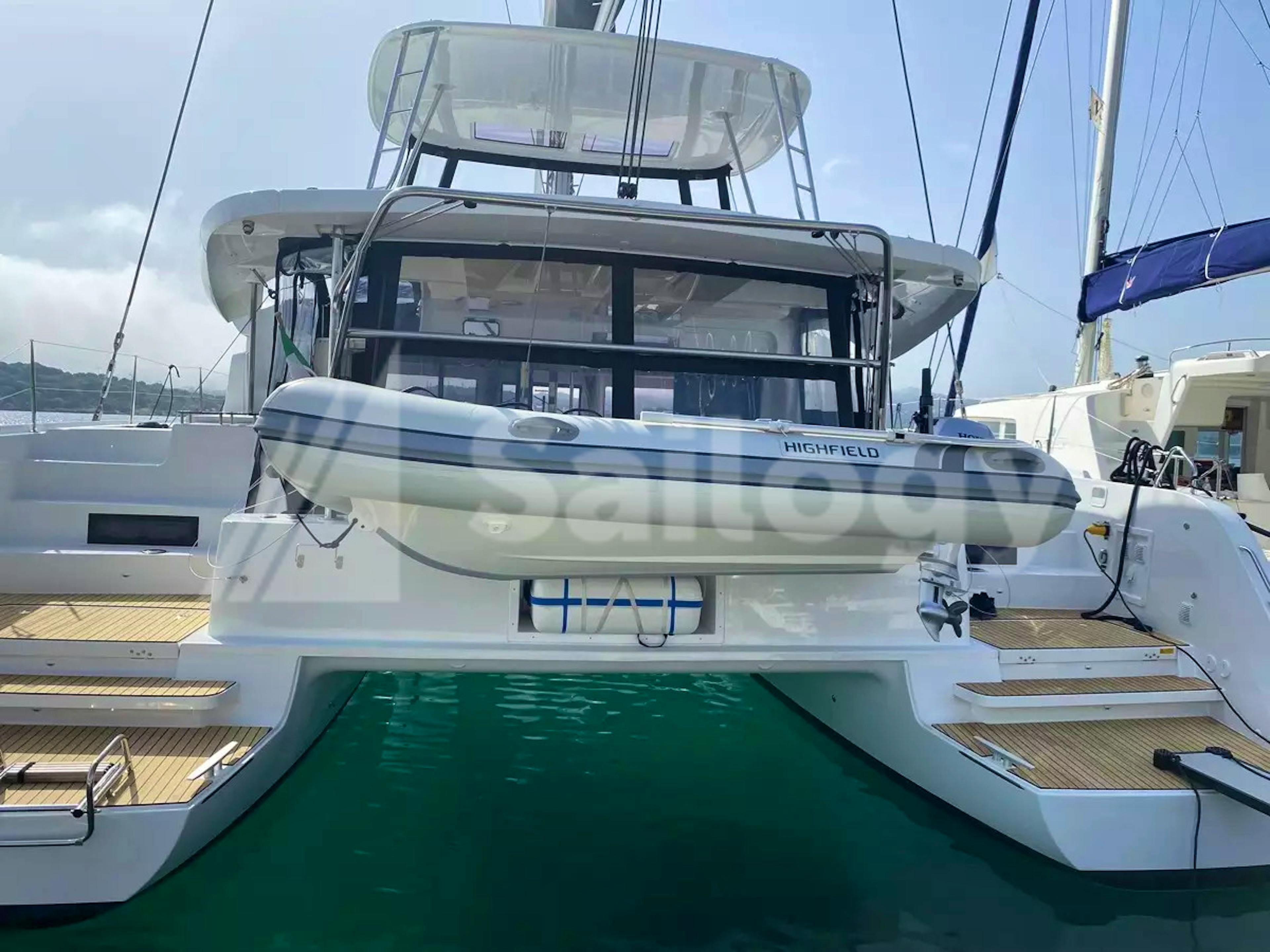
Portisco, Costa Smeralda
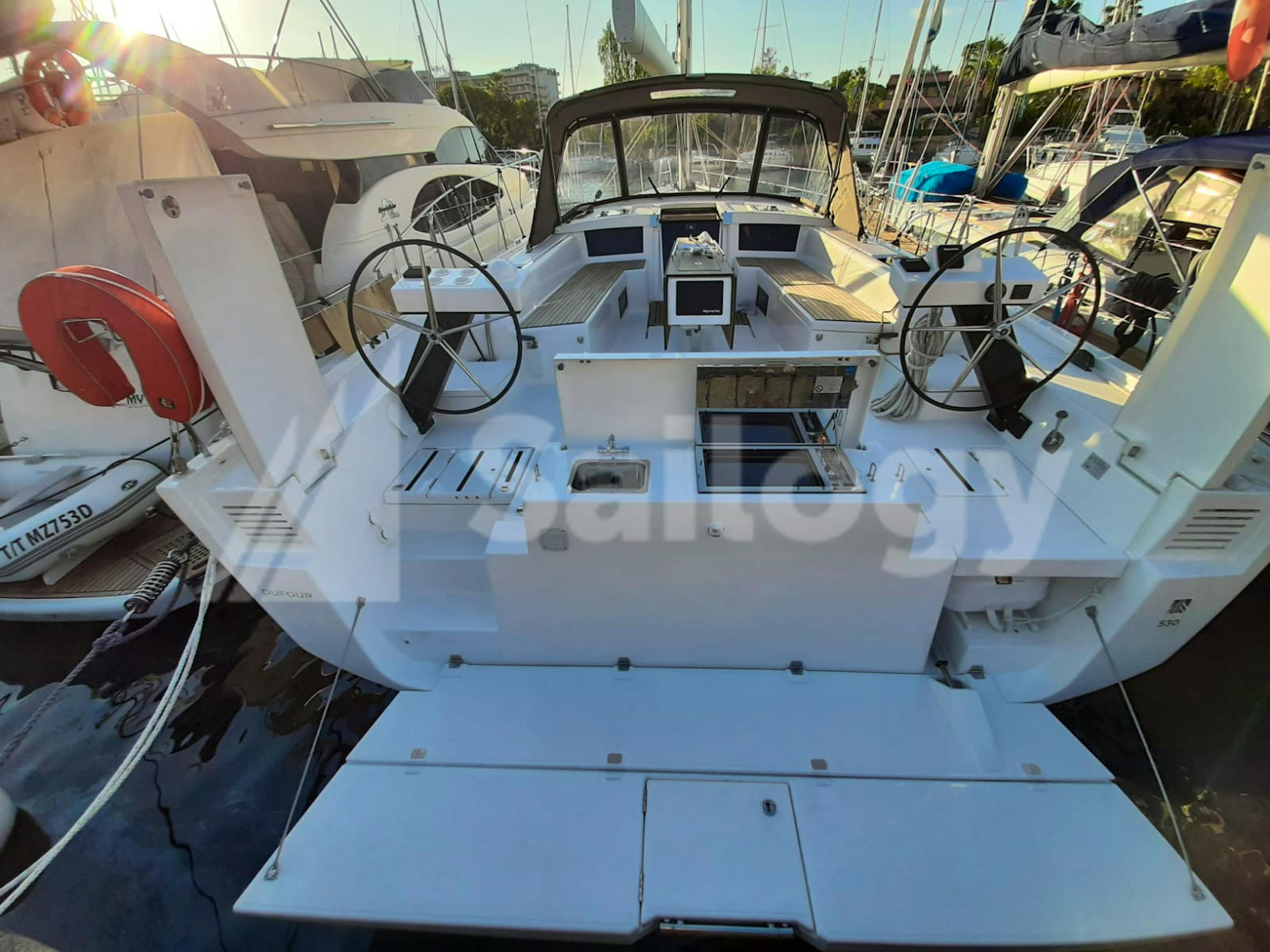
Portorosa, Aeolian Islands
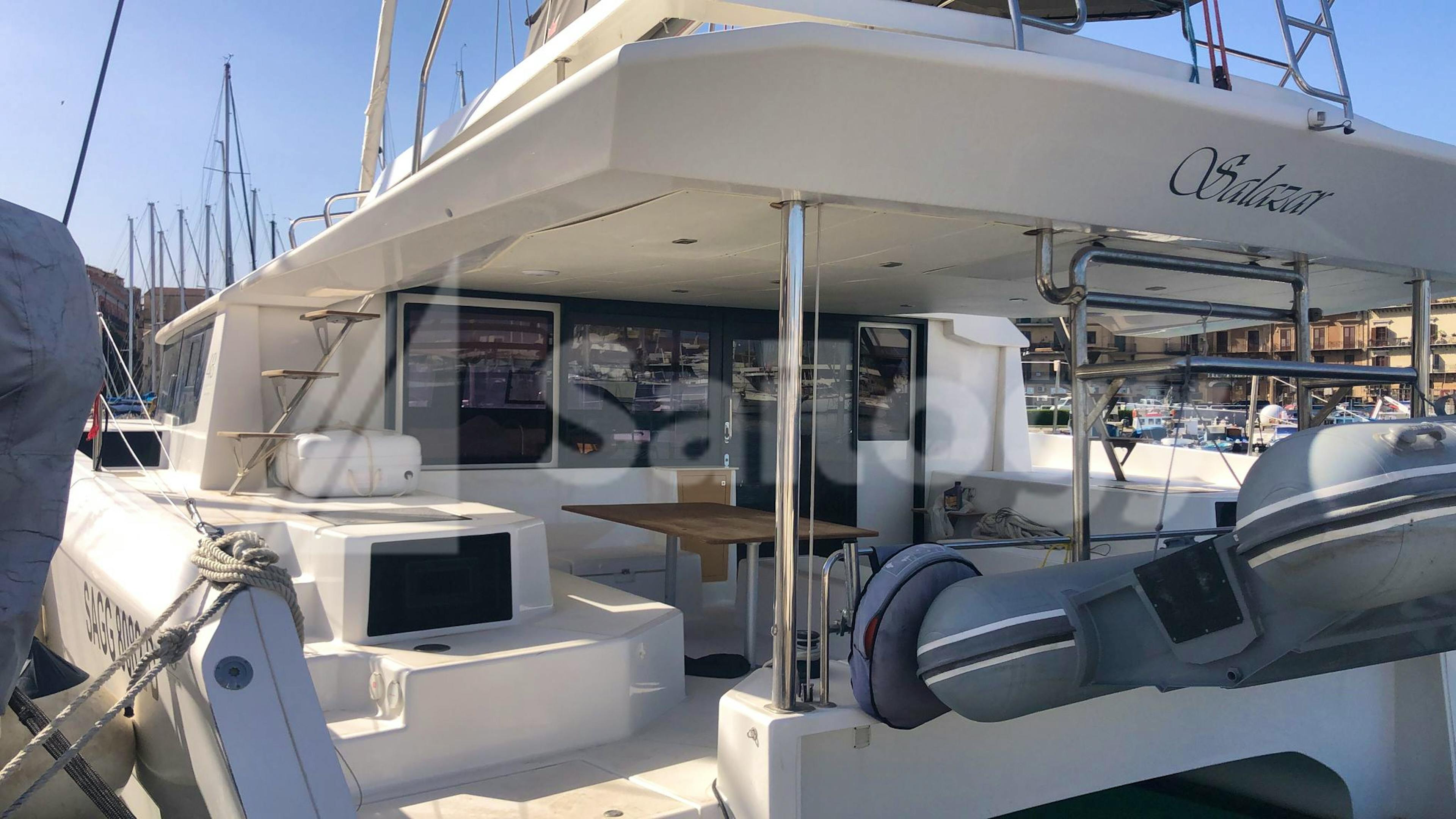
Dufour 430 Grand Large
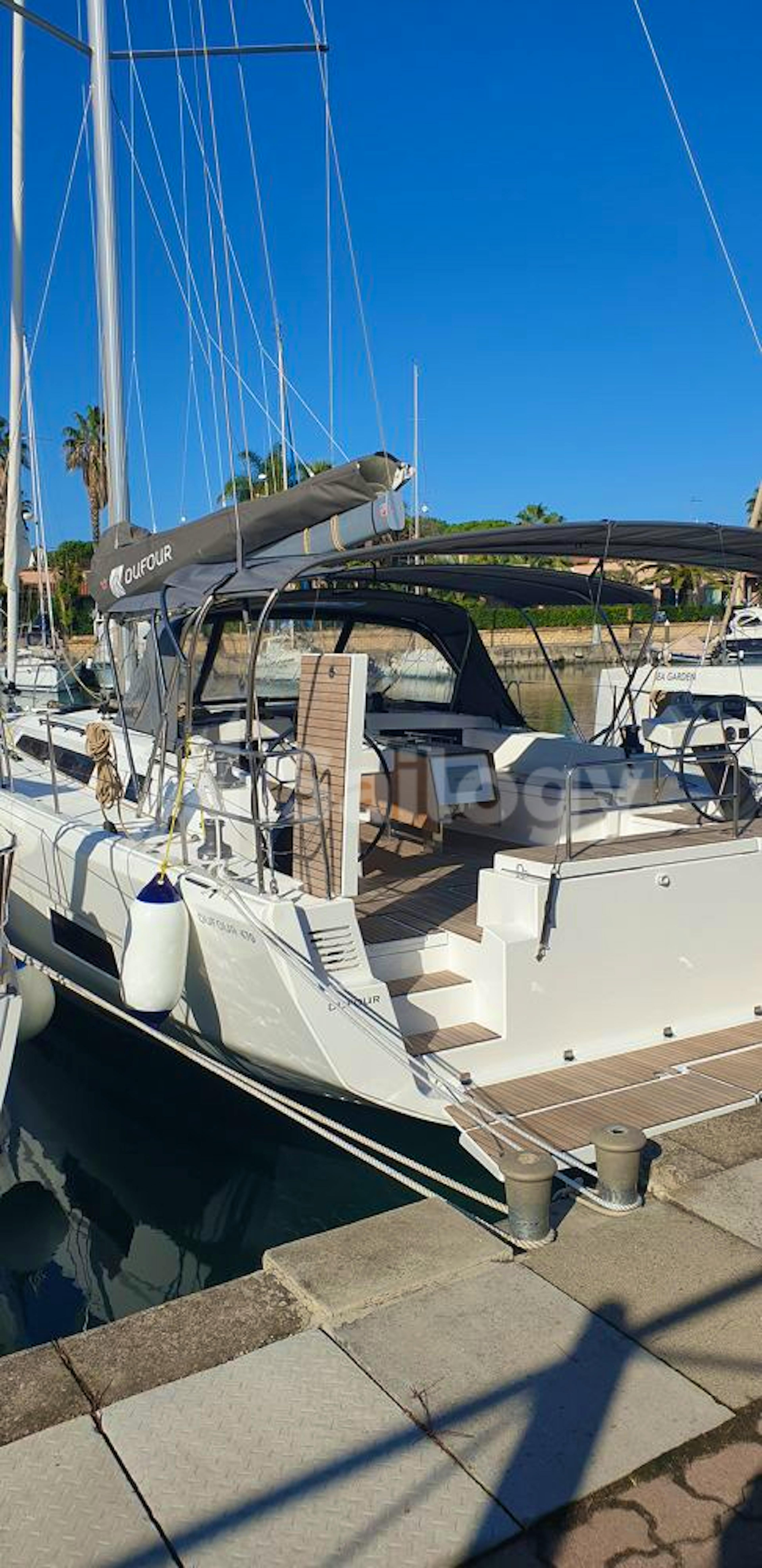
Other articles

7-day Sailing Itinerary in the Dodecanese Islands

What To Bring On a Boat

Kornati Islands Sailing: Best Spots To Visit By Boat
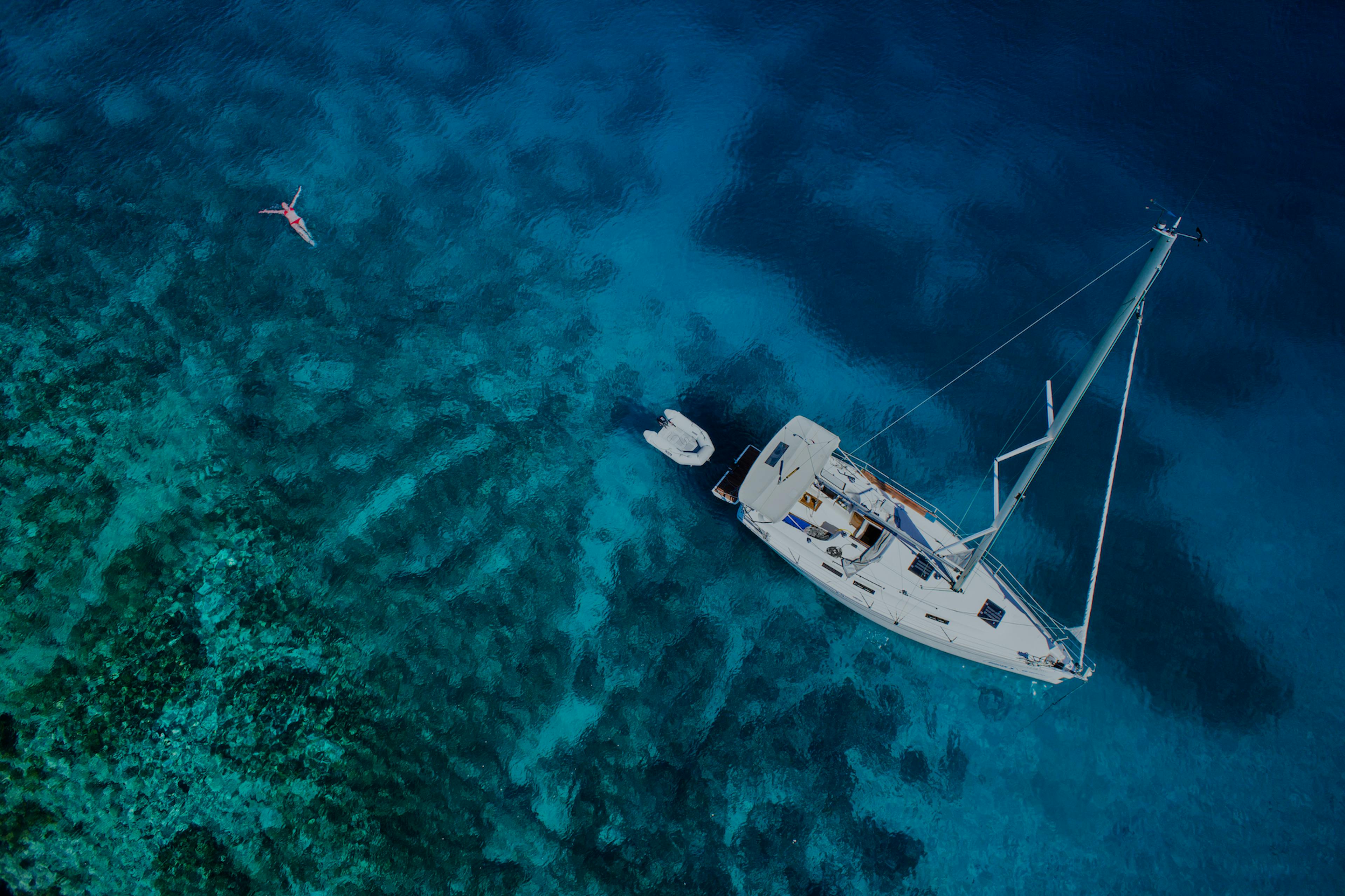
Stay in touch
New sailing magazine out now.
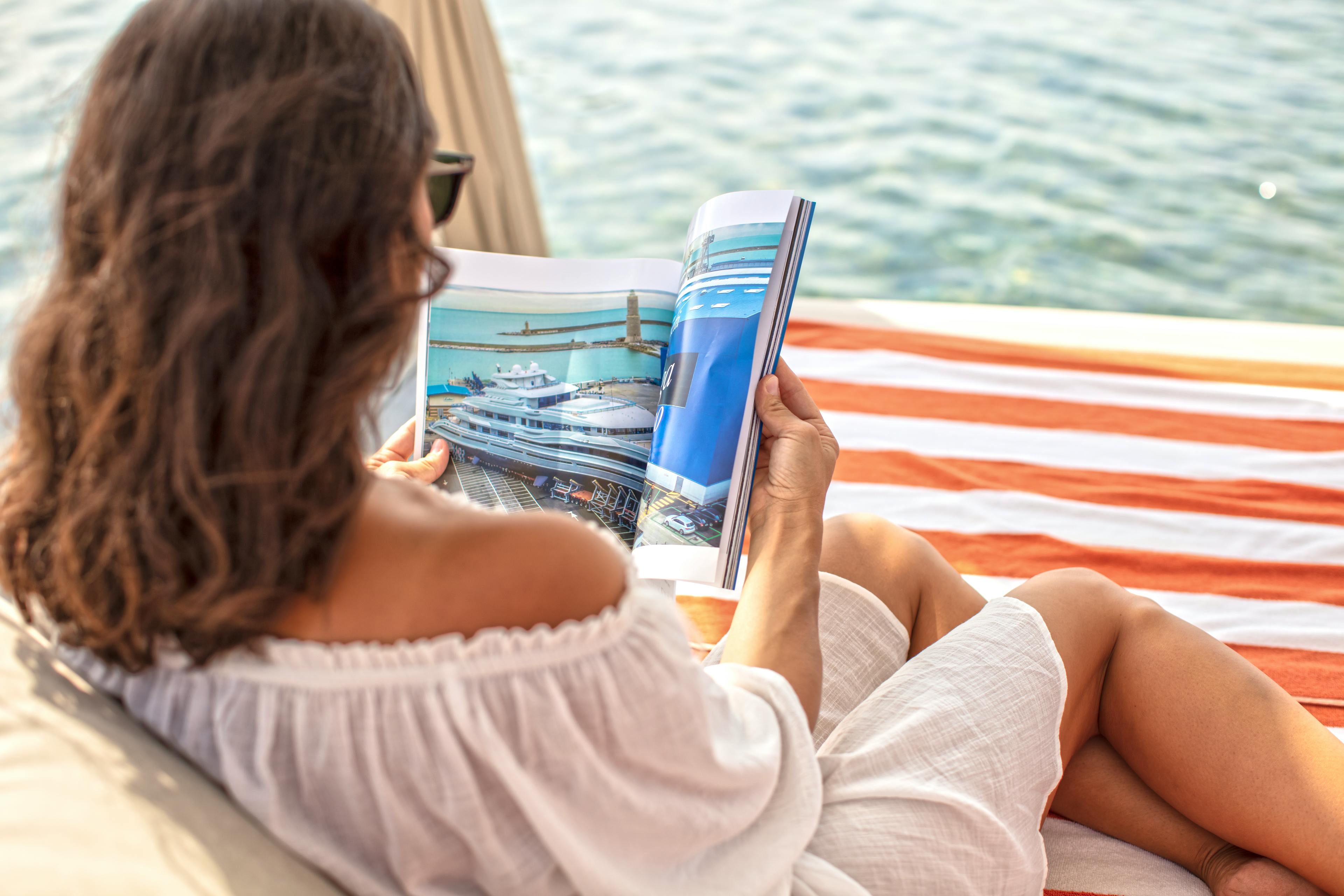
- Articles and Guides
Catamaran vs Monohull: The Great Sailboat Debate
16th jun 2023 by john burnham.

Do you love the natural sounds of water sliding past the boat’s hull and a breeze blowing across your rigging and sails while gliding ahead powered only by the force of the wind? If yes, you are well-suited to spending plenty of time on a sailboat, like so many generations of boat people before you.
But do you take your lead from the Egyptians who rigged sails on their boats built of reeds along the Nile River or follow the path of the Polynesians, who used an outrigger for extra stability and sailed from one Pacific island to the next in the earliest catamarans?
The question of which is better for sailing, one hull or two, has been a matter of debate over thousands of years. Today, let’s explore these two basic types of sailboat, and while we may not settle the argument once and for all, hopefully in the process you will begin to discover which option is better for you.
What Are the Differences Between Catamaran and Monohull Boats?
The monohull and the catamaran (often referred to as “cat”) are the two most common categories of sailboats, and of the two, the monohull far outnumbers the catamaran in popularity due to its simplicity and sturdiness. Advocates of the catamaran, however, are typically even more convinced than monohull sailors that their boats are best due to performance potential and overall spaciousness.
What are catamaran-style boats?
Catamarans are easily identified by their two-hull design. Two hulls sit side by side with an interconnecting deck or structural beams across the bap in the middle. Catamarans have been around since Pacific Islanders and other Austronesian people sailed them centuries ago, and they continue to gain popularity in a wide range of designs both as high-performance racing boats and ocean-cruising designs.
Although not part of this debate, a third sailboat type comparable to a catamaran is a trimaran. Trimaran sailboats are constructed similarly to catamarans but have three parallel hulls rather than two. Collectively, catamarans and trimarans are referred to as multihulls, and sailors of both types often refer lightheartedly to monohulls as “monomarans.”
What are monohull-style boats?
Monohull sailboats are the most common boat type because they feature a single hull, typically with a single mast and two sails. Rather than maintaining stability with a second hull creating a wider beam, monohull boats usually carry lead or other heavy ballast in their keel, or are stabilized by human weight as their crews lean out to counter the force of the wind. Monohulls can also be excellent racers and cruisers, depending on their size, volume, sail area, and displacement or weight.
Where Catamarans and Monohulls Excel
Each type of boat has its advantages, depending on what the owner wants in a boat. Here are the main advantages of each type.
Catamaran advantages
• More space . Catamarans have greater beam for a given length, which provides more space for the crew on a daysailer and larger living quarters on cruising designs, which are often laid out with berths in each hull and living quarters across the bridgedeck between hulls.
• Faster hull . If they are light enough, the sleeker shape and reduced wetted surface of two narrow, shallow hulls can produce quicker straight-line sailing speed than a single, deeper and wider hull.
• Comfort and stability . Two hulls provide better initial stability and generally heel less than monohulls, especially in light- or medium-strength winds and waves.
Monohull advantages
• Upwind sailing . When sailing against the wind, monohulls often sail at a closer angle to the wind and arrive more quickly at their destination.
• Easier motion . Heavier monohulls often have a slower, gentler motion in waves than a lighter catamaran.
• Load carrying capability . A monohull’s performance is reduced less than a catamaran’s when the boat is loaded heavily with cargo or crew.
• Righting characteristics . Larger monohulls have weighted keels that provide increased resistance to a capsize when the boat is heeled far over by wind or a wave and if capsized will return the boat to an upright position.

Catamaran vs. Monohull Sailing Speed
There are several reasons why a catamaran is often faster than a monohull boat. These include the fact that most catamaran hulls have less water resistance than monohulls, they are often lighter, and they can be more easily driven by a relatively small sailplan. At similar lengths, a catamaran can be dramatically faster than a monohull under similar sea conditions. However, weight is the enemy of a catamaran’s speed; a heavy or heavily loaded catamaran may be much slower than a lightweight monohull.
Catamaran vs. monohull power
A monohull under auxiliary power may be faster than a catamaran in certain conditions, like powering against a strong wind. In other wind and wave conditions, the catamaran is often faster. Also, with an engines on each hull, the cat is often much more maneuverable in close quarters or at the marina. While it may seem counter-intuitive, turning and controlling the boat is often less challenging than when sailing a monohull boat with the typical single engine. Monohull boats require more finesse when in tight quarters like berthing in a marina.
Catamaran vs. Monohull Efficiency
A sleek monohull may sail against the wind super efficiently, pointing close to the wind and making an excellent speed. However, the power-to-weight ratio of the catamaran allows it to make good use of whatever wind it has. Some fast, light catamarans can travel at speeds equal to or faster than the wind, something very few monohulls can achieve. When the wave action increases and you start sailing into the wind, the catamaran may lose its advantage, and in strong winds, the greater windage of the wide catamaran may have a pronounced slow-down effect compared to the sleeker monohull.
Catamaran vs. Monohull Stability
Despite not having a weighted keel, a catamaran design is able to avoid heeling over in strong winds or bad weather due to its greater width or beam. As a result, the multihull also tends to be more stable at anchor and any time in calmer seas. However, if the winds are strong and the waves are large, a monohull, with its keel weight and ability to sail against the wind while controlling the sails, is sometimes the steadier of the two types. While a monohull with weighted keel can be knocked down by strong gusts of wind, it will only capsize in extremely large waves. Likewise, a cruising catamaran can only capsize in large ocean waves, unless it is a fast, lightweight catamaran, that can more easily tip over in gusty winds and waves.
Catamaran vs. Monohull Safety
Power catamarans and power monohulls are relatively comparable in terms of safety. But depending on the size of the mast and sails, the weight of the boat, and the wind and wave conditions experienced, many sailors believe that a monohull configuration is safer than a catamaran for a sailboat. That’s mainly because while a monohull will initially heel over further in a strong gust of wind, the weight of its keel provides increasing stability as described above and if completely capsized, the keel typically helps the boat self rescue.
It should be clarified that many sailing catamaran designs are conservatively configured and difficult to capsize except in extreme ocean wave conditions—and the same can be said for larger power catamarans.
In terms of ultimate safety in the event of a capsize, however, the catamaran is considered safer because even should it turn once upside down, even if damaged, the catamaran with its two hulls and minimal ballast typically remains buoyant and provides a safer configuration in which to await rescue. By contrast, if a monohull’s hatches and port windows suffer damage in a knockdown, the boat can more quickly take on water and, weighed down by its keel or other ballast, be more difficult to keep afloat in extreme conditions.
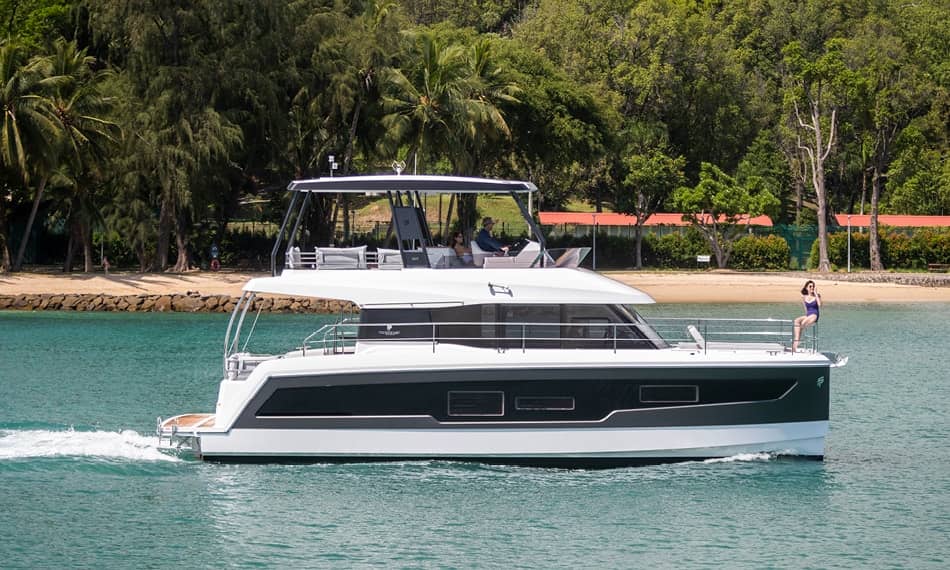
Photo credit: Fountaine Pajot
Monohull vs. Catamaran Maintenance
Depending on size, age, and type of hull construction, maintenance costs will vary, but when comparing two fiberglass sailboats of similar length, the catamaran typically costs more to maintain. That’s because there are two hulls to care for, two engines, connecting structures that align the two hulls, and an overall larger boat due to the catamaran’s greater beam. Hauling and launching a catamaran can be more expensive at many boatyards, as well.
However, smaller catamarans of about 20 feet in length or less are often more comparable and sometimes cheaper to maintain than a similar length monohull. That’s because cats are often lighter and suitable for keeping on a trailer rather than in a slip or on a mooring.
Catamaran vs. Monohull Cost
Compared to similar length monohulls, a catamaran will likely cost more than a monohull boat. That’s mainly because when you purchase a 40-foot catamaran, you are buying two hulls and two engines, but you are also buying a bigger boat that typically has much more volume. In the case of a 40-footer, you end up with a boat that has a large saloon and three or four private cabins, whereas in the monohull, the saloon is smaller and you’ll have three smaller sleeping cabins. Annual maintenance will also be greater, as described above.
Among smaller catamarans and monohulls, pricing will vary, and a lightweight beach cat may be less expensive than a heavier monohull keelboat of similar length.
Catamaran vs. Monohull, Pros and Cons
Depending on a variety of factors, there are plenty of catamaran and monohull pros and cons. These are some to keep in mind when comparing the two boat types.
Catamaran pros
• Comfort . On a cruising designed catamaran, two hulls with a wide beam create a stable and comfortable living environment with open spaces and plenty of standing room.
• Speed . Smaller, lighter catamarans are speed champions, especially in a moderate wind and modest waves. Cruising cats are often fast when sailing at reaching angles.
• Maneuverability . When equipped with two engines, a catamaran is highly maneuverable under power.
Monohull pros
• Upwind sailing . Although catamarans are often faster when sailing in a straight line, monohulls typically perform better against the wind.
• Self-righting . Except for unballasted monohulls that rely on crew weight for stability, the ballasted keel of a monohull prevents capsizing in most circumstances and the keel makes the boat self-righting.
• Maneuvering under sail . Monohulls turn more easily due to their shape, maneuvering in close quarters or tacking when sailing against the wind.
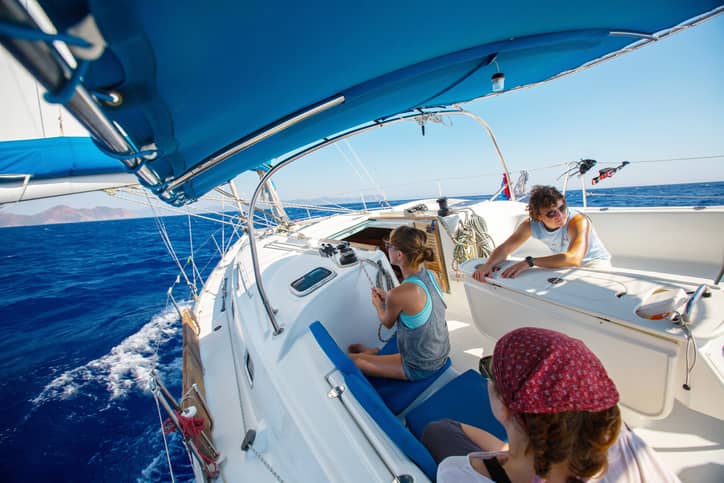
Catamaran cons
• Lack of feel when steering . Except in lighter, more performance-oriented catamarans, the broad platform with two rudders and two hulls sometimes isolates the sailor and provides little feedback through the helm when under sail.
• Sailing against the wind . Upwind sailing is generally not a catamaran’s best point of sail, but its straight-line speed can be such that it may arrive quickly at its destination, even though you will have traveled much farther than in a monohull.
• Pricing . Catamarans are typically more expensive than monohull boats due to their two hulls and other required build components and complexity.
• Not self-righting . Thanks to its wide beam and two-hull design, a catamaran is more difficult to flip, but it is not designed to right itself except for small beach cats where the crew can use their weight to re-right the boat.
Monohull cons
• Weight . Most monohulls have thousands of pounds of weight in the keel for ballast that is vital to its stability but can degrade performance.
• Wave motions . Monohull boats are much more susceptible to rolling wave motions.
• Cabin . With the monohull cruising design, you'll typically find a darker interior with smaller port windows and fewer space options.
• Heeling effect . Monohulls will heel over in a moderate wind, which is normal but often uncomfortable for newer sailors.
Written By: John Burnham
John Burnham is a marine editor and writer with decades of journalism experience as Chief Editor of boats.com, Sailing World, Cruising World, and other boating websites. As a competitive sailor, he has led teams to world and national titles in the International One-Design, Shields, and other classes. Based in Newport, Rhode Island, John is a PCC leadership coach, a member of the America’s Cup Hall of Fame Selection Committee, and a past board member of Sail America and US Sailing. For more, see johnsburnham.com .

More from: John Burnham
Related Articles and Guides
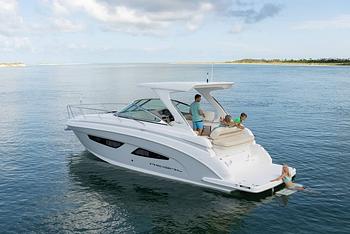
6th Sep 2024
The Best Mini Yacht Brands for Cruising and Luxury
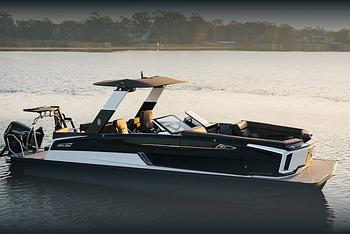
16th Aug 2024
Best Luxury Pontoon Boat Brands Have it All: Glamor, Speed, Fishing, Waterslides...
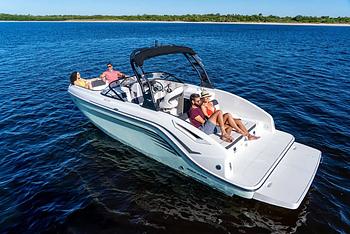
10th Aug 2024
Deck Boat vs. Bowrider: Which Runabout is Best?

19th Jul 2024
The World’s Best Yacht Brands

- Explore Rightboat
- Boats for Sale
- Boating Articles
- Buyers Guide
- About RightBoat
- Sell Your Boat
- Boat Selling Advice
- All manufacturers
- All categories
- Are you a broker/dealer?
- Learn more about the Rightboat:HUB
Enter your email to keep up to date with the latest news
Join for free
Sign up now for free and discover how easy it is to keep up to date with THE latest boats for sale. Find your right boat, and tailor your voyage to finding your next boat.
Benefits of becoming a member:
- Set up tailored alerts
- Personalise your experience
- Download full specifications and broker details
- Keep tabs on your favourite boats
Are you a broker? Join as a Broker
Rightboat - join for free.
Do you have an account already? Login
Save this search
Save your search and receive new boats in your email..
You can unsubscribe from your alerts whenever you like. By pressing the button you accept the Legal Terms and conditions

Catamaran Vs Monohull

Monohulls and traditional sailboats, once ubiquitous, are giving way to modern catamarans. But how do these designs differ?
Monohulls have a single hull, and catamarans have two hulls side-by-side. Catamarans are faster than monohulls of the same length and displacement, but monohulls are stronger and more spacious. Monohulls are also cheaper and easier to build than multi-hulls.
In this article, we’ll cover the differences between catamarans and monohulls, along with the benefits and drawbacks of each design. We’ll also cover the sailing characteristics of each and why catamarans so easily outrun equivalently-sized monohulls.
We sourced the information used in this article from trusted sailboat design resources, along with manufacturer specifications and boat market analysis.
Table of contents
What is a Catamaran?
Catamarans are a kind of multi-hull sailboat with two hulls joined together. They are often short and wide, resembling a square or rectangle from above.
Catamarans are colloquially distinct from outriggers, which are double-hulled vessels with one large primary hull and a small outboard stabilizing hull.
Catamarans usually have hulls that mirror each other, both in size and arrangement. Sometimes, the interior layouts are mirrored, too—but this varies between designs and manufacturers. Catamaran hulls are narrower and taller than most monohull designs of equal lengths.
Catamarans have limited commercial and military utility, as these applications favor space and ease-of-construction over handling characteristics. That said, there are some commercial uses for catamaran designs—most commonly passenger and car ferries.
What is a Monohull Sailboat?
A monohull is probably what you traditionally think of as a boat. Monohulls are longer than they are wide. It features a single hull—it’s that simple. Sailing monohull designs have evolved over the centuries into many distinct types, usually distinguished by keel type.
Monohulls come in many shapes and sizes . For example, sailing monohulls designed for offshore use have long keels that sometimes extend much further below the waterline than the freeboard and cabin extend above it.
Monohull sailboats are also designed for other purposes, such as inland sailing and racing. These vessels have more contemporary characteristics, such as rounded shallow ‘canoe’ bottoms, V-bottoms, and fin keels.
Monohulls aren’t just sailboats. Virtually every cargo and container ship, warship, and many passenger ships are monohulls due to their strength, ease of construction, and high cargo capacity.
Are Monohull Sailboats More Common?
Monohulls are more common in every application, though multi-hulls are becoming more common for ferries. Monohulls have numerous benefits over multi-hulls, and these benefits only increase with scale.
Monohulls are easy to construct. They’re also cheap. Large monohull ships, such as container ships, can be built with very little material and effort. This is because the vast majority of the length of a monohull is just a box, with a bow and stern welded onto the end.
Sailboat construction is more intricate, but the costs are still lower. Plus, monohull designs are robust, and cabin space is plentiful. There’s a lot more study in the field of monohull design, which was the universal truth until somewhat recently.
But all in all, the reason why monohull sailboats are more common is that they work just fine. Most sailboat owners aren’t interested in breaking speed records or hosting dozens of people aboard their boats. As a result, a standard, simple, and easy-to-control monohull are more than sufficient.
Are Catamarans Faster than Monohulls?
Catamarans are most certainly faster than monohulls. This is almost always the case. Even the fastest production monohulls can’t hold a candle to the average cruising catamaran.
But why is this the case? Aren’t catamarans restricted by the same hydrodynamic forces as monohulls? As it turns out, they aren’t. This has to do with the unusual way hull waves impact speed.
Hull Speed Limitations
Monohull speed is limited by something called hull speed. Hull speed is determined using a formula that calculates the maximum speed a displacement hull can travel under normal power and conditions.
When a displacement hull moves through the water, it kicks up a set of waves at the bow and stern. These waves travel along the side of the vessel and create drag, which slows down the boat. Normally, the power of the wind can overcome this drag—but only to a point.
At a certain speed, the waves kicked up by the bow will sync with the waves kicked up at the stern and begin ‘working together’ against the boat. The speed at which this occurs is the hull speed, which is calculated from the length of the boat.
Hull speed limitations for monohulls aren’t universally true all the time. Some vessels exceed it, and some don’t—but the number is a useful estimate of the limitations of monohull designs. Modern monohulls with clever hull shapes can defeat hull speed calculations.
Do Hull Speed Limitations Apply to Catamarans?
Surprisingly no—hull speed calculations don’t work for catamarans. This is because, for one, the hulls are shaped differently. Alone, catamaran hulls wouldn’t float correctly. But together, they create different hydrodynamic effects and cancel out the effects of hull speed.
This means that catamarans can easily exceed the speeds of even the fastest monohulls of equal length—and sometimes beat them by a margin of 50% or more. It’s not unheard of for 40-foot catamarans to exceed 20 knots, whereas 40-foot monohulls rarely get past 10.
Are Catamarans More Comfortable than Monohulls?
Catamarans can be much more comfortable than equivalently-sized monohulls—up to a point. This is because catamarans engage in ‘wave piercing’ and have a wider and more stable footprint on the water.
Catamaran hulls, when properly designed, can slice through parts of a wave instead of riding over every peak and trough. This effectively reduces the height of the weight, which reduces the amount the boat rolls.
Additionally, the wide footprint of a catamaran allows some waves to simply pass right under it, keeping the boat level for longer durations. Catamarans also don’t heel under sail—instead, they plane slightly, raising the bows out of the water and reducing bumps.
Monohull Benefits
Monohulls are proven in all conditions. A well-designed displacement monohull sailboat can ride out the strongest storms, and monohull workboats can support enormous loads and move them efficiently. They can be fast, comfortable, and also easy to sail (even for beginners).
Monohulls are cheap to build and forgiving, as precision doesn’t have to be microscopic to get them to sail right. They’re robust and strong, featuring a naturally stress-resistant hull shape. They’re also easy to modify and aren’t required to meet as strict of dimensional ratios to operate.
With a monohull sailboat, you have a lot of interior room to work with. This means that monohulls are available in numerous cabin layouts and are just as easy to modify as they are to build. Monohulls often have a center of gravity at or below the waterline, which enhances stability at steep heel angles.
On the water, displacement monohulls can weather extreme conditions with ease. They lack the initial stability of multi-hulls, but they can recover from knockdowns on their own, and they’re very difficult to push past their rollover point.
Why do Catamarans Cost More than Monohulls?
Catamarans cost more than monohulls because they’re more expensive to build, more complex to engineer, and require more material. This isn’t always the case, but the design of catamarans requires much more careful engineering and strength-of-materials analysis than comparatively simple monohulls.
There are several critical structural points on catamarans that monohulls lack. In fact, the very shape of a monohull is physically strong—so it has inherent durability. Catamaran hulls must be joined in the middle, and the mast must have a strong point far from the inherently sturdy hulls.
This requires stronger materials and more care during design or construction. This is why catamarans remain a premium part of the sailboat market and why they still aren’t the most popular sailboats despite their numerous performance and comfort benefits.
Catamaran Cabin Layout
Catamaran cabins are split between the two hulls, and there’s usually a large pilothouse in the center. Pilothouse catamarans can be quite spacious, primarily due to the large space between the hulls.
The pilothouse is usually where kitchen and sitting areas are located, along with cockpit access and the controls of the sailboat. The mast is also located in this area.
Catamaran cabins sometimes mirror each other. For example, each hull may contain two identical bedroom/bathroom combos, while the center console area contains the kitchen and living spaces.
The two identical hulls sometimes make for unusual design decisions (such as small catamarans with four master bedrooms), but owners say this gives their passengers a much better experience than a monohull cabin.
Monohull Cabin Layout
Monohull cabins, with the exception of split-cabin sailboats with a center cockpit, have only one large interior space to work with. It’s usually much wider than catamarans of equal length.
Monohull cabins are usually accessible from the bow (via a flush deck hatch) and the stern via a traditional companionway. They run the span of the hull between the bow and the cockpit and sometimes include spare berths under the cockpit seats.
These spare berths are often used as convenient sea cabins, as they offer quick access to controls in case of an emergency. Catamarans often have convertible berths in the center console for the same reason.
Monohull cabins are traditional and include everything that catamaran cabins do—albeit with slightly less room overall. That said, individual spaces are often much wider, and facilities are more appropriate.
Related Articles
Daniel Wade
I've personally had thousands of questions about sailing and sailboats over the years. As I learn and experience sailing, and the community, I share the answers that work and make sense to me, here on Life of Sailing.
by this author
Learn About Sailboats
Most Recent

What Does "Sailing By The Lee" Mean?
October 3, 2023

The Best Sailing Schools And Programs: Reviews & Ratings
September 26, 2023
Important Legal Info
Lifeofsailing.com is a participant in the Amazon Services LLC Associates Program, an affiliate advertising program designed to provide a means for sites to earn advertising fees by advertising and linking to Amazon. This site also participates in other affiliate programs and is compensated for referring traffic and business to these companies.
Similar Posts


Affordable Sailboats You Can Build at Home
September 13, 2023

Best Small Sailboat Ornaments
September 12, 2023

Discover the Magic of Hydrofoil Sailboats
December 11, 2023
Popular Posts

Best Liveaboard Catamaran Sailboats
December 28, 2023

Can a Novice Sail Around the World?
Elizabeth O'Malley
June 15, 2022

4 Best Electric Outboard Motors

How Long Did It Take The Vikings To Sail To England?

10 Best Sailboat Brands (And Why)
December 20, 2023

7 Best Places To Liveaboard A Sailboat
Get the best sailing content.
Top Rated Posts
© 2024 Life of Sailing Email: [email protected] Address: 11816 Inwood Rd #3024 Dallas, TX 75244 Disclaimer Privacy Policy

Catamaran Or Monohull? 27 Important Facts (Explained)
Catamarans and monohull boats are two very different kinds of vessels. Each craft offers distinct advantages and disadvantages that you’ll want to consider before choosing between the two.
In this post, we’ll go over some of the important things to consider when choosing between catamarans and monohull boats:
Table of Contents
Cost & Availability
Both catamarans and monohull boats come in small recreational sailing versions, larger motorboat versions, and larger sailing models. In all cases, the catamarans will cost more and will be harder to find.
The reason catamarans are harder to find because there are not as many of them, and they’re mostly made overseas.
Also, there aren’t as many catamaran manufacturers, so sailors have fewer options when buying them.
On top of this, catamarans have only recently become popular in the United States and other areas of the developed world. This means the used market for boats doesn’t have as many catamarans on it. You might find that you have fewer options when making a used catamaran purchase, which could bring costs up to a premium.
Two Times The Fun with Catamarans

Another reason that catamarans are more expensive than monohulls is the fact that catamaran buyers have to purchase two hulls, two engines, and two of all of the components that help make an engine work.
Traditional sailboats and large powerboats with one engine don’t have this cost issue.
On top of this, a catamaran is much wider than a monohull, and thus you have more space to build and equip.
On the other hand, once you’ve purchased the boat, you do get to enjoy the benefits of having two of everything. We’ll talk about the advantages of this further down in this post.
Maintenance Cost Makes A Difference
The maintenance on a catamaran is also more expensive than the maintenance on a monohull boat. This goes back to the fact that there is twice as much of everything to maintain.
Catamaran owners will need to do preventative maintenance on two different engines, and they’ll have two hulls and a large deck area to clean and maintain as well. If they’re getting the bottom of the boat treated, they’ll have to do this twice (once for each hull).
Even the interior components can usually be found twice.
Each cabin will usually have a head in it, so you’ll have at least two toilets and sinks to maintain, which obviously has its plusses and minuses.
One positive aspect of this is that catamaran owners do have the option of deferring some of their maintenance. For example, if one head is no longer functioning properly, you always have the second one that you can use.
It also adds a bit of safety as well.
This is because while the catamaran does have two engines to maintain, the owner does have power even if one of the engines happens to go down.
Some catamaran owners also like to point out that maintenance may not have to be done as frequently. This is because the engines don’t have to work quite as hard, and other items like additional bathrooms and sinks might only be used half as much.
How Much Space Do You Need?

A catamaran has more space than a monohull. This is because the boat is wider, and it has a much larger deck area. It also has twice as many hulls, so you have more overall space between the two of them.
The additional space is great for people looking to throw parties on their boats.
Most boat owners would agree that the catamaran is usually the party boat of choice at the docks.
Even if you aren’t into throwing parties, the extra space can still be nice for relaxing on the deck or getting a suntan. The wide-open space also makes it easy to use the boat as a fishing platform.
Additionally, you have more space for stuff like surfboards, rafts, and other items that can easily clutter up the deck of a monohull. Even fishing can be easier from a catamaran as the deck provides plenty of space between different anglers.
Catamaran owners also have additional space for carrying fresh water and adding generators and solar panels.
Interior space is generally more plentiful on a catamaran, and luxury catamarans have an easier time fitting large items like washers and dryers inside of them. You can have these on larger monohulls as well, but it will be harder to make them fit than it is in a catamaran.
On the other hand, all of the additional space means the catamaran owner has more space to maintain and clean. Also, all of the additional items that can be brought onto the boat will make it heavier. A heavier boat will use more fuel, and it will travel more slowly.
Living Quarters Vary Between The Two
The living quarters on a catamaran are much different than they are on a monohull. Most people would agree that the berths in a monohull are much more spacious than in a catamaran.
A monohull offers people the opportunity to have a large bed with space on either side to walk around it. This is great for couples who want to get out of bed without waking up their partner.
Catamarans, on the other hand, have the advantage of being able to offer large above-deck salon areas. The galleys, the dining areas, and the living areas can all be above-deck, while the two hulls can provide heads and berths.
Some boat owners say that living in a monohull is akin to living in a basement apartment . Other boat owners prefer the monohull because it brings them closer to the water and gives them the feeling of being at sea.
Privacy Can Be Prioritized On Catamarans
A catamaran offers up many different living areas that people can take advantage of. For example, each hull will typically have its own bathroom and bedroom.
This gives each sleeping area complete privacy from the other.
The living quarters are usually up on the deck, so early risers can wake up and move to these quarters without waking up the others.
The same holds for night owls. A night owl can stay up late without bothering the people who want to retire to their beds earlier.
With two hulls, large catamaran owners can hire a crew and give them their own hull to live in so that there is separation between the cruisers and the crew. This is a wonderful advantage for honeymooners looking to have their own space.
The downside to all of this, of course, is that sometimes a family may not want the additional privacy. For example, a family with small children might not want their children in a different hull than they are.
Additionally, the extra privacy can make it hard for people on the boat to communicate. This could become a big problem in the event of an emergency.
For this reason, it is often recommended that each hull have a radio in it so that the occupants can quickly communicate with each other. Remember, even in inland areas, cell phone reception may not be very good inside the boat hulls.
Recreation In a Monohull vs. a Catamaran
Most sailors agree that sailing a monohull boat is much more exhilarating than sailing a catamaran. Traditional sailboats heel, and sailors get instant feedback while they’re sailing. For the most part, catamarans stay stable, and you don’t get the same feeling with the movement of the wind and the water.
When it comes to monohull powerboats, you have the advantage of being able to pull water skiers, kneeboarders, and tubers with ease, as long as the boat has the power and a planing hull. A power catamaran usually doesn’t have the speed or maneuverability to pull off these recreational opportunities because they are displacement hull designs.
Catamarans excel in more leisurely recreational activities. A catamaran makes a great party deck as well as a great cruising deck. Catamaran owners can comfortably walk around a catamaran without having to worry that the boat might knock them over the next time it decides to heel. This allows boaters to sit and talk with one another comfortably.
A catamaran can also be used as a beaching vessel. This makes it a great platform for people looking to go swimming or fishing around sand bars and other shallow water areas. It also makes it a great boat for sailors looking to sail a larger boat on a river or lake known for having shallow areas.
Swimming and Diving
Swimming and diving off of a catamaran are usually much easier than doing the same from a monohull. The wide stance of the two hulls offers boat designers the option to put in staircases at the back of both hulls.
In between these staircases, some boats will have an additional diving platform and/or a dedicated frame for pieces of equipment and dinghy storage. This makes catamarans great for swimmers, snorkelers, and divers.
On the other hand, modern monohull sailboats can also have good transom stairs for easy access to the dinghy and swimming. Both types of boats can easily travel far out to sea, giving boaters the option of diving in areas that can’t be accessed from beaches and developed areas.
Boat Draft In Shallow Waters
For the uninitiated, the boat’s draft refers to how deep the boat’s hull sits within the water.
A monohull typically sits deep within the water, while a catamaran sits much higher on the water. This is why we stated that a catamaran is good for shallow waters.
The advantage of having a boat that can go into shallow waters isn’t restricted to just recreational activities like swimming and fishing. A boat that can go into shallow water is safer to operate in areas where a boat with a deeper draft might become damaged.
Additionally, a catamaran has more stability on calm waters. This helps make a catamaran more comfortable to relax or sleep on while at anchor or the dock.
The deeper draft of a monohull boat has its advantages as well. A deeper draft provides more stability in rough waters and allows a boat to go further into the sea.
For this reason, many coastal cruisers will prefer catamarans, while many ocean voyagers will prefer monohull boats. In fact, some areas of the Caribbean and the Florida Keys can be off-limits to boats with deep drafts as it simply isn’t safe for the boat to navigate these waters.
This isn’t to say that you can’t navigate these waters in a monohull boat, but you will have to be cautious depending on how deep your monohull’s boat draft is. You wouldn’t have this issue in a catamaran.
Stability On The Sea

A catamaran offers a lot more stability in shallow waters, in calm waters, at the dock, and anchorage. This makes the boat great for cruising and for relaxing in port.
A monohull offers a lot more stability in rough waters.
This makes this boat great for heading out to sea and for navigating vast distances.
Safety Issues To Consider
Both catamarans and monohulls can be built to navigate the waters they were made for safely. This will be determined more by the boat’s category designation rather than the type of boat.
However, each boat deals with unsafe situations in different ways. For instance, a monohull boat is likely to right itself if it is capsized.
This means that even in rough seas, you’re unlikely to find yourself permanently capsized.
The downside to this is that should you become completely swamped from a capsize in a monohull boat, you are much more likely to sink. In fact, if there is a hull breach on a monohull boat, your boat could sink.
Catamarans are said to be unsinkable. This isn’t completely true, but it is very unlikely that a catamaran will sink. Even if a hull is breached, you still have a second hull to keep the catamaran afloat.
However, a catamaran can’t right itself. If you capsize your catamaran, it will stay capsized.
One other safety concern to consider is that a monohull sailboat will heel while a catamaran will not. This increases the chances that someone could fall off the boat or onto the deck in a monohull boat.
Catamarans Are Faster Than Monohull Boats
A catamaran is faster than the average monohull boat.
This is because they face less water resistance, and their narrow hulls don’t have to deal with their own bow waves as a monohull does.
Of course, catamarans aren’t always faster. Old cruising catamarans may not go faster than 8 knots, and modern monohulls can exceed 10 knots.
Monohull boats tend to sail downwind and in choppy seas better than catamarans. This gives them a speed advantage during ocean voyages.
We have a separate post with complete average speeds per type of catemaran . It’s a must read if you are at all concerned about speed!
Fuel Consumption Considerations
Catamarans have two engines to burn fuel, which can drive up fuel costs.
However, a catamaran is lighter on the water, so it usually takes less energy to move a catamaran. This means you’ll end up using less fuel in a catamaran than you would in a monohull.
On top of this, catamarans can decide to use just one engine in low wind areas. This further decreases the amount of fuel that a catamaran consumes.
These rules only apply to calm waters.
A monohull navigates waters with high waves and strong winds much more efficiently than a catamaran. In this case, you’ll use less fuel in a monohull than you would in a catamaran.
Sailing Differences To Notice
Sailing a monohull boat can be exhilarating. These boats can glide through choppy waters, and you get to feel the motion of the boat as the sea rushes by the cockpit and the wind causes you to heel.
This type of sailing also provides instant feedback as you’ll know what you need to do with the sails as you’ll feel what is going on through the boat’s motion.
Sailors all over the world have been using monohull sailboats for years, and you’ll find plenty of outlets for recreational sailing with a monohull sailboat.
Sailing catamarans do not heel like a monohull sailboat.
These boats, therefore, do not provide the sailor with instant feedback. Also, if you incorrectly sail a catamaran, you do risk capsizing the boat more easily.
Training Can Be Quite Hard
Sailing a catamaran and sailing a monohull boat are two different experiences. People looking to sail either should probably get professional training.
Obtaining this training will always be easier with a monohull boat.
This is because monohulls are more popular, so you’ll have more instructors available to you.
Do You (Or Your Friends) Get Seasick?
People who are prone to getting seasick easily might want to consider a catamaran. A catamaran provides much more stability in calm waters, and you get a lot less movement.
On the other hand, people who are not prone to getting seasick might prefer a monohull in choppy waters.
This is because a monohull will deal with deep and choppy waters with high waves much better than a catamaran will.
As a result, a catamarans movement can seem extreme under these types of conditions. People who have never gotten seasick before can end up sick under these conditions.
Here’s a separate article we wrote with everything you should know about seasickness on Catamarans . There are some things you can do and some things you should know!
Docking Is (Usually) Easier With A Monohull Boat
Docking a catamaran can be a difficult endeavor.
This is because catamarans are often too wide to be docked within the slips located in central areas of a marina.
Because of this, they need to be docked at the end of the dock. This leaves them with fewer spots to dock. It also makes docking more expensive.
Catamaran owners traveling through areas that are unlikely to have many catamarans in them may find it difficult to find a dock at all. This is true in areas of the northern Atlantic where monohulls are much more popular than catamarans.
Storage Issues To Consider
Even storing a catamaran can be more difficult. This is because storage facilities often do not have the equipment to get a catamaran out of the water.
The wide width of these boats requires special lifts, and not all boat marinas will have them.
Storage facilities that do get the catamaran out of the water will often charge more money for it. They’ll charge additional fees for taking the catamaran out of the water, and they’ll charge additional fees for the actual storage of the boat as well.
Redundancy And Backup Equipment
We touched upon this earlier, but it is worth repeating that catamarans have many redundancy built into them. This can be a big advantage when it comes to safety.
For example, if one rudder becomes inoperable, the boat can still be steered with the other one. If one engine becomes inoperable, the boat can still be driven with the other one.
In extreme cases, a hull could become damaged, and you could still stay afloat because the other hull will keep the boat safely above water. These safety advantages can save lives and keep people from becoming stranded out at sea.
The primary downside is the maintenance issue that we mentioned earlier. All of these redundant components will need to be maintained. As a result, maintenance costs will be close to twice as expensive in a catamaran.
Cooking Is Easier On Catamarans

Cooking on a catamaran is usually easier than it is on a monohull. The main reason for this is that a catamaran doesn’t heel like a monohull, so you don’t have to worry as much about things falling over.
This not only makes cooking easier, but it makes cooking safer as well.
Additionally, catamaran galleys tend to have more space in them to move around. Also, they are often up on the deck, so you don’t have to climb in and out of the hull with your dinner in hand.
Dinghy Storage
Monohulls and catamarans can both hold dinghies. The larger the boat, the larger the dinghy can be.
However, catamarans have a wide area at the rear of the boat that is perfect for holding dinghies.
This makes getting in and out of the dinghy easier. Also, people can often have larger dinghies on their catamarans because the boat’s stern is so accommodating.
Power Generation Is Easy On A Catamaran
A catamaran has a lot of space for solar panels and wind turbines. Rigid panels can be placed in areas that won’t be walked on, like overtop of the bimini, and flexible panels can be placed in areas where the panels might end up getting stepped on.
The width of a catamaran even gives them more opportunities to put hydro generators into the water.
This means catamarans can generate more power than the average monohull boat can generate.
On the other hand, a monohull usually has less powered items to worry about. Monohulls need less power to operate at full capacity, so you may not need all of the additional space for generating power.
Ventilation Issues To Think About
Some people feel that monohull boats don’t offer enough ventilation. This is especially true in warmer areas of the world.
Catamarans also lack ventilation within their hulls, but fortunately for them, much of the living space is located up on deck. This gives catamarans an edge when it comes to cruising in warm weather.
On the other hand, monohull owners aren’t exposed to the cold winds that you might find up on deck in harsher climates.
This lack of airflow may actually be of benefit in this instance.
Some people find monohulls to be better looking than catamarans and vice versa.
This all comes down to personal preference, so you’ll have to decide for yourself which type of boat has the advantage in this case.
Some people think catamarans are the most elegant thing in the world while others prefer monohull boats as they look more classic.
Resale Value Is An Important Factor
If you read our extensive guide to boat depreciation per boat type , you know that no matter what boat you buy, it will always go down in value. This is just a sad fact of boat ownership that people need to consider before buying a boat.
Many factors go into how much you’ll be able to get for your boat when you resell it. These factors are the condition of the boat, the age of the boat, and the economy in general. For example, people are less likely to want to buy boats during a recession. This is especially true when it comes to smaller boats.
However, one additional factor that catamaran owners need to consider when thinking about resale value is the value of the dollar.
People from the United States don’t have many American catamarans to choose from and will usually need to buy these overseas.
This means that a catamaran will be less expensive to buy when the dollar is strong compared to the Euro and more expensive to buy when the dollar is weaker in comparison. This will affect the used market as well because higher values on new catamarans can help to bring up the value on the used market.
With a monohull boat, you may not have to consider situations like this as there are makers of monohull boats all over the world.
Don’t Let The Length Trick You!
One thought to keep in mind when comparing monohull boats and catamarans is that their different shapes account for different space advantages.
For example, a 40-foot long catamaran will have much more cubic space than a 40-foot long monohull.
Because of this, when comparing boats, you should look at the cubic space rather than the length. In this case, you may be comparing a 48-foot long monohull with a 40-foot long catamaran.
When you compare the two types of boats in this manner, the price differences aren’t quite as large, and the comparison is fairer. It also may make the operating and maintenance costs more similar.
This is an important distinction to make because the length of the boats can trick you!
Consider Trying Both (Before Buying)
Boats can be an expensive purchase, so it makes sense to try them out before you decide to make your purchase.
Rent each type of boat and use it on the types of waters that you intend to cruise on the most.
Try the boat out in different weather conditions as well, and don’t be afraid to do multiple rentals before you make your final choice. The time and money invested into making sure you get the boat you really want will be more than worth it in the end.
Click to share...
Sailing Catamaran vs. Sailing Monohull Yacht
Are you considering sailing on a catamaran or a monohull? Read this article to explore the pros and cons and find the answers you are looking for. If you have not yet tried sailing on a catamaran but are interested, the following list of differences between monohulls and catamarans may help you decide which one to charter.
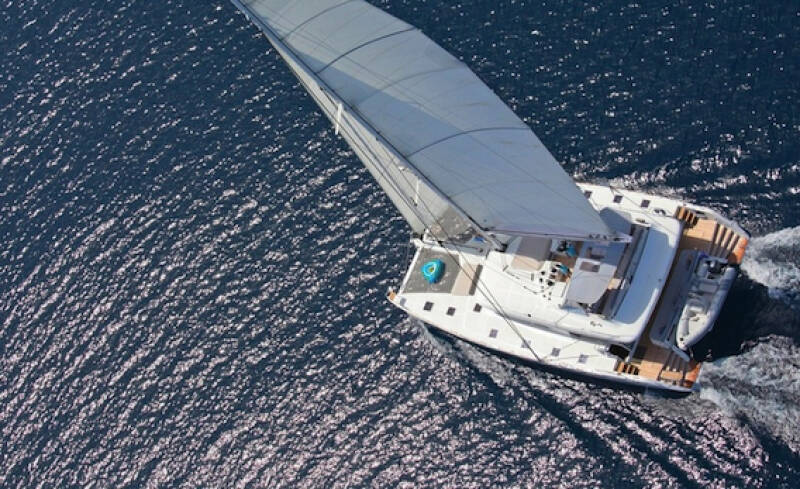
Catamaran charters have become very popular due to several essential characteristics. The great buoyancy enables the entire boat to act as sort of a raft. Catamarans have great manoeuvrability since most catamarans have twin engines, so they can be more comfortable to dock than a single-engine monohull. Modern catamarans can do a 360 turn in their length.
In contrast, monohulls might provide you with more of a “real sailing” feeling , more thrills and exciting moments. Adrenalin junkies would love hanging on the side of a sailing yacht , while it is heeling under 25° under full sails.
Monohulls are offering a specific sailing charm for real sailing enthusiasts.
But don’t get the wrong impression, monohulls are not just for hard-core sailors. They have a comfortable salon area, spacious cabins, and areas for sunbathing and other activities. On the other hand, charter clients who tend to sail during the peak of the season are putting more value on spaciousness, comfort, and stability than the ones who are sailing during pre/post-season when sailing conditions are more favourable. It could be that the popularity of multihulls lies in those facts.
Spaciousness & Comfort
First on the list of catamaran vs monohull characteristics is spaciousness , in favour of the catamaran. More cabins, a larger salon area and more extensive areas for sunbathing than on a monohull of the same length. If you prefer comfort and more space, multihulls are your go-to yachts for sailing vacations .
Large net areas on the bow of a boat provide you with a unique feeling while lying on them during your sailing trip or when soaking up the sun while anchored in a lovely bay. With all that additional width, cockpit areas on multihulls are offering massive amounts of space making them ideal for a large family meal or an exclusive party area. There are also owner’s versions of the multihulls where one whole hull is dedicated to the owner, resulting in an impressive size suite on the boat, which will satisfy the most demanding ones.
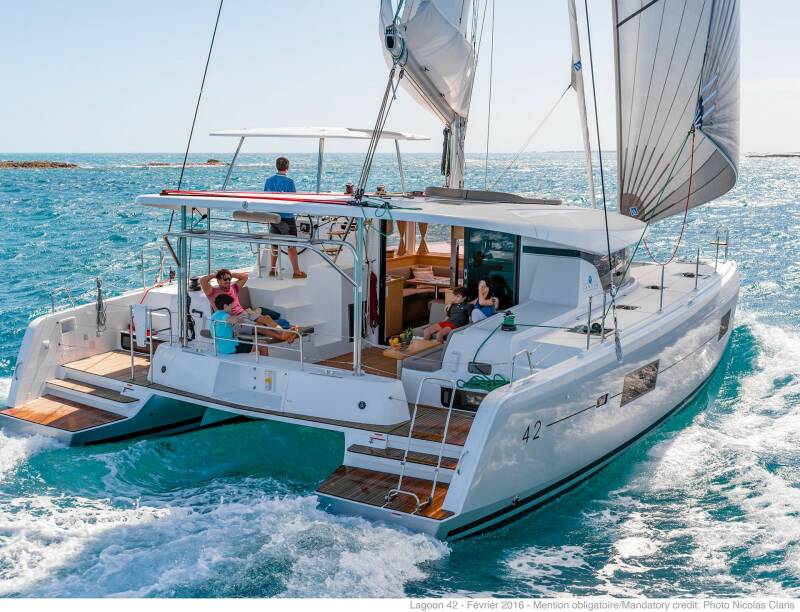
Next on the catamaran vs. monohull list of pros and cons is the fact that multi-hulls are offering more stability, which is ideal for families with kids - especially while walking around the yacht since all areas are more extensive than on a monohull yacht. There is no heeling under a 25° angle when the sails are up, so boat guests can enjoy and even prepare their food and drinks while sailing.
Most of the multihulls have a separate flybridge with nice, shaded areas for enjoying the ride or a drink, and it can also convert into sunbathing areas. The separated flybridge also means a complete separation of skippers that provides maximum privacy for yacht guests or owners.
A separated skipper cabin could be found on almost every multihull. On the larger ones, those skipper cabins have full equipment (toilet, sink, shower, etc.), leading toward complete separation of a crew and yacht guests in case that is necessary.
Pounding and Slapping
Multihulls such as catamarans and trimarans are deriving their popularity from the fact that most of them are created for extracting maximum pleasure out of your vacation at sea. However, there is one advantage most monohulls have compared to catamarans, and that is when underway is that they do not pound or slap . Catamarans with low bridge deck clearance tend to hit and slap on the undercarriage in lumpy seas when sailing upwind. This may sometimes feel as though the boat is getting beaten to pieces.
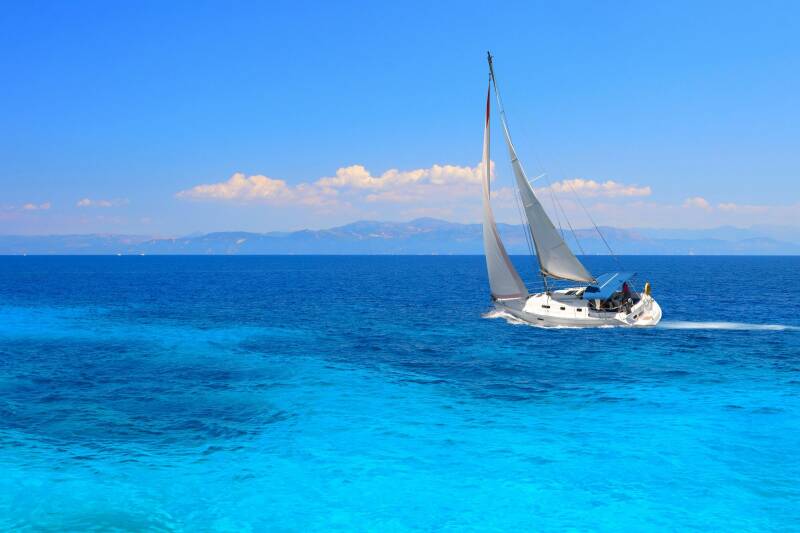
Speed Difference
Catamarans are in most sailing conditions faster than monohulls, because of their hulls which are less immersed in the water and have a smaller area in the water to create drag. Multihulls are unusually fast when sailing downwind for the reasons just mentioned above. When sailing downwind they are faster than monohulls, but when they are cruising windward, close-hauling monohulls are usually faster.
Manoeuvring & Docking
When talking about catamarans vs. monohulls , when it comes to manoeuvring and docking; monohull sailing yachts are propelled just by one engine which can combine with a bow thruster on the front. The bow thruster is a small electric engine on the bow of the yacht enabling it to move bow sideways by the press of a button, providing additional skipper security and making it easier to manoeuvre in tight spaces.
Two engines propel multihulls. Two engines can be significant in case of emergency when one of the engines fails, but they are also great for manoeuvring in tight spaces. Two engines are enabling the skipper to rotate the yacht for practically 360 degrees at one point, meaning very little manoeuvring space is necessary for a large and wide yacht to dock.
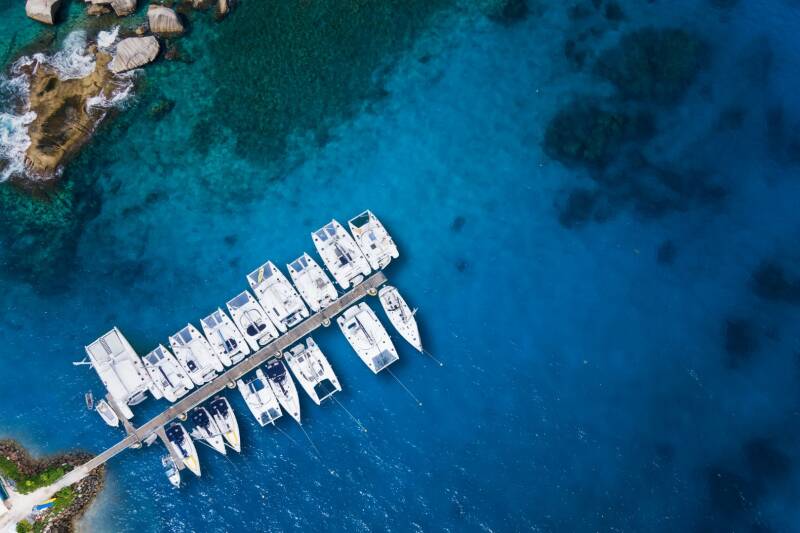
Catamaran vs. Monohull Yacht – the Final Verdict
In the end, we are back to personal preferences and finance, especially when choosing a catamaran vs. a monohull . Catamarans are more expensive to buy/rent and to moor/dock, but they offer a lot for their price. They provide an extraordinary sailing sensation filled with luxury, for individuals and families looking to spend their vacation at sea, sailing while wining, dining and enjoying the sun. We have to make it clear that the sailing sensations of mono and multihulls are also entirely different. For adventurous individuals heeling under 45 degrees would be ideal, but for ones who would like to have a nice meal and sunbathe during sailing, multihulls would be perfect.

We use cookies to provide you with the best service on our website. If you stay on our website, you consent to our Cookies Policy .
Tell us about your dream holiday, and we'll make sure you get a personalised offer at the best price on the market.
Thank you for your message. We will get back to you as soon as possible.
We're looking forward to learn more about your dream holiday. The more info you send us, the more detailed and personalized offer we can provide.
You have succesfully submitted the details of your sailing trip. Your detailed and personalized offer is on its way.
Monohull vs. Catamaran: which yacht is for you?!
By Yacht Week
Posted on 29th June 2022

If you're excited to join The Yacht Week but have never sailed before, we're here to help you decide on your perfect floating home for the week. From catamarans to monohulls, Classic to Premium, check out our handy guide with all the different types of yachts to help you work out which one is best for you.
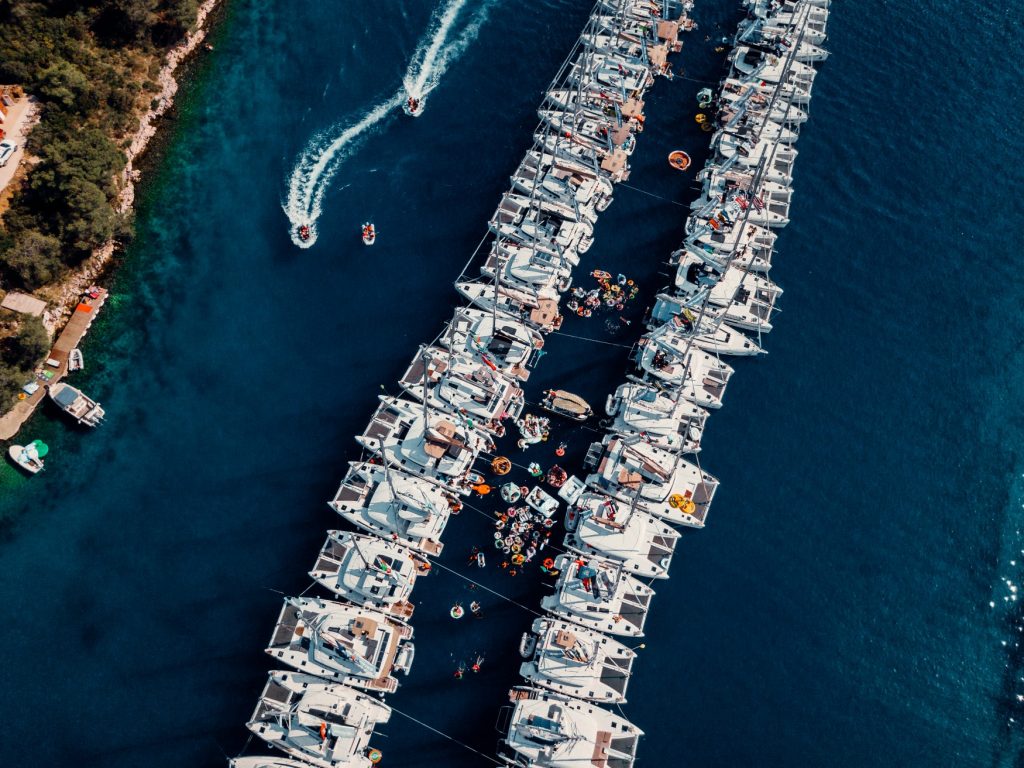
Catamaran vs monohull - what's the difference?
Firstly, let's talk terminology. To choose between a monohull and a catamaran you need to know what makes them different. Simply put, as the name suggests, a monohull has only one hull (the main body of a yacht), whereas a catamaran has two hulls.
The benefits of a catamaran having two hulls is that they will typically stay more level and offer a lot more space, while a monohull will always reach faster speeds when sailing. Here's what one of our amazing hosts, Cara Whiteman, has to say about the difference:
If you like to sail, make sure you book a monohull to get a real authentic experience with the yacht leaning over and cutting through the waves under sail! Don’t worry if you still like your space - you can always book the larger monohulls, such as the Jeanneau 54 .
Alternatively, if you are looking to top up on the tan, a catamaran is the best bet, with lots of outside space for lounging and sipping on cocktails. The kitchen is much bigger and the yacht stays more stable at sea, so if you’re a foodie you’ll enjoy the spacious and more social dining experience that the extra room allows.
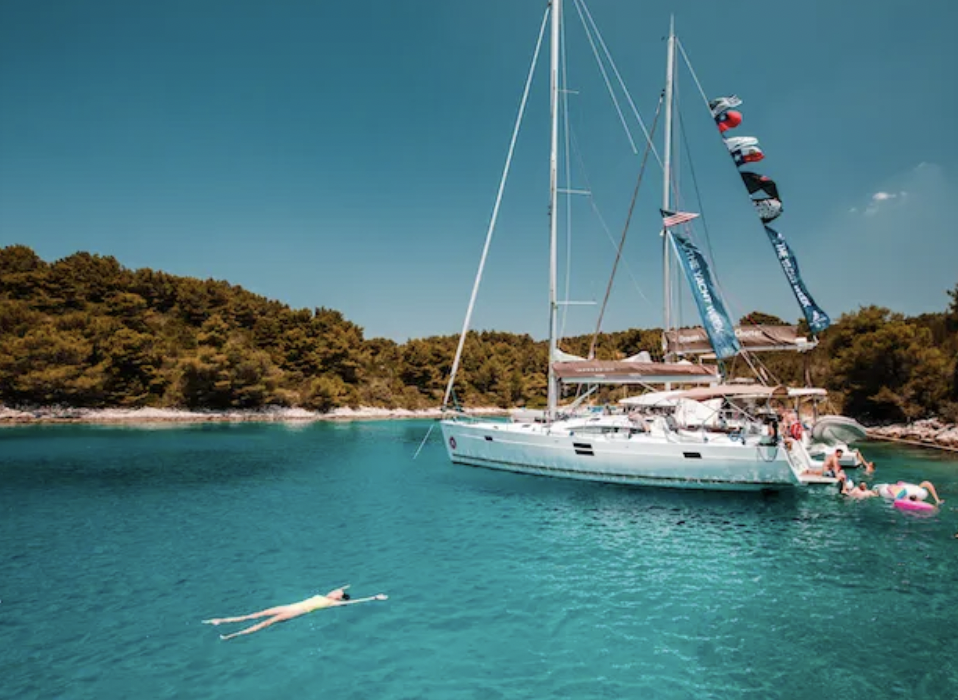
Things to think about before you book
There's nothing better than a recommendation from someone really in the know. Another of our amazing skippers, Anton Ha, has some great tips for you to think about before you book:
If you're planning to join TYW at the peak of summer, especially between weeks 26-34, then make sure you book a yacht with air-conditioning!
Don't plan to let people sleep in the saloon (lounge area) as it makes the yacht look messy all week long, which is no fun. If you can afford to keep your crew size down, you will really enjoy the uncluttered space.
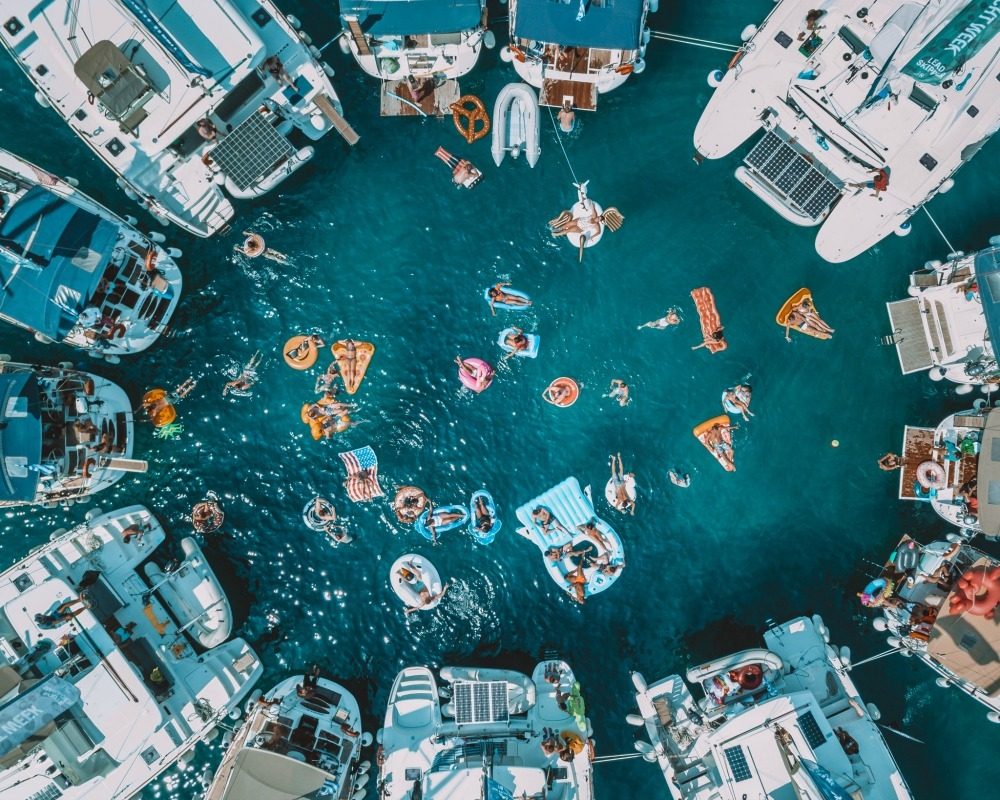
What's included with all our yachts?
So now you know the differences, but what do they all have in common? Here's everything that comes standard with our yachts:
- Your skipper - Very necessary, of course. Our amazing skippers are an essential part of your experience as they will help you sail your way through the week. They'll navigate your yacht, lead your crew and make sure you discover all the hidden gems along the way. They're there to ensure you have a safe and enjoyable experience and are happy to teach you some of the key skills for sailing if you’re keen to get involved.
- Fully equipped kitchen - Feast your way through the week by whipping up a storm in your very own kitchen. Packed with all the pots, pans and cutlery you could need. Don't want to bother with the cooking? Book yourself one of our friendly hosts for the week.
- Bedding and bathroom towels - All your linens are provided, so no need to pack any of these. We do suggest bringing your own beach towel so you don’t get seawater on your bathroom towel.
- Speakers - Every yacht has its own speakers, so you don't need to bother about packing these. Pump out the tunes as you sail your way through an unforgettable week.
- Wifi - while we definitely encourage you to switch off and enjoy every minute of the week, we also make sure you don’t lose touch with the real world (unless you want to, of course).
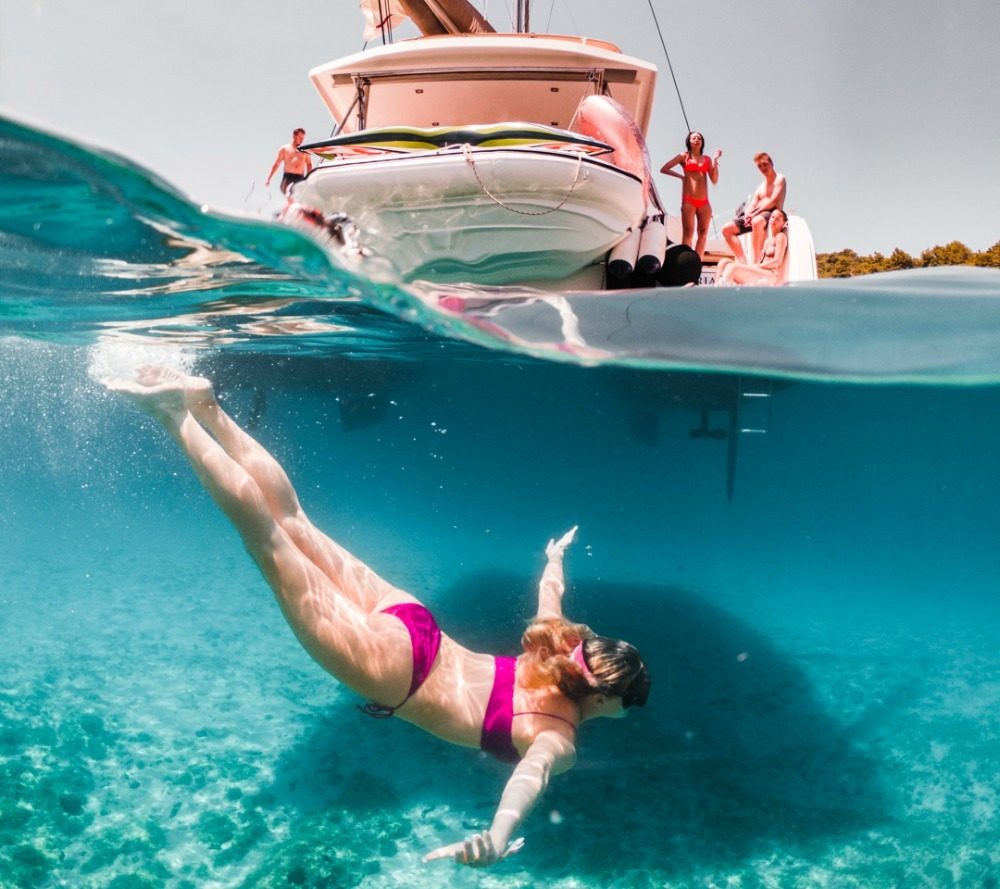
Which yachts do our skippers and hosts recommend?
So now you know about all our different categories of yacht, but which ones do our skippers and hosts love? Surprisingly, they all have their own preferences for different reasons. Check out which yacht three of our amazing skippers and hosts recommend.

" In my opinion, the Lagoon 450 catamaran is the perfect TYW boat. Four spacious cabins for up to eight guests. Two crew cabins, so your skipper and host will be well-rested. A huge icebox, which is a great addition to the air conditioning and three fridges (two for food, one for drinks) on hot days, as it means cold drinks all day long. There's also a huge sunbed on top and a net upfront, which are the perfect spots to enjoy a sunny day on the water. " - Anton Ha
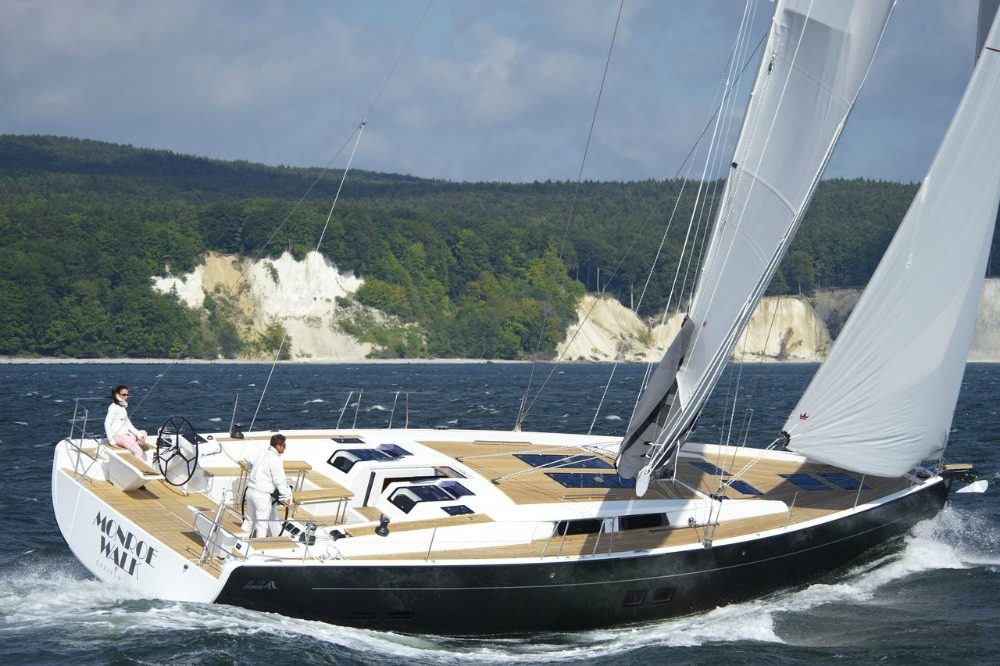
" The Hanse 575 is my favourite TYW yacht hands down! It is a luxury boat with coveted air conditioning. You have lots of room both up top for tanning and relaxing and down below so you don’t feel too cramped. The best part is that the Hanse can really send it sailing with good winds. Total best of all worlds scenario. " - Megan Whyte

" My favourite TYW yacht is the Bali 4.1 catamaran, mostly because of the vast living space it had both inside and out. The large dining area makes for sociable mealtimes without sacrificing sun lounging and dancing space out on deck! " - Cara Louise Whiteman
Share this post
Yacht Week brand and concept is owned by Day 8 AB - a private limited company registered in Stockholm, Sweden. Day 8 Experiences Ltd acts as a travel agent on the behalf of Yacht Week.
© 2024 Yacht week. All rights reserved.
Catamaran Vs Yacht
Learn the difference between a catamaran vs yacht charter, what yacht should you charter catamaran vs monohull, what is better to charter a catamaran vs yacht.
Those new to yacht charter and catamaran charter will often ask, what is Better to charter – a Catamaran or Yacht? To assess the catamaran vs yacht question, we need to understand the main differences. A catamaran is, strictly speaking, a yacht with two hulls and a yacht in this context and a sailing vessel with one hull, otherwise known as a monohull.
It’s easily arguable that a sailing yacht was more fun to sail, takes up less room when mooring, and is cheaper per berth than a catamaran. Alternatively, a more stable catamaran offers more space and is cheaper per sq. foot of space.
Until recently, the advent of catamarans in the America’s Cup competitions would show that catamarans are not the slowcoaches they were when you consider the c atamaran vs yacht debate. All catamarans are very nice to sail just off the wind, which will leave some saying that my characterisation is a little skewed. Yet, I would say, in general, for charter catamarans vs charter yachts, the comparison holds.
Your Answer Will Depend on Many Different Variables Such as:
- Advantages of Catamaran Vs Yacht
- Disadvantages of Catamaran Vs Yacht
- Getting Into The Detail
- Thoughts on a Monohull Charter
- How to Book
Here are our 5 Reasons to Hire a Catamaran Vs Yacht
The Pros of a Catamaran Vs Yacht
The 5 reasons to hire a catamaran versus a yacht.
- Space. When weighing the Catamaran Vs Yacht debate, space is one of the key factors by far, but you’ll also see this appoear in our list of disadvantages too. In terms of squarefootage, if you like to pack generaously, or have planty of space for sunbathing, then Catamarans vs Yacht is for you.
- Cabins. Along the same theme, Cabins are generally much more spacious than monohulls. The locker storage space is always much greater than that of a monohull. The greatest advantage is the considerably larger ports (windows), which, when sailing in August, not only gives you a great view but comes in super handy to let in the breeze.
- Stability. Catamarans are notoriously more stable than that their counterpart. This can be beneficial for new or inexperienced sailors who haven’t got their sea legs yet or are prone to seasickness. Due to their two hull design, cats do not heel over more than 5 degrees. This means you don’t have to check that plates are not sliding off the table continuously!
- Draft. Catamaran’s shallow draft (depth of the hull and keel under the water) has some advantages. This is a particular advantage in areas with shallow waters, thus allowing you to anchor closer to shore.
- Power. Catamarans have twin engines. This, combined with the shallow draft, allows the yacht to cruise at higher speeds, whether under sail or using its engines. The two engines also allow greater manoeuvrability in confined areas or spaces, great in marinas or when picking up mooring buoys.
The Cons of Catamaran Vs Yacht
Four things you might want to consider with a catamaran vs yacht.
- Mooring . Due to the width (and size) of a catamaran, often, you have to pay a lot more to book a berth in a harbour for the night. However, some authors can be quoted as saying that anchoring in a cat is easier.
- Upwind Sailing. Catamarans don’t sail up-wind well! Performance cats make up for this with boat speed and by employing daggerboards to prevent leeway (sideways movement). It will be fun trying to sail upwind, but you might not make much progress!
- Steering. Sailors have noted that the helm (be it the tiller or a wheel) is not as responsive as a monohull, you don’t get the same feedback (weather helm) on a cat, and it can feel ‘limp’ to sail.
- The Feel. Most charter cats are built for comfort, so the sailing can be a little disappointing unless you’re on a beam reach.
The Pros of a Yacht vs Catamaran
Getting into the detaila - monohull vs catamaran advantages.
Monohulls offer the ultimate sailing experience for many sailors. Here’s why:
- Dynamic. When considering a monohull vs catamaran, remember monohulls can tack quickly, thus making them a lot more manoeuvrable than a cat. Nothing beats the rhythmic feeling of sailing whilst heeling over.
- Responsive. They are also fairly responsive to the helm.
- Up-Wind. These vessels are much more capable up-wind than most catamarans. They can sail much closer angle to the wind than a cat.
- Budget. Monohulls are cheaper to buy (fewer materials) than catamarans, often aimed at the luxury market and significantly less to charter. Berth for berth, cabin for cabin, a monohull is usually better value for money.
- Berthing costs. With twin engines, expect to put a little more fuel in your cat. The cost of berthing in a harbour or at a marina tends to be significantly lower due to the reduced beam (width).
The Last Case for a Monohull!
There are good reasons to consider a catamaran vs yacht, but if you love being up close and personal with your crew and you love dynamic sailing, here’s the big advantages.
- Snug. Modern charter monohulls are wide with high ceilings and have plenty of space in cabins and for stowage. That said, the usable space on a monohull is much less than that of a catamaran.
- Heeling. The boat heeling or “leaning” over is perfectly normal and something you get used to quickly. This can be tricky for the young and old and makes handling the boat a little more adventurous.
- Draft. Due to the deeper keel (the stabilising fin below the yacht), you cannot sail in shallow waters and must be more vigilant of your depth.
Learn More About Chartering a Catamaran Vs Monohull
As you can see, there are many pros and cons to consider when deciding between a catamaran vs yacht. Whilst the debate between monohull sailors and multi-hull fanatics will rage, it largely depends on what you are using the boat for, where, your budget, and your crew.
If you have the opportunity to decide if you prefer a catamaran vs monohull, by sailing both types of boats, then take it so you can assess the benefits of both wonderful sailing boats.
If you are planning a sailing trip and are a little unsure, why not get in touch, and we can help you decide what is best for your location and crew.
Amazing Sailing Experiences
Our amazing customers.
I didn't think sailing with my family would be so much fun...
Sailing for the first time.

Everything went smooth, the paper processing, special requests and the specs of tht check-in procedure. Boat was also in good shape, so no complaints and a worry free holiday...
We had a great experience with booking through sailchecker.
Informative and looked for the best value for our family. Very good customer service on this side and in Greece. Great boat and skipper...
Fantastic holiday from start to finish.
They were very responsive and very quick to answer questions via email and instant chat. They had extensive knowledge of the area...
We will most definitely use their services for our next bareboat sailing vacation.

Sailchecker were professional from start to finish - and were awesome dealing with a problem! Our first Yacht had serious issues and sail checker helped us to resolve it...
They are easy to deal with, straightforward and honest and I would recommend them to anyone planning a charter holiday.

During the Coronavirus pandemic, Kate and her colleagues at Sailchecker have performed brilliantly. They have been considerate and highly efficient in re-organising our Turkey charter and also provided lots of assistance in getting our Yacht Security Deposit insurance policy transferred to match our revised charter dates.
Truly worthy of a 5 star rating!

Would I go sailing again? OMG yes! Sailing is the perfect family holiday. Boys loved the activities, I enjoy relaxing as well...
Sailchecker.com arranged a sailing cruise her family of 2 sons, daughter & hubby in the BVI with their own.

It was sail in the day… party at night. We couldn't have wanted a better skipper or a Spring Break! Good times...
Arranged for 6 friends to sail Spring Break in the British Virgin Islands for under $500 each.

All bookings and confirmations was always accurate with no delays. Our boat was also fabulously maintained and the Skipper new the area extremely well...
Everything was down to the tee.

Rated 4.9 out of 5 based on 215 reviews on Trustpilot
Got a Burning Question About Catamaran Vs Yacht?
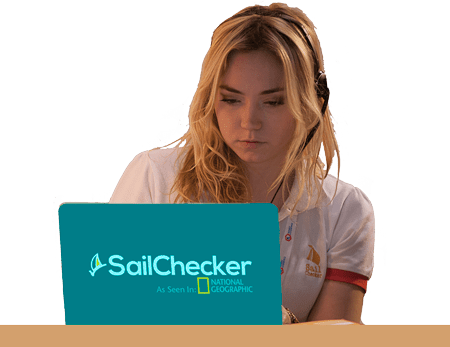
Founder Member IFCYA
Yacht Charter & Sailing.

Start typing and press Enter to search

- Marine Supplies
- Maintenance & Boating Guides
Catamaran vs Monohull: Pros, Cons & Main Differences
By: B.J. Porter Editor

The choice of catamaran vs monohull ultimately comes down to preference. What’s critical for one buyer may mean little to another. If your partner refuses to set foot on a boat which heels, that’s a deal-breaker for a monohull. But if you’re passionate about classic looks and styling, your quest for beauty may override other considerations and rule out catamarans.
We can’t tell you whether a catamaran or a monohull is right for you. But we can help you with the pros and cons of each for your search.
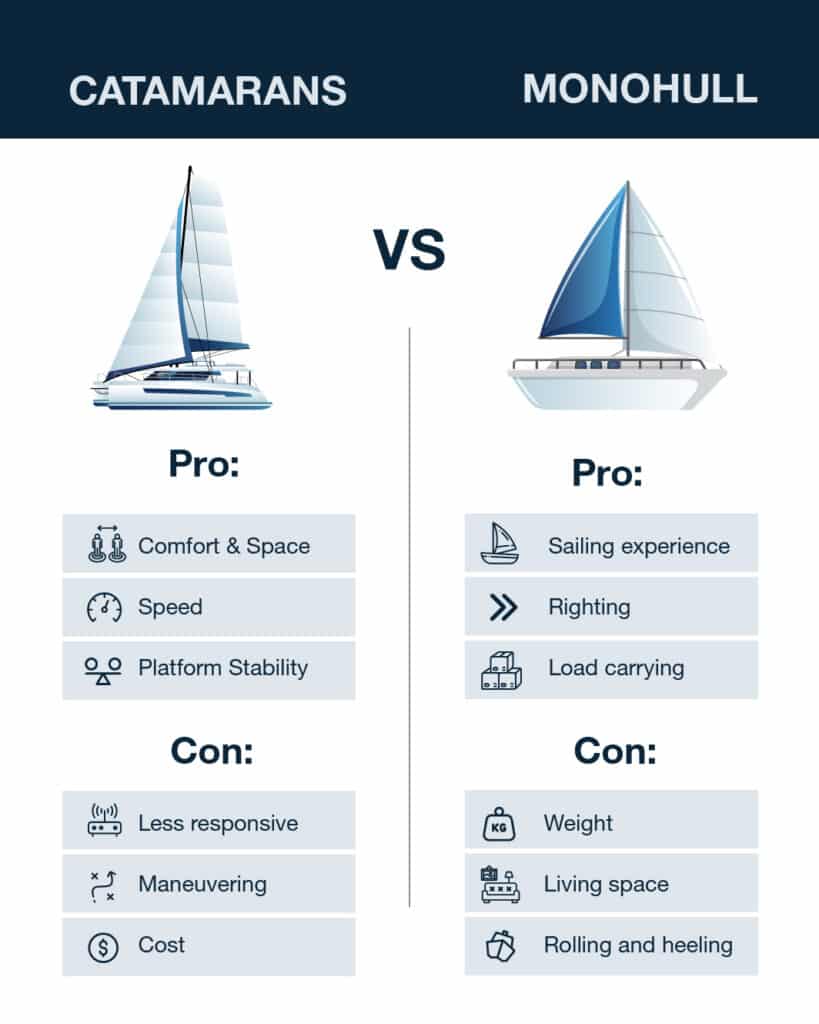
The Strengths and Pros
No matter your choice of monohull or catamaran, there are safe, comfortable, and excellent sailing boats of both types. Neither has an exclusive lock on any strength, and both sail safely and comfortably. But there’s a different emphasis on how they do it. No matter what you are trying to do – sail fast, cruise the world, or just host a crowd at the dock, there are monohulls and catamarans that can work for any requirement.
Catamaran advantages
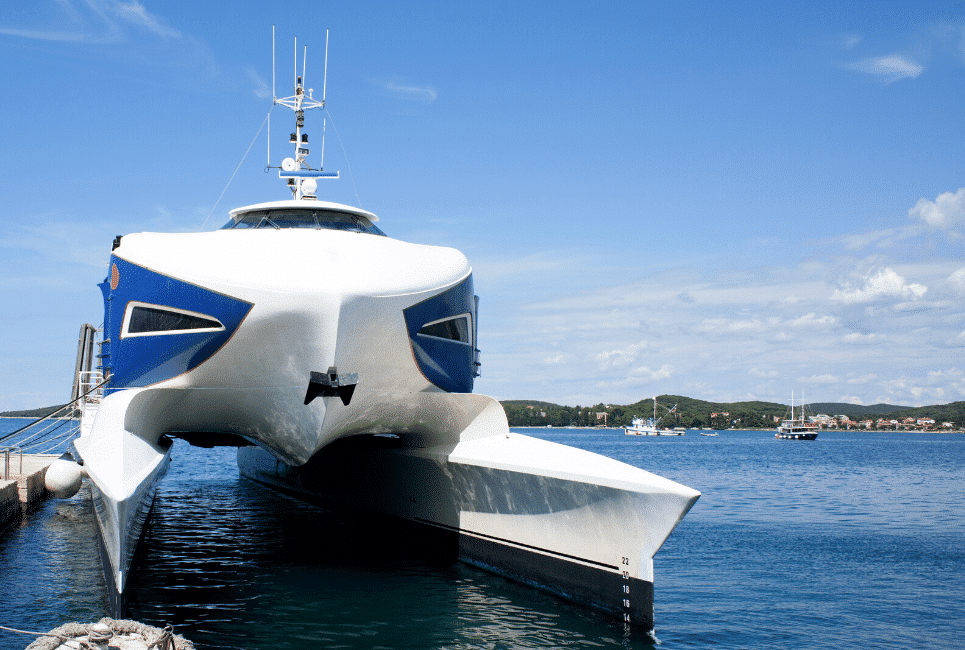
Space and comfort: Two hulls and a wide beam make a very stable platform with lots of volume in the saloon and cockpit. Most living space is above the waterline, with wonderful light and airflow. Cabins in the hulls offer better privacy and isolation, usually with standing headroom.
Straight line speed: Most catamarans are faster in straight-line sailing speed (1) that similar sized or even longer monohulls. Without a lead keel, they’re lighter, so more driving force from the sails converts to speed, and narrower hull forms may have less drag than wide hulls with deep keels. Some heavier cruising catamarans may not be faster, especially if they keep rig size small for ease of handling.
Stability : The beam of two hulls with a bridge deck leads to much higher stability and resistance to roll (2). Waves in an anchorage that induce violent roll in a monohull may make a catamaran bounce or bob. Under sail, catamarans do not heel appreciably even when powered up.
Twin engines. : With one engine in forward and balanced in reverse, most catamarans can spin in a circle in place and make sharp adjustments to the boat’s direction. If you have an engine failure, you also have a second engine, giving a safety edge when you can’t sail.
Monohull advantages

Upwind sailing performance: While catamarans have the edge at straight-line speed, monohulls sail closer to the wind. When you’re racing or you have to sail upwind to get to the next island, this can get you there faster.
Sailing feel and responsiveness : The “feel” of sailing a monohull is much better. With a single hull, you’ll feel wind pressure and trim adjustments immediately for a more responsive helm and a better ability to sail to the wind.
Maneuvering under sail: Monohulls are quite nimble tacking and turning under sail, and there’s less risk of slow or missed tacks.
Righting Moment: The primary offshore safety argument for monohulls is their ability to right when capsized. The heavy keel keeps the boat deck up when sailing, and most monohulls will come back upright even after a complete capsize.
Cargo and Loading: A higher displacement boat with thousands of pounds of lead hung from the bottom isn’t going to be as affected by loading as a relatively light multihull.
Aesthetics: This is subjective, as many catamaran enthusiasts love how they look. Classic sailboat styling, with swept sleek looks, springy sheer lines, and all the “right” proportions are more common on monohulls.
Also read: The 5 Best Electric Anchor Winches
Weaknesses and Cons
Like strengths, weaknesses are relative; just because one class has a strength doesn’t mean the other doesn’t. There are spacious monohulls and beautiful catamarans, just like there are cramped catamarans and unattractive monohulls. The differences have to be highlighted relative to each other, and the weaknesses of one are most apparent compared to the strengths of the other.
Catamaran Cons
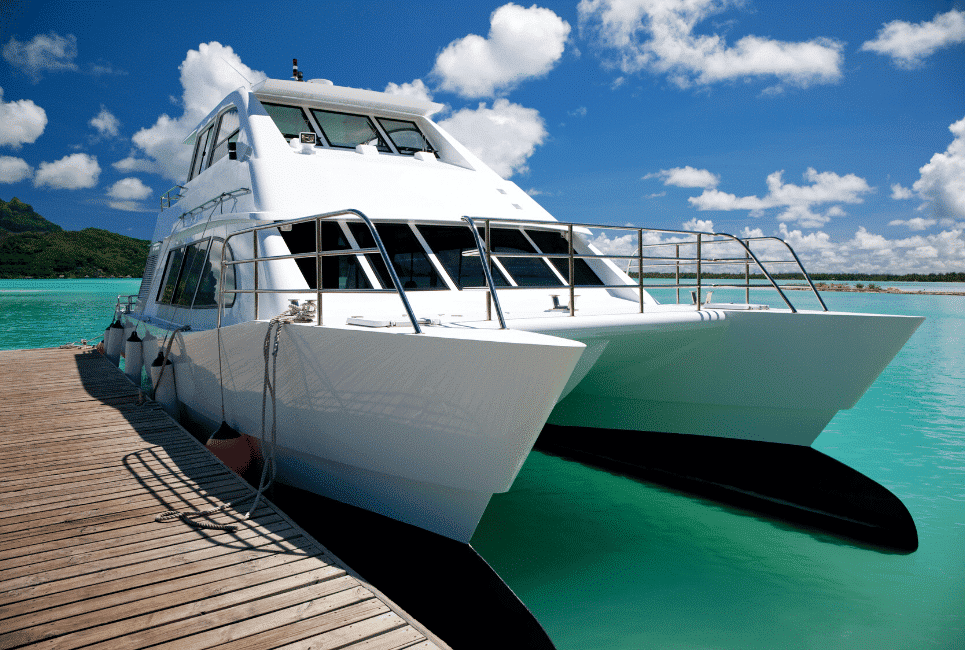
Upwind performance: Cats don’t sail as close to the wind, but they make up for it by sailing faster off the wind. You’ll sail a less direct course upwind. Even if you get in at the same time, you’ll have to sail farther.
Less responsive sailing: Two hulls with two rudders and a very broad platform reduce the helm feel when sailing, cutting responsiveness sailing in shifting wind and wave conditions. It also makes tacking slower.
No-flip zone: It is very difficult, but not impossible, to flip a large catamaran (3). But if a catamaran capsizes, it will not flip back over by itself.
Large in marina/close quarters: You have two problems in marinas. Beamy cats are tough to maneuver in tight spaces because they’re big and visibility is tough over the hulls. And many marinas charge extra because the wide beam extends into the next slip. The good news is that twin engines make tight maneuvering easier.
Price point: Catamarans are more difficult to build and need more materials. This is directly reflected in the cost of the boats.
Monohull Cons
They are heavier: Every large monohull needs a keel for stability (4). They can not sail or stay upright without thousands of pounds of ballast, and this makes them heavier and slows them down. Tiny monohulls can use a centerboard or daggerboard for stability, but most boats big enough to sleep on need ballast.
Darker interiors : Most monohull living space is lower in the boat, where you can’t put enormous windows for light and circulation. It’s very hard to get space as bright and airy as catamaran saloons.
Less living space: With one hull and no bridge deck saloon, most monohulls feel cramped compared to spacious catamarans.
More prone to rolling motions : Only one hull makes monohulls susceptible to rolling in waves, and the movement can be quite uncomfortable.
Heeling: Tipping is just part of sailing monohulls upwind and is unavoidable. It can be reduced on some other points of sail, but not eliminated. Many people, especially non-sailors and new sailors, find this movement uncomfortable or distressing.
You might also be interested in: How to Buff a Boat | A Detailed Guide by a Boating Expert

Troubleshooting Pontoon Boat Battery
Pontoon boats are a great way to enjoy the water and spend quality time with family and friends. But just like any other boat, they rely on a battery to power various systems, including navigation lights, trolling motors, and other…
Boat Accessories

Best Ice Fishing Fish Finders in 2023
In search of the best ice fishing fish finders in 2023? Not all fish finders are created equal, particularly when it comes to ice fishing. Specialized features are crucial to ensure successful outings in harsh winter conditions. You require a…

Best Side Imaging Fish Finders in 2023
Navigating the world of angling equipment can be challenging. That's especially true when it comes to side imaging fish finders, given the extensive range of options available in 2023. This post makes it easy for you to narrow down your…

How to Choose a Fishfinder for Your Boat: A Comprehensive Guide
Today, we embark on a journey to unravel the secrets of choosing the perfect fish finder for your boat. As we navigate through an ocean of options, we'll explore different types of fish finders, delve into their key features, and…
Accessories
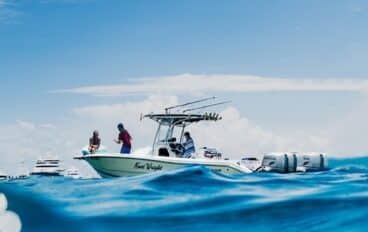
5 Best Portable Fish Finder in 2023
Looking for a portable fish finder for kayaking, ice fishing, or other activities? The good news is that there are a lot of solid products out there. The year 2023 has ushered in an array of advanced models, each brimming…
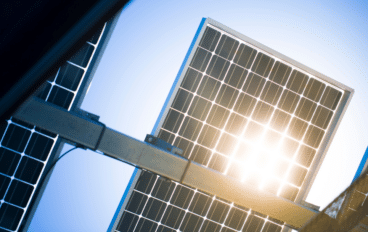
Charging Your Trolling Motor Battery with a Solar Panel
Charging your trolling motor battery with a solar panel is not just the right thing to do for the environment, it is extremely convenient. When you’re out on the boat, with any luck, you’ll have access to a good amount…
Don't miss out

Catamaran vs Yacht

When getting into sailing, there are so many types of boats you can choose from—pontoons, tritoons, catamarans, yachts, sailboats, fishing boats, deck boats—and all of them have different advantages and disadvantages when getting out into the water. But when it comes to a catamaran or a yacht, which is better, and what are the costs to calling one your own?
Table of Contents
What is a catamaran?
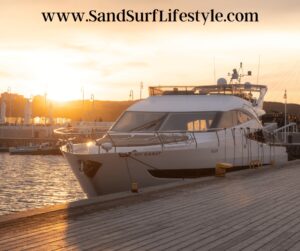
Catamarans come from the peoples of the Indian and Pacific Oceans, who used this form of boat to expand from island to island. The word itself is derived from the Tamil word “kattumaram” which means “logs bound together.”
Because of their construction, they usually have less hull volume, which means they have a shallower draft and a smaller displacement. They are also more hydrodynamic comparatively and require less power than another monohulled boat of the same size. The wide hull of the catamaran also reduces the likelihood that it will heel, or start to roll, in the wind. The wide stance also reduces the wake that the boat gives off.
It is possible to race with catamarans, especially if you are looking for both speed and stability overcapacity. Catamarans built for recreation and sport can be launched and landed from a beach and usually contain a crew of two.
What is a yacht?
A yacht is a blanket term for a boat that uses either sails or power for cruising, racing, or pleasure. While there is no real definition for a yacht, they are typically any sort of boat that has a cabin for overnight use and is a pleasure vessel over 30 feet in length.
There are different sizes of yachts under certain designations—any yacht over 79 feet is considered large, while any yacht over 131 feet is considered a superyacht or megayacht.
The word yacht comes from the Dutch language, which means “hunt.” It started as the name of the fast-sailing ships that the Dutch used to hunt for pirates in the 18th Century. The concept of pleasure boats, though, started early in the world’s history in Egyptian times and only increased in popularity as time went on.
There are several types of propulsion for yachts—sailing, which is when they use sails to catch the air and power. Yachts first started with steam power before turning to the internal combustion engine.
Most yachts, if large enough to accommodate, have a main salon and a forward stateroom in terms of cabins. The larger the yacht, the more rooms it may have.
Catamaran vs. Yacht: Structural Differences
If you are looking for a cruising catamaran, you will need a larger boat than the monohull counterparts. While a monohull can be small, usually around 30 feet, if you want the same sort of carrying capacity out of a catamaran, you will need a boat upwards of 40 feet.
Because of their larger size and width, catamarans will take up more space in your marina, but they are also more spacious than other boats—that width is not put to waste on the deck or underneath.
The double-hulled catamaran also gives more privacy when it comes to the living spaces—the cabins are conveniently separated, keeping the living quarters and sleeping quarters apart on most catamarans.
Looking to purchase a catamaran? Here are the pros and cons of owning one.
Catamaran vs. yacht: performance differences.
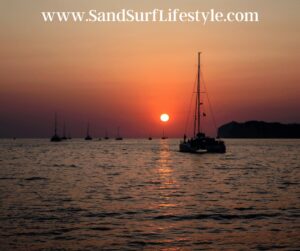
That speed, though, comes at a price—because they have two hulls, you will hear the water slapping against the boat from underneath, which is something you do not get with a monohulled boat.
Because they have two hulls, catamarans are nearly resistant to any sort of heeling, compared to a yacht. They also have extremely high resistance to capsizing, due to their multi-hulled construction. This stability allows for passengers to easily navigate the deck without fear of suffering from wave action. This stability will also let you cook and do any other activities on the deck without fear of displacement.
Catamarans are also easier to handle than another type of boat—one person can singlehandedly sail such a vessel. Because you have two engines and two rudders, it is easier to dock and maneuver compared to a monohulled boat.
Yachts tack much quicker than a catamaran as well—when you turn into the wind so you change which direction the wind blows on the ship—meaning your catamaran will slow down significantly as you turn. A monohull is more maneuverable in the wind.
Catamaran vs. Yacht: Cost Differences
A new, high-quality catamaran larger than 40 feet can run about half a million in cost. Pre-owned catamarans can run as low as $35,000, while larger, new catamarans can exceed $5 million.
Catamarans will also cost more because of the need for two engines and two rudders. The double hull means more equipment, which therefore increases the price. They also use different types of materials, making that cost increase. They also are typically higher quality construction and are safer and easy to sail, pushing the price higher. Because of this equipment increase, your service costs will also be higher.
If you are looking for a smaller yacht, those would put you within the 50 to 70 feet range. Choices also include the engine and optional equipment, along with whether you intend to purchase a new or a pre-owned yacht. New yachts in this size range can run about
Pre-owned yachts of this size can run anywhere between $300,000 for a smaller model to almost $6 million for a larger one. Most around 50 feet are an average of $375,000.
Catamaran vs. Yacht: Which is better?
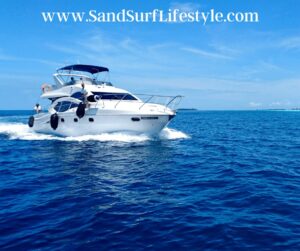
If you want to stay with the traditional sailing experience with more feedback about how your ship is moving, along with keeping a smaller footprint both on the water and in the marina, a yacht is the way to go. They are much more maneuverable than a catamaran in the water. Yachts are also cheaper than a catamaran.
Regardless of what you’re looking for in a boat, the choice remains with you about what you value most in your travels. Whether it’s a catamaran, a yacht, or something entirely different, know what you are looking for in your vessel before going out and looking to buy.
Please note: This blog post is for educational purposes only and does not constitute legal or medical advice. Please consult a legal expert or medical professional to address your specific needs.
Aloha! My name is Shawn and I Love the Beach and Ocean! From surfing to beach sports to boating and fishing I like it all. More importantly, I Love the people I get to meet who also share a passion for the sand and surf. Living and growing up near the ocean my heart has always been connected to the beach and its lifestyle. I wish to share my experience with those around the world. Mahalo (Thank You) for visiting and enjoy your stay here on my site!
Recent Posts
Adaptive Surfing: Overcoming Challenges and Inspiring Stories
Adaptive surfing has truly opened my eyes to the power of resilience and determination. The sport's inclusive nature has broadened my perspective and highlighted how adaptive surfers face and...
Spotlight on Surfing Destinations: Hawaii Edition
Exploring Hawaii's Surfing ParadiseSurfing in Hawaii has been a dream come true for me, as it's where I've discovered some of the most incredible waves and surfing cultures in the world. In this...
- 2024 BOAT BUYERS GUIDE
- Email Newsletters
- Boat of the Year
- 2024 Freshwater Boat and Gear Buyers Guide
- 2024 Boat Buyers Guide
- 2024 Water Sports Boat Buyers Guide
- 2024 Pontoon Boat Buyers Guide
- Cruising Boats
- Pontoon Boats
- Fishing Boats
- Personal Watercraft
- Water Sports
- Boat Walkthroughs
- What To Look For
- Watersports Favorites Spring 2022
- Boating Lab
- Boating Safety
- Ultimate Boating Giveaway

Catamaran Versus V-Hull: Which Rides Better?
- By Kevin Falvey
- Updated: December 2, 2004
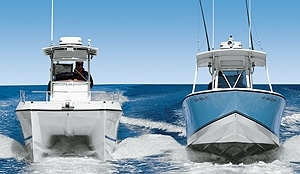
The controversy rages in dockside watering holes, tackle shops, and Internet chat rooms: Which rides better-a catamaran or a V-hull? So far, all the talk has been purely subjective: A cat feels like this, a V-hull feels like that. To us, that’s useless. At Boating Magazine, we need hard numbers, things that we can quantify, then we’ll decide. So we took a Regulator 26, which just might be the best-riding V-hull for its size, and a Glacier Bay 260 Canyon Runner, one of the best-riding cats, and wired them with expensive sensing gear. Rather than a match between two specific boats, it would be a comparison of the finest qualities of each type. We expected the cat to be smoother when the going got rough, but what about the other times? Is it the most comfortable all-around boat? It took us a year-that’s right, one full year-to compile and understand the data, but here, finally, is the answer.
Measured Madness Our first problem was how to quantify a boat’s motion underway. The best tool we came up with is an accelerometer, which records changes and degrees of motion. We also had electronic gear to measure the boats’ angles, WAAS-enabled GPS units, rangefinders to measure distances, four laptops, stopwatches, plumb bobs, measuring tapes, and eventually, a collection of soggy notebooks.
To help us make sense of what we compiled, and back up our conclusions, we enlisted two top naval architects. So we’d like to thank Rick Strand, president of Strand Technologies, a consultant to companies such as Tillotson-Pearson, Boston Whaler, and Brunswick; and John H. Deknatel, president of the legendary design firm C. Raymond Hunt Associates.
With their help, the evidence became clear. What we discovered should silence the know-it-alls and may surprise the enlightened. Without question, we’ve killed the controversy. The boat type with the most comfortable ride is…
Not so fast-to understand our answer, you need to know how we approached the question.
Three Easy Pieces First, we wanted to measure how differently cats and V-hulls turn. To do this, we set up a buoy and had each boat make the tightest 180-degree turn it could at 30 mph. The diameter of each boat’s turn was about the same, although the V-hull averaged 8.4 seconds compared to the cat’s 8.9 seconds. The important difference, however, was how each banked in the turn.
Our electronic angle indicator showed the cat leaning outward by 26 degrees. The unit may have been over-reading due to outward force, but none of the techies from the indicator’s company could confirm this and they therefore stand by its number. By any measure, the cat did lean outward at a steep angle, which can be disconcerting to say the least. Loose gear slides more when a boat leans opposite the turn, and the push that occurs at the apex can make you feel as if you’re going to be thrown out. Of course, with time, you can get used to this. Furthermore, the lean can be minimized by trimming up the outboard engine and trimming down the inboard.
In contrast, the V-hull banked inward by 10 degrees. This not only feels natural, it also has a practical advantage. Centrifugal force pins you and your deck gear into the boat, and you need no special trimming techniques-just turn the wheel.
Both boats are designed for fishing, so our second test was to see how each fared while drifting.
To start, we measured each boat’s roll period-how long it takes to roll all the way to one side and back again. Too short a roll period foretells a jerky motion at sea, too long may mean there’s not enough initial stability. The cat’s period was 2.2 seconds. The V-hull’s was 2.4 seconds, almost 10 percent slower-which in this case is good.
Given our experience with a cat’s less-than-gentle motion at drift, we expected its period to be a lot shorter than the V-hull’s. In hopes of explaining this, we headed out into the ocean.
After the two boats took their natural drift angle in four-foot waves, we looked at the mean G forces each experienced. The cat showed 0.92 Gs, and the V-hull showed 1.18 Gs. So the cat is more comfortable, right?
Not quite. On average, it took the cat 1.15 seconds to reach those Gs, whereas it took the V-hull a little longer at 1.17 seconds. That is, the V-hull accelerated 2 percent slower than the cat. And, as we’ll get into later, slower accelerations equal more comfort.
The results from the accelerometer confirm our roll period tests. The cat, with its greater initial stability, resists rolling. When you stand on its rail at the dock, you notice it hardly leans at all. Most folks think this stability makes for a better boat offshore. But that same resistance to listing at the dock causes a cat to follow the contour of the waves while drifting. The steeper the wave face, the more the cat leans over.
The V-hull has less initial stability, so it gives a bit to your weight at the dock-and to oncoming waves. Its ability to roll easier means it’s not forced to follow the contour of the wave. Instead, as a wave approaches, the boat leans toward it, levels out at the crest, and then leans back into the retreating wave on the way down. In this way, it’s trying to remain level, rather than trying to conform to the angle of the water it’s floating in.
Our third test was to see how smooth each boat ran on a “perfect” boating day, one with a small one-to-two-foot chop on an open bay and a 10-mph breeze. We ran the boats side by side, and the differences shown on the accelerometer were negligible.
So far, after three tests, the V-hull had come out on top in two, and both boats were about equal in one.
We Take It Outside “But what about how they ride when it’s rough?” we hear you ask. “That’s what we really want to know.” And we plan to tell you. But our contention is that there’s more to boating-and enjoying it-than this one element. Unfortunately, and unfairly, bar talk often centers around this, so here we go.
We chose a day when the waves were four to five feet with a six-second period-your typical “rough day.” We ran the boats 100 feet apart at 29 mph directly into the waves. It didn’t matter which boat we were in, it was uncomfortable. Anyone but a masochist would slow down or change course, but we’re here for science.
The graphs on page 86 (see “Graphic Violence”) represent the two boats hitting the same wave. Sharp readers will note that the impacts shown for the two do not exactly coincide. The time each boat hits a wave varies, and a given wave isn’t consistent in shape over its length. Since the boats couldn’t be tied abreast of each other, this is the best anyone can do.
We made numerous runs. For statistical accuracy, we examined seven individual waves for each boat and on each run.
Before giving you the numbers, let’s just say that our accelerometer numbers are dead accurate. But on test day the time between entering a wave, bottoming out, and leaving the wave occurred in less than 0.3 seconds-which is not uncommon. According to Deknatel, “That’s too short a time for your body and brain to process the full effect of the event.” The accelerometer, however, is capable of measuring what we can’t feel.
To accurately compare the ride for a real human, not the machine, you need to look at more than just the peaks of the graph (maximum G force). You need to look at the steepness of the graph’s slope (the time it takes to reach that force), too. A boat that develops more Gs doesn’t necessarily mean it has a harsher ride. It depends on how fast that force is applied. For example, if your 250-pound buddy gently leans on you, what you feel is different than if he were to hit you with a running tackle.
The curve for the cat peaks at 3 Gs; the V-hull, on the other hand, peaks at 4, meaning the cat has 25 percent less gravitational force.
We can also see that the cat consistently decelerated slower when it hit the wave than the V-hull did. It had an average deceleration of 0.287 seconds, compared to the V-hull’s 0.081 seconds-which is 3.5 times faster.
The cat not only landed with less force, it decelerated slower as well. The two combined say it has the more comfortable head-sea ride.
Our test day was rough, so much so that our testers were hard-pressed to say from their gut which rode softer. But, again, the machine is more sensitive than any human, and numbers don’t lie: The cat’s numbers were clearly better.
Later tests also showed the cat delivered lower Gs and slower decelerations while running downsea, in quartering seas, and in the trough. So it’s the most comfortable boat right? Well, not so fast.
Rough Guide We weren’t through testing yet-although some tests were hardly high science.
For example, to see how wet riding each hull was, we taped paper towels to the front of the console. Cats often “sneeze,” or throw a fine mist on certain headings. In this case, and even in the test day’s rough conditions, both sets of towels came back dry.
Then there were issues we couldn’t quantify, such as how a V-hull can dig in its bow going downsea to occasionally make steering difficult, or how in quartering seas a cat’s two hulls catch at different times, requiring constant small steering adjustments.
And there were things that we didn’t have time to test, such as the effect of weight. Typically, a V-hull rides better as it gets loaded down with gear and fuel, which is just the opposite of a cat. Also, our offshore tests were on closely spaced waves. On widely spaced rollers, where boats become airborne, the results would have been different.
In the end, for many boaters, especially those who seem to spend more time in gin mills and chat rooms than on the water, ride quality simply means how softly a boat handles head seas. By that standard, as measured by our accelerometers, and in our test conditions, the cat was the clear winner.
But ask yourself, how often do you go out in weather like that? To make the results of our tests worthwhile for you, ask yourself, “Which boat rides better in the conditions I expect to meet?”
For example, if you have to run far and fast to get to an offshore fishing ground, the cat is a better choice. If you fish close to home, and drift or troll more than flat-out running, the V-hull would be better.
Take all our tests into consideration, and the boat you buy will be the right boat-your Mr. Smoothie.
- More: Boats , express fishing , Fishing Boats , glacier bay catamarans , multipurpose , versus
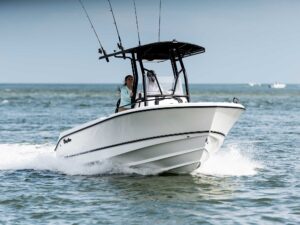
Boat Test: 2024 EdgeWater 208CC Watchman
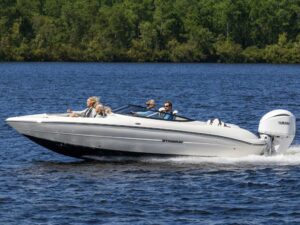
Boat Test: 2024 Stingray 23 OSX
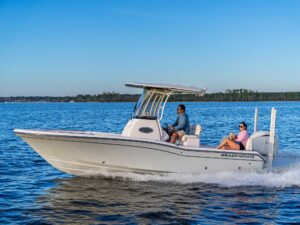
Boat Test: 2024 Grady-White 231 Coastal Explorer
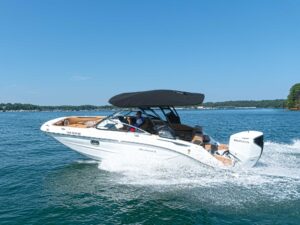
Boat Test: 2024 Hurricane SunDeck 2600 OB
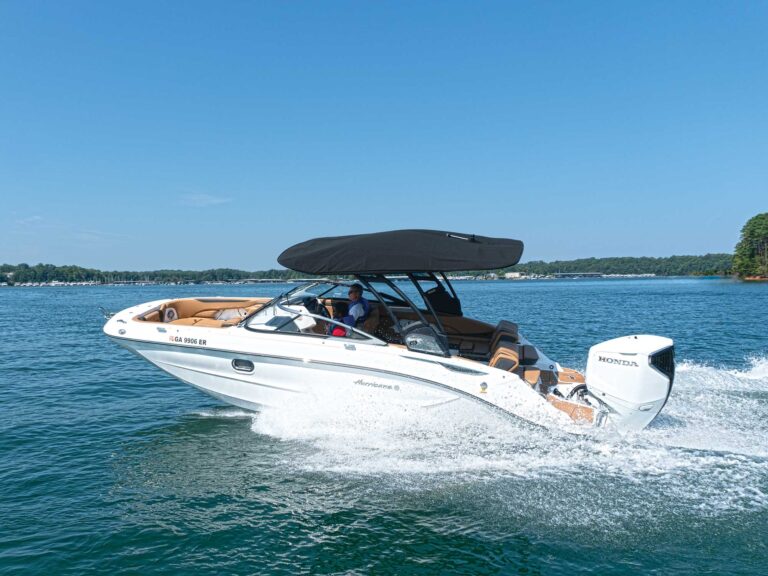
Boat Test: 2024 Brabus Shadow 1200 Sun-Top
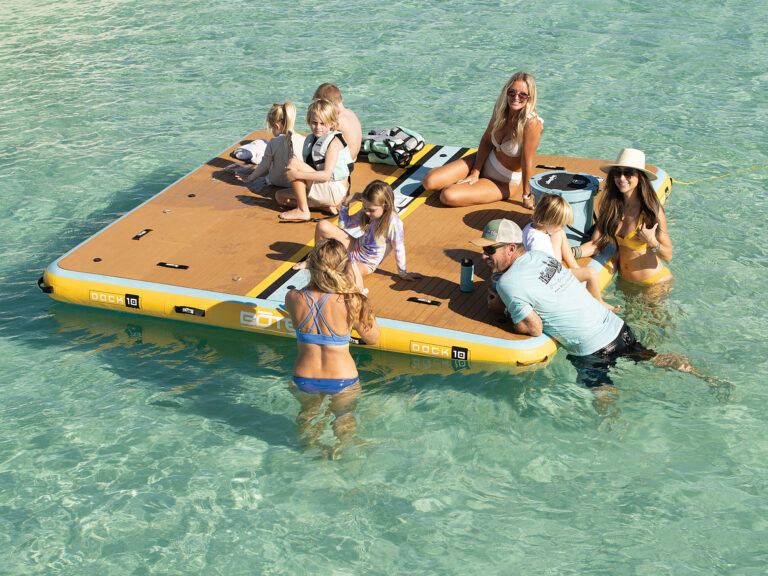
Inflatable Water Mats for Boaters
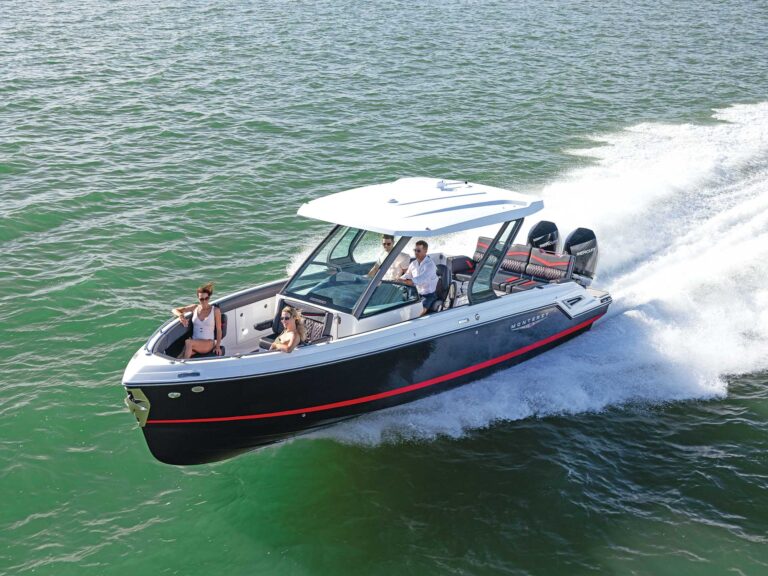
Boat Test: 2024 Monterey Elite 30

- Digital Edition
- Customer Service
- Privacy Policy
- Terms of Use
- Cruising World
- Sailing World
- Salt Water Sportsman
- Sport Fishing
- Wakeboarding
Many products featured on this site were editorially chosen. Boating may receive financial compensation for products purchased through this site.
Copyright © 2024 Boating Firecrown . All rights reserved. Reproduction in whole or in part without permission is prohibited.
- Skipper Club
- Skipper App
Katamaran: Alles Wichtige zur Yacht mit zwei Rümpfen
Wohl über kaum eine Bauart von Segelyachten wird so viel diskutiert wie über Katamarane. Über die Zweirümpfer scheiden sich die segelnden Geister: manche Segler lieben die Vorteile und schwören auf Katamarane, andere bevorzugen klassische Einrumpfyachten und halten sie für die besseren Segelyachten.
Katamaran: Die Vorteile der Zweirumpf-Yacht
Egal, ob Katamaran oder Einrumpfyacht: Beide Bootstypen haben ihre Pros und auch Contras. Ob Du Dich für eine Segelyacht mit zwei Rümpfen entscheidest oder lieber ein Monohull bevorzugst, ist letztlich auch eine Glaubensfrage und hängt von der persönlichen Vorzügen, Ansprüchen und vom Geschmack ab. Was aber unterscheidet Segelkatamarane von Einrumpfbooten? Wo liegen die Vorteile, welche Nachteile bringt die Bauart mit sich?
So segeln Katamarane
Die Segel-Eigenschaften von Katamaranen zeigen, wie Nachteile durch Vorteile aufgewogen werden können und wie stark sich beide Bauformen voneinander unterscheiden:
Grundsätzlich gilt, dass Katamarane schneller segeln als Kielyachten mit einem Rumpf. Es gibt weniger benetzte Fläche und keinen Kiel – was den Widerstand im Wasser reduziert und zu wesentlich mehr Topspeed führt – luvwärts bis zu einem Viertel mehr Geschwindigkeit, leewärts bis hin zum doppelten Speed im Vergleich zu Monohulls. Dieser Vorteil gilt jedoch nur, wenn der Wind nicht „auf die Nase“ kommt. Katamarane laufen deutlich weniger Höhe , sind also kaum in der Lage „an der Kreuz“ zu segeln.
Dadurch ergibt sich allerdings wiederum ein Umstand, den viele Segler und Crews als Vorteil ansehen: Katamarane krängen nicht oder nur unmerklich. Das Segeln ist sehr viel komfortabler und die Arbeit an Deck ohne Schräglag e leichter. Oftmals ist aber eine größere Crew erforderlich, da die Wege länger sind und alle Bedienelemente, wie Schoten, Winschen und Trimmeinrichtungen weiter voneinander entfernt sind. Um einen Katamaran einhand zu segeln, bedarf es viel Erfahrung und ein entsprechendes Bedienlayout.
Wichtig bei Katamaranen ist ein ausgewogener Gewichtstrimm. Zweirumpfboote sind wesentlich anfälliger für eine falsche Gewichtsverteilung, die sich schneller in den Fahrt- und Segeleigenschaften niederschlägt.
Hafenmanöver und Ankern mit einem Katamaran
Auch bei den Manövern unter Maschine(n) im Hafen zeigen sich sowohl starke Vor- als auch Nachteile: Die meisten Kats besitzen zwei Antriebe, in jedem Rumpf einen. Durch die unabhängige Steuerung lassen sich Katamarane somit auch in engen Häfen und Boxengassen sehr gut manövrieren, ja sogar „auf dem Teller drehen“. Dadurch, dass allerdings weniger benetzte Fläche im Wasserbefindet und auch kein Kiel vorhanden ist, vertreiben Katamarane bei Wind schneller. Außerdem sind die Kats breiter, was die Auswahl an Liegeplätzen reduziert.
Beim Ankern zeigen sich indes die großen Vorteile: Kats schaukeln nicht oder nur wenig. Schwell macht ihnen nicht viel aus und das Liegen vor Anker in der geschützten Bucht ist wesentlich ruhiger, auch bei viel Schiffsverkehr. Außerdem können auch für Kielyachten unerreichbare Buchten und Wasserflächen erreicht oder überfahren werden, weil die Zweirümpfer kaum Tiefgang besitzen. Das gleiche gilt fürs Trockenfallen in Tidenrevieren. Hier haben Kats klare Vorteile.
Sicherheit auf einem Katamaran
Katamarane haben alles Wichtige, was es auf einem Segelboot zur Steuerung gibt, gleich zwei Mal, wie Ruderblätter und Antriebe. Fällt ein Motor aus oder bricht ein Ruderblatt, ist Ersatz vorhanden und das Boot bleibt manövrierfähig. Gerade auf weiten Törns ist das ein nicht zu unterschätzender Sicherheitsaspekt. Hier punkten Katamarane klar.
Nachteilig im Bezug auf die Sicherheit ist dagegen der Umstand, dass Katamarane – sollte es zu einer Kenterung kommen, sich nicht wieder aufrichten, sondern eher durchkentern und auf dem Rücken liegen bleiben. Dieser Fall ist zwar recht unwahrscheinlich, kann aber durchaus vorkommen. Ein Monohull mit einem entsprechenden Ballastkiel richtig sich dagegen in aller Regel wieder auf. Die meisten Hersteller und Werften von Katamaranen versprechen jedoch, dass ihre Yachten unkenterbar sind.
Dazu kommt: der komfortable Aspekt, dass Katamarane nicht krängen, kann durchaus auch von Nachteil sein. Einrümpfer zeigen durch Krängung an, wann der Winddruck in den Segeln zu hoch wird und der Moment kommt, an dem gerefft werden sollte. Um diesen Punkt bei einem Katamaran zu erkennen, Bedarf es an Erfahrung und Kenntnissen über das jeweilige Boot.
Im Fall der Fälle, also zum Beispiel beim Durchkentern, bieten Katamarane dagegen eine Art Rettungsfloß, weil sie durch ihren großen Auftrieb als nahezu unsinkbar gelten und somit im Bezug auf die Sicherheit wiederum punkten.
Komfort an Bord eines Katamarans
Beim Thema Komfort an Bord lässt sich vorweg eines feststellen: Hier zeigen sich Katamarane von ihrer allerbesten Seite und verfügen ausschließlich über Vorteile. Das Platzangebot ist riesig – vom Cockpit über Decksfläche bis zum Lebens- und Wohnraum. Beide Rümpfe bieten Platz zum Wohnen und Leben, für Nasszellen und Stauraum. Und zwischen den beiden Rümpfen bietet ein meistens riesiger Decksalon eine enorm große Fläche mit viel Komfort und Lebensraum bei bester Rundumsicht mit viel Lichteinfall. Das Gefühl, unter Deck „im Keller“ zu sitzen, gibt es bei Katamaranen nicht. Auch an Deck gibt es viel Fläche, um zum Beispiel in der Ankerbucht nach dem Tauchgang in der Sonne zu liegen.
Gerade durch das Thema Komfort und Platzangebot sind Katamarane in den letzten Jahren immer beliebter geworden – sowohl als Charteryachten als auch als ideale Segelboote für Langzeit- und Blauwassersegler sowie für Familien. Gerade als Charteryacht liegen die Vorteile auf der Hand, denn durch das große Platzangebot gibt es mehr Kojen, mehr Nasszellen und somit mehr Privatsphäre für die Crewmitglieder.
Letztlich zahlt auch die hohe Stabilität auf dem Wasser ohne merkliche Krängung und ohne größere Schaukelbewegungen bei hoher Geschwindigkeit auf den Punkt Komfort ein.
Katamaran kaufen: Aktuelle Angebote von gebrauchten Katamaranen zum Segeln
Segel-Katamarane sind beliebt und seit Jahren weit verbreitet. Dementsprechend groß ist das Angebot an gebrauchten Katamaranen.
- Hier geht es zur Übersicht an aktuellen Gebrauchtangeboten für Segel-Katamarane
Fazit zu Katamaranen
Das Segel-Katamarane sich seit mehreren Jahren auf der Erfolgsspur befinden, verwundert angesichts der vielen Vorzüge nicht. Großes Raumangebot, hohe Stabilität, gute Segelleistungen, der flache Tiefgang und der hohe Komfort machen Zweirümpfer unter Seglern sehr beliebt. Ob ein Katamaran beim Kauf in Frage kommt, ist letztlich eine Geschmacksfrage.
Das könnte Sie auch interessieren
Blauwasseryachten: auf langer fahrt zuhause, schlauchboote, gebrauchtboote.
- email senden
Willkommen an Bord, Bootsfahrer!
Bootsfahrer ahoi: werde mitglied im exklusiven adac skipper club und gestalte unsere services nach deinen wünschen aktiv mit..
Zum ADAC Skipper Club

- Maßgeschneiderter Segelurlaub
- Segeltörn Familie mit Kindern
- Romantische Segeltörns
- Segeln mit Freunden
- Griechenland All Inclusive Yachtcharter
- Kroatien All Inclusive Yachtcharter
- Kabinencharter
- Wein und Schlemmerroute
- Luxuriöse Yachtcharter
- Griechenland
- Über Sebastus
Segelboote vs. Katamarane: was ist der Unterschied
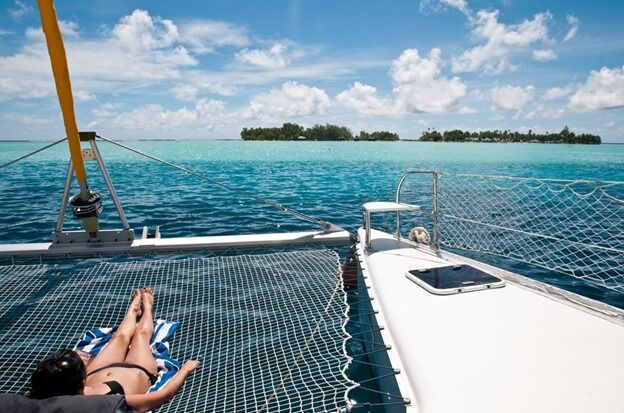
Wenn es eine Debatte gibt, die in der Segelwelt niemals endet , dann ist es die über Segelboote und Katamarane. Und es gibt Fans auf beiden Seiten.
Manche lieben einfach nur Monohull und andere können nicht genug von den guten alten Katamaranen bekommen. Beide Gruppen haben sehr starke Argumente und beide Schiffstypen haben Vor- und Nachteile.
Diese heftige Segel Debatte wird so lange andauern, wie es das Meer zum Segeln gibt, also ist es besser, einfach daneben zu bleiben und zu hören, was sie zu sagen haben. Die meisten von ihnen stimmen sicherlich zu, dass viele ‚Argumente‘ aus dem persönlichen Geschmack und der Referenz kommen.
Auf der anderen Seite sind die meisten Argumente harte Fakten. Nichtsdestotrotz wird diese Debatte den Segler vielleicht helfen, das perfekte Boot zum Mieten auszuwählen.
Zum besseren Verständnis des Raumes, den ein Katamaran oder ein Segelboot bietet, haben wir für Sie ein Layout vorbereitet:
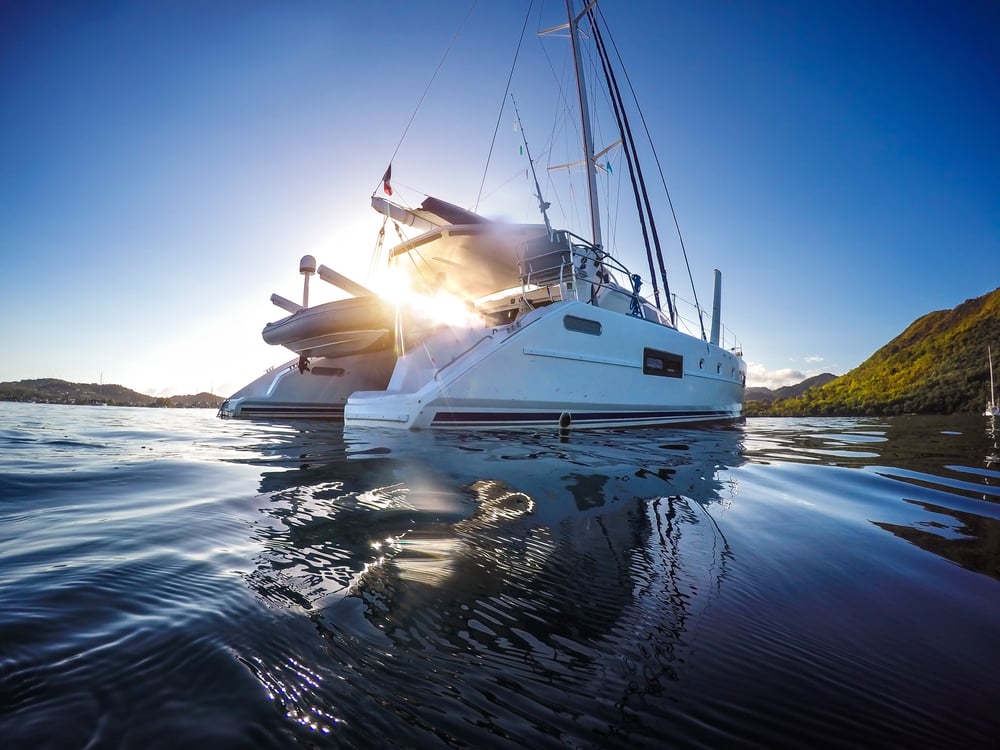
Vor- und Nachteile Segelboote und Katamarane
Stabilität und sicherheit.
Das erste, was die zukünftigen Segler interessiert, ist die Stabilität und dementsprechend die Sicherheit. Und wenn wir über Stabilität sprechen, sprechen wir über Krängung.
Alle sind sich einig, dass die Krängung bei Katamaranen aufgrund ihrer Form und ihrer Gewichtsbelastung sehr gering ist. Einrumpf Liebhaber argumentieren, dass sich die Segel aufgrund dieser Stabilität nicht selbst krängen können, die Rümpfe strapazieren sich und das macht die Reise laut.
Sie sagen auch, dass die Krängung auf dem Segelboot tatsächlich die Stabilität erhöht und Wind Brüche aus den Segeln heraus schlägt.
Wenn man über Sicherheit spricht, ist das Hauptargument für Katamarane, dass sie unsinkbar sind.
Segelboote können sinken, aber sehr selten kentern, weil sie bessere Fähigkeiten zum Aufrichten haben.
Diejenigen, die Katamarane lieben, sagen, dass es besser ist zu kentern, als zu sinken, aber die andere Seite argumentiert, dass man, wenn man gekentert ist, so gut wie fertig ist.
Die Fähigkeit des Richtens gibt die Chance, mit den Wellen zu kämpfen. Harte Argumente auf beiden Seiten.
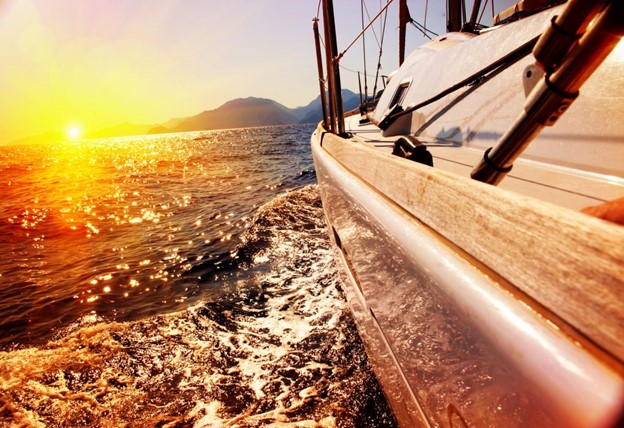
Geschwindigkeit & Handhabung
Wenn es um die Geschwindigkeit geht, sind Katamarane sicherlich schneller als Segelboote. Das liegt daran, dass bei Einrumpfbooten mehr Oberfläche unter dem Meeresspiegel liegt und somit der Widerstand des Meeres viel höher ist.
Viele Leute sind sich einig, dass die Fahrt mit Katamaranen wegen der hydrodynamischen Konstruktion der Segelboote, die sich an das Meer anpasst, unbequemer ist als mit Segelbooten.
Bei aller Fairness, beide sind extrem komfortabel, dies sind nur kleine Details.
Wenn es um die Handhabung geht, so spricht man bei Katamaranen von zwei Motoren, die getrennt voneinander arbeiten können, um besser manövrieren zu können. Außerdem haben Katamarane einen geringeren Tiefgang, was gut für flache Buchten und Meeresbuchten ist.
Starke Argumente für Segelboote sind, dass sie leicht plötzliche und scharfe Wendungen machen können und auch in engen Meerengen problemlos zu handhaben sind.
Unterhaltung & Preis
Wenn man die Unterhaltungskosten betrachtet , sind Katamarane teurer, weil sie größer sind und von allem zwei haben.
Das Gute daran ist, dass Katamarane mit halber Leistung laufen können, d.h. wenn ein Motor aus irgendeinem Grund nicht funktioniert, kann man trotzdem segeln gehen.
Mit einem Segelboot kann man das nicht tun. Die Reparaturkosten für das Segelboot und der Preis des neuen Bootes zusammen sind wesentlich niedriger.
Aber Katamarane sehen auf dem Markt gut aus, es gibt eine große Nachfrage nach ihnen, wenn Sie also viel Geld für einen Katamaran bezahlt haben und jetzt denken, dass Sie nicht damit umgehen können, können Sie ihn sehr schnell verkaufen.
Noch besser, es ist immer eine elegante Lösung, es in Vermietung zu geben. Es wird seinen Wert in kürzester Zeit auszahlen, denn es gibt immer Kunden, die einen Katamaran mieten wollen.
Natürlich können Sie das auch mit dem Segelboot tun. Vielleicht ist die Vermietung die eleganteste Lösung von allen, weil Sie das Segeln ohne Sorgen um die Unterhaltung genießen können.
Segelbot vs. Katamaran – Wer Gewinnt?
In der Welt der Navigation gibt es oft verschiedene Meinungen darüber, was besser ist, Segelboot oder Katamaran.
Dieser Artikel präsentiert Ihnen Meinungen von beiden Seiten, aber wichtig ist nur, dass die Gründe meist subjektiv sind. Der beste Weg, um sich zu entscheiden, ist es, beide zu vergleichen und dann entscheiden, welche der beiden Ihren Bedürfnissen am besten entsprechen.
Wir bieten eine große Auswahl an verschiedenen Bootstypen zum Mieten und wenn Sie Hilfe bei der Wahl zwischen einem Segelboot und einem Katamaran benötigen, zögern Sie nicht, uns zu kontaktieren!
Kontaktieren Sie uns für die besten Segelurlaube
Artikel teilen:
Eine frage haben.
Wir haben Antworten auf Ihre Fragen. Zögern Sie also nicht, sich noch heute mit unserem Team in Verbindung zu setzen!
- Weitere Info erhalten
Möchten Sie bleibende Erinnerungen mit Ihrer Familie schaffen?
Buchen Sie Ihr unvergessliches Segelabenteuer mit Sebastus!
- Planen Sie Ihren Familienausflug
Bei Fragen zögern Sie bitte nicht, uns zu kontaktieren. Wir sind bereit! Lass uns segeln
Vielen dank für ihre anfrage.

IMAGES
VIDEO
COMMENTS
When it comes to maneuverability and sailing dynamics, there are some key distinctions between catamarans and yachts: Speed - Catamarans are lighter and have reduced drag, making them significantly faster than yachts. Top speeds can reach up to 25 knots. Stability - With their twin hulls, catamarans offer unmatched stability and minimal ...
The catamaran will move around with the wind, always staying flat, while the sailboat will rock from side to side and might even get you seasick. This is especially noticeable when the wind is opposing the waves, making the boat have the wind pushing it from one side and the waves banging it from the other side.
Space: Catamarans generally provide more living space. Overall Comfort: The design of catamarans ensures a smoother ride. Sailing performance is critical as each type offers distinct advantages in speed and handling. Yachts, often single-hulled, can be faster in good wind, while catamarans are stable and manageable, ideal for families on ...
Catamaran vs Monohull Safety. Safety while out there on the water is one of the most critical things that any sailor should have in mind when choosing the type of boat to use. Catamarans. Catamarans shine on many aspects of safety. They're generally more stable and seem to have natural buoyancy since they don't have ballast and this makes them ...
Attach one line to each of the forward cleats and bring the loose ends to the center. Pick up the mooring with a boathook. String one line through the eye and bring it back to the same cleat. Repeat on the other side, keeping the lines the same length so the cat is centered.
Heavy Weather Sailing: Yachts vs. Catamarans. Now that we've covered the basics let's delve deeper into the comparison between yachts and catamarans in heavy weather sailing. Yachts in Heavy Weather 1. Hull Design. Yachts typically have a monohull design with a single, deep keel. While this design provides stability in calm waters, it can be a ...
Deciding between a catamaran and a monohull often boils down to personal preferences. Catamarans excel in stability and space, making them suitable for larger groups and extended trips. Monohulls, on the other hand, offer a classic sailing feel and perform well in various weather conditions. Consider your priorities and the type of adventure ...
Aug 17, 2015. Two sailboat experts argue monohull vs. catamaran. Contributed by Denison Yacht Sales. The great debate over which is better—one or two hulls—boils down to several factors, each with distinct advantages and disadvantages. The verdict usually defaults to personal preference and intended use of the vessel, but that didn't stop ...
1. Stability: Sailboat: Embraces the classic elegance of a single hull, providing a responsive and traditional sailing experience. The tilting motion, counterbalanced by the daggerboard, adds a dynamic element to the journey. Catamaran: Boasts unparalleled stability with its two hulls, virtually eliminating the pronounced tilting effect.
Cruiser vs. Catamaran. A cruiser is a monohull—a vessel with one capsule to accommodate passengers. Catamaran, on the other hand, has two hulls. Between these hulls lies the middle of the boat. The front netting and cockpit occupy the middle part of the boat. The last few years have seen an increase in the popularity of catamarans.
When sailing downwind, catamarans usually achieve greater speed than sailboats. Sailboats, on the other hand, perform better when sailing upwind. During turns, sailboats are better manoeuvrable and respond to a helm better, while catamarans lose the necessary impulse for a prompt turn faster. Unlike a sailboat, a catamaran is practically ...
Catamaran vs. monohull power. A monohull under auxiliary power may be faster than a catamaran in certain conditions, like powering against a strong wind. In other wind and wave conditions, the catamaran is often faster. Also, with an engines on each hull, the cat is often much more maneuverable in close quarters or at the marina.
Monohulls have a single hull, and catamarans have two hulls side-by-side. Catamarans are faster than monohulls of the same length and displacement, but monohulls are stronger and more spacious. Monohulls are also cheaper and easier to build than multi-hulls. In this article, we'll cover the differences between catamarans and monohulls, along ...
Recreation In a Monohull vs. a Catamaran. Most sailors agree that sailing a monohull boat is much more exhilarating than sailing a catamaran. Traditional sailboats heel, and sailors get instant feedback while they're sailing. For the most part, catamarans stay stable, and you don't get the same feeling with the movement of the wind and the ...
Next on the catamaran vs. monohull list of pros and cons is the fact that multi-hulls are offering more stability, which is ideal for families with kids - especially while walking around the yacht since all areas are more extensive than on a monohull yacht. There is no heeling under a 25° angle when the sails are up, so boat guests can enjoy and even prepare their food and drinks while sailing.
Simply put, as the name suggests, a monohull has only one hull (the main body of a yacht), whereas a catamaran has two hulls. The benefits of a catamaran having two hulls is that they will typically stay more level and offer a lot more space, while a monohull will always reach faster speeds when sailing. Here's what one of our amazing hosts ...
Budget. Monohulls are cheaper to buy (fewer materials) than catamarans, often aimed at the luxury market and significantly less to charter. Berth for berth, cabin for cabin, a monohull is usually better value for money. Berthing costs. With twin engines, expect to put a little more fuel in your cat.
In the catamaran vs monohull price debate, the monohull gets the definite advantage. When chartering a catamaran, all costs are higher. The rental fee can be between 50-100% higher than for the same size monohull and marinas, and port fees can higher than for the same size monohull. Having twin engines, catamarans are extremely easy to dock if ...
Upwind sailing performance: While catamarans have the edge at straight-line speed, monohulls sail closer to the wind. When you're racing or you have to sail upwind to get to the next island, this can get you there faster. Sailing feel and responsiveness: The "feel" of sailing a monohull is much better.With a single hull, you'll feel wind pressure and trim adjustments immediately for a ...
Catamaran vs. Yacht: Cost Differences. A new, high-quality catamaran larger than 40 feet can run about half a million in cost. Pre-owned catamarans can run as low as $35,000, while larger, new catamarans can exceed $5 million. Catamarans will also cost more because of the need for two engines and two rudders.
On average, it took the cat 1.15 seconds to reach those Gs, whereas it took the V-hull a little longer at 1.17 seconds. That is, the V-hull accelerated 2 percent slower than the cat. And, as we'll get into later, slower accelerations equal more comfort. The results from the accelerometer confirm our roll period tests.
Egal, ob Segelboot, Schlauchboot, Motorboot oder Yacht: Sobald Ihr Boot eine bestimmte Größe hat, müssen Sie auf deutschen Binnenschifffahrtsstraßen und zum Grenzübertritt ein Bootskennzeichen anbringen. …. Alles Wichtige zum Katamaran in unserem Ratgeber: Die Vor- und Nachteile der besonderen Segelyacht und aktuelle Gebrauchtboote zum ...
Segelbot vs. Katamaran - Wer Gewinnt? In der Welt der Navigation gibt es oft verschiedene Meinungen darüber, was besser ist, Segelboot oder Katamaran. Dieser Artikel präsentiert Ihnen Meinungen von beiden Seiten, aber wichtig ist nur, dass die Gründe meist subjektiv sind. Der beste Weg, um sich zu entscheiden, ist es, beide zu vergleichen ...